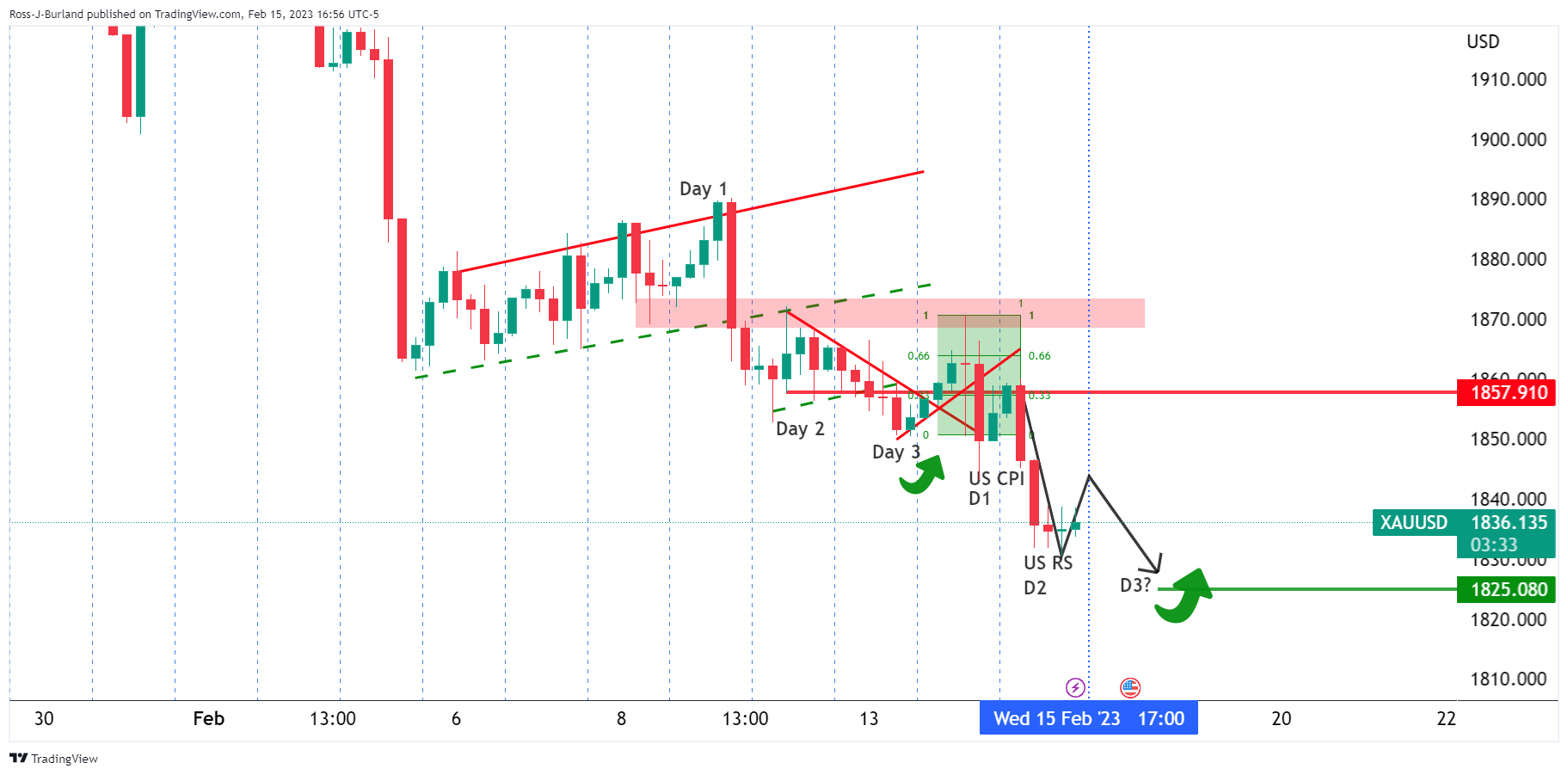- Analytics
- News and Tools
- Market News
CFD Markets News and Forecasts — 16-02-2023
- EUR/USD takes offers to refresh intraday low, prints three-day downtrend near 1.5-month low.
- ECB policymakers, monthly bulletin hesitate over further rate hikes.
- Strong US data, yields allow Fed talks to propel policy pivot rate.
- Geopolitical fears, light calendar ahead of next week’s FOMC Minutes keep bears in the driver’s seat.
EUR/USD renews intraday low around 1.0660 as bears cheer a three-day losing streak at the lowest levels since early January. In doing so, the major currency pair justifies the broad US Dollar gains.
That said, the major currency pair’s latest weakness could be linked to the firmer US data that allows the Federal Reserve (Fed) policymakers to remain hawkish versus the European Central Bank (ECB) updates that suggest a receding urge towards the highest rate.
On Thursday, St. Louis Federal Reserve's James Bullard and Cleveland Fed President Loretta Mester were the latest to bolster the greenback while conveying their hawkish bias, backed by upbeat US data. Among them, the Fed hawk Bullard said, “Continued policy rate increases can help lock in a disinflationary trend during 2023, even with ongoing growth and strong labor markets, by keeping inflation expectations low.” Fed’s Mester, on the same line, stated that the Fed will need to go above 5% and stay there for a while. The policymaker also added that she is not ready to say if the Fed needs a bigger rate increase at the next policy meeting but said that she would not want to surprise the markets.
Talking about the data, the US Producer Price Index (PPI) for January gained major attention as it jumped the most since June with 0.7% MoM figure. Also positive was the improvement in the US Initial Jobless Claims for the week ended on February 10, 194K versus 200K expected and 195K prior. Alternatively, a slump in the Housing Starts for January and the Philadelphia Fed Manufacturing Survey for February seemed to have gained a little attention.
Considering the aforementioned catalysts, the latest FEDWATCH read from Reuters signals that the interest rate futures market shows US rates could peak close to 5.25% by July before dropping to 5.0% by the end of the year. The same signals a higher policy pivot than the 5.10% peak conveyed by the Fed in the December meeting, which in turn hints at a few more rate hikes from the Fed.
On the other hand, ECB’s monthly bulletin said, “The Governing Council's future policy rate decisions will continue to be data-dependent and follow a meeting-by-meeting approach.” The central bank’s document also stated that the survey data point to weakening global economic activity at the turn of the year, following robust growth in the third quarter of 2022.
Furthermore, ECB executive board member Fabio Panetta mentioned, “ECB should not unconditionally pre-commit to future policy moves.” On the same line, ECB Chief Economist Philip Lane said, “Calibration of the monetary policy stance needs to be regularly reviewed in line with the incoming information about underlying inflation."
On a different page, the fresh US-China tension and Russia’s refrain from stepping back when it comes to attacking Ukraine also weigh on the risk appetite and the EUR/USD prices, due to the US Dollar’s safe-haven demand.
Against this backdrop, Wall Street closed negative and the S&P 500 Futures dropped 0.25% intraday by the press time. Moving on, the US 10-year Treasury bond yields rose to the highest levels in 2023 with the latest print of 3.86% while its two-year counterpart also printed mild gains to end the day around 4.64%, making rounds to the highest levels since November 2022. The same propelled the US Dollar Index (DXY) to refresh a six-week high around 104.23 before retreating to 104.03 by Thursday’s end.
Looking forward, a lack of major data/events keeps EUR/USD grinding towards the south amid the latest hawkish bias for the Fed and strong US data.
Technical analysis
The first daily closing below the 50-day Exponential Moving Average (EMA), around 1.06860 by the press time, since early November 2022 directs EUR/USD toward a 10-week-old ascending support line, close to 1.0620 at the latest.
- AUD/USD holds lower ground near the six-week bottom, prints three-day downtrend.
- RBA’s Lowe, Elis fail to renew hawkish bias despite signaling higher rates, inflation fear.
- Strong US data propels US Treasury bond yields and the US Dollar to weigh on Aussie price.
- Risk catalysts are important for fresh impulse amid light calendar.
AUD/USD takes offers to refresh intraday bottom around 0.6870 as it prints a three-day losing streak following a failed recovery from the six-week low. In doing so, the Aussie pair takes clues from the hawkish Fed bets while hesitating in praising Reserve Bank of Australia (RBA) Governor Philip Lowe’s readiness for higher rates. It’s worth noting that the job market fears signaled by RBA Assistant Governor (Economic) Luci Ellis exert additional downside pressure on the Aussie pair.
“High inflation is damaging and corrosive,” said Reserve Bank of Australia (RBA) Governor Philip Lowe in his Testimony to the House Economics Committee early Friday in Asia. The policymaker also stated, “We are not done yet on rates”.
Following that, RBA’s Ellis said that the labor market is a little less tight than a few months ago. “Exceptionally huge number of people are awaiting new jobs,” added RBA’s Ellis.
On a different page, Federal Reserve (Fed) officials were quite hawkish and backed by the strong US data to propel the US Dollar, as well as weigh on the AUD/USD price. Among them, St. Louis Federal Reserve's James Bullard and Cleveland Fed President Loretta Mester were the latest to bolster the greenback.
The Fed hawk Bullard said, “Continued policy rate increases can help lock in a disinflationary trend during 2023, even with ongoing growth and strong labor markets, by keeping inflation expectations low.” Fed’s Mester, on the same line, stated that the Fed will need to go above 5% and stay there for a while. The policymaker also added that she is not ready to say if the Fed needs a bigger rate increase at the next policy meeting but said that she would not want to surprise the markets.
US data have recently pushed back the calls for the Federal Reserve’s (Fed) policy pivot. That said, the latest FEDWATCH read from Reuters signals that the interest rate futures market shows US rates could peak close to 5.25% by July before dropping to 5.0% by the end of the year.
Out of the latest US statistics, Producer Price Index (PPI) for January gained major attention as it jumped the most since June with 0.7% MoM figure. Also positive was the improvement in the US Initial Jobless Claims for the week ended on February 10, 194K versus 200K expected and 195K prior. Alternatively, a slump in the Housing Starts for January and the Philadelphia Fed Manufacturing Survey for February seemed to have gained a little attention.
Elsewhere, US President Joe Biden fired shots at his Chinese counterpart while conveying the expectations for a talk with the Chinese leader, during an interview with NBC News. “I think the last thing that Xi wants is to fundamentally rip the relationship with the United States and with me," said US President Biden per Reuters. The same weighs on the market sentiment and the AUD/USD price.
Amid these plays, Wall Street closed negative and the S&P 500 Futures dropped 0.30% intraday by the press time. It should be noted that the US 10-year Treasury bond yields rose to the highest levels in 2023 with the latest print of 3.86% while its two-year counterpart also printed mild gains to end the day around 4.64%, making rounds to the highest levels since November 2022. With this, the US Dollar Index (DXY) refreshed a six-week high around 104.23 before retreating to 104.03 by Thursday’s end.
Moving on, a lack of major data/events joins the risk-off mood and hawkish Fed bets to keep the AUD/USD bears hopeful.
Technical analysis
A daily closing below the 50-DMA, around 0.6885 by the press time, directs AUD/USD price towards the 200-DMA key support surrounding the 0.6800 round figure, backed by bearish MACD signals and an absence of oversold RSI (14).
- After facing solid resistance at a confluence of EMAs, the GBP/JPY it slid 0.51% on Thursday.
- GBP/JPY: For a bearish resumption, a break below 160.00 is needed; otherwise, buyers would remain hopeful of testing 161.00.
The GBP/JPY slides, after hitting the year-to-date (YTD) high at 162.17, retraces and breaks crucial support levels during the last couple of days as bears drive the GBP/JPY pair toward the 160 handle. At the time of writing, the GBP/JPY exchanges hand at 160.59 as Friday’s Asian Pacific session begins.
Long-term, the GBP/JPY daily chart indicates the pair is neutrally biased after facing a solid resistance area, with the 50, 200, and 100-day Exponential Moving Averages (EMAs), each at 160.83, 161.79, and 161.95, respectively. However, buyers could not hold the GBP/JPY prices at around the previously mentioned EMAs, which opened the door for further losses.
The Relative Strength Index (RSI) shifted course, and after peaking at 58, its slope turned south, while the Rate of Change (RoC) shows that sellers moved in as the GBP/JPY dived towards the 160.60 area.
For a bearish resumption, the GBP/JPY first support will be the psychological 160.00 figure. A breach of the latter will expose the 20-day EMA at 159.97, followed by the 159.00 figure and the February 13 swing low at 158.18.
As an alternate scenario, if the GBP/JPY pair edges north and reclaims the 50-day EMA at 160.83, that would pave the way for testing the 161.00 mark. Once cleared, that will expose the 200 and 100-day EMAs on the GBP/JPY way towards 162.00.
GBP/JPY Daily chart
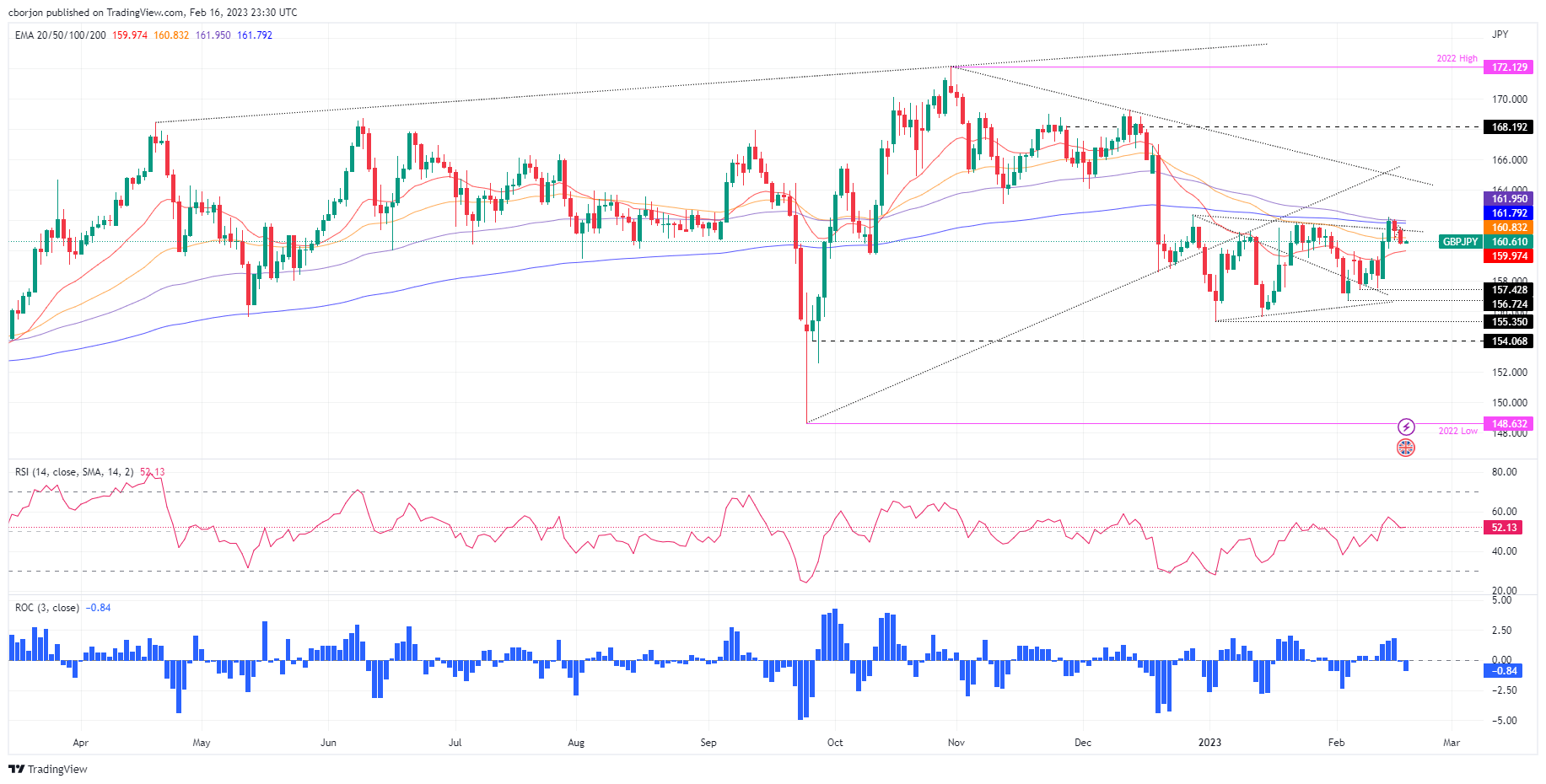
GBP/JPY Key technical levels
Following this week's disappointments in the labour market data, traders are timing into Australia's top central bankers on Friday who are crossing the wires currently.
Reserve Bank of Australia (RBA) Governor Philip Lowe said further increases in interest rates would be needed in the months ahead to ensure sky-high inflation returns to the target range.
Speaking before lawmakers, he said how much further interest rates need to increase would depend on developments in the global economy, how household spending evolves and the outlook for inflation and the labour market.
Key comments
We are not done yet on rates.
The labour market is still very tight.
Could see additional 50,000-70,000 jobs come through data in next month or so.
If we saw another weak jobs report might reconsider if labour market still tight.
RBA's Ellis said more people than usual took leave in January and unusually large numbers waiting to start new job.
More to come..
“Floating Canadian Dollar gives the bank the flexibility to chart a different path than trading partners and focus on setting interest rates,” said Bank of Canada Deputy Governor Paul Beaudry on Thursday per Reuters.
More to come
- Gold Price holds lower ground at 1.5-month low, eyed third weekly loss.
- United States Producer Price Index (PPI) bolsters hawkish Federal Reserve bets and fuels US Treasury bond yields, US Dollar.
- Mixed updates on major XAU/USD consumers, US-China tension adds to the downside pressure.
- No major data/events ahead of next week’s Fed Minutes.
Gold price (XAU/USD) braces for the third consecutive weekly loss as it holds lower grounds near $1,835 during early Friday morning. The major catalyst for the yellow metal’s latest losses could be linked to the United States economics which renew hawkish bias for the Federal Reserve (Fed). Also weighing on the XAU/USD could be the headlines surrounding India and China, as well as a lack of major data/events ahead of the next week’s Minutes of the latest Federal Open Market Committee (FOMC) monetary policy meeting.
United States data weigh on Gold price
Upbeat statistics from the United States have recently pushed back the calls for the Federal Reserve’s (Fed) policy pivot. That said, the latest FEDWATCH read from Reuters signals that the interest rate futures market shows US rates could peak close to 5.25% by July before dropping to 5.0% by the end of the year. The same allows the US Treasury bond yields and the US Dollar to remain firmer and weigh on the Gold price.
Among the latest US data, Producer Price Index (PPI) for January gained major attention as it jumped the most since June with 0.7% MoM figure. Also positive was the improvement in the US Initial Jobless Claims for the week ended on February 10, 194K versus 200K expected and 195K prior. Alternatively, a slump in the Housing Starts for January and the Philadelphia Fed Manufacturing Survey for February seemed to have put a floor under the Gold price.
That said, the US 10-year Treasury bond yields rose to the highest levels in 2023 with the latest print of 3.86% while its two-year counterpart also printed mild gains to end the day around 4.64%, making rounds to the highest levels since November 2022. With this, the US Dollar Index (DXY) refreshed a six-week high around 104.23 before retreating to 104.03 by the day’s end.
XAU/USD bears cheer India, China news
Other than the Federal Reserve concerns, the mixed headlines surrounding the Gold imports from India and China, as well as the latest geopolitical tension between the US and China, also seems to weigh on the XAU/USD price. It should be noted that India and China are the world’s leading Gold consumers.
As per the latest World Gold Council (WGC) data, China's Gold imports increased by 64% year-on-year last year, totaling up to 1,343 mt of gold, the highest level since 2018.
On the other hand, Reuters quoted an anonymous source on Thursday to mention that India's Gold imports plunged 76% in January from a year earlier to a 32-month low, as record high domestic prices dented physical demand.
Elsewhere, US President Joe Biden fired shots at his Chinese counterpart while conveying the expectations for a talk with the Chinese leader, during an interview with NBC News. “I think the last thing that Xi wants is to fundamentally rip the relationship with the United States and with me," said US President Biden per Reuters.
Smooth run for Gold sellers ahead of Federal Reserve Minutes
Apart from what’s already mentioned above, a lack of major data and events ahead of the next week’s Monetary Policy Meeting Minutes for the Federal Open Market Committee’s (FOMC) latest action also seems to keep the Gold bears on the driver’s seat. The reason could be linked to the majority of the US data that has put a floor under the hawkish Fed expectations.
Gold price technical analysis
Gold price remains depressed below a two-week-old descending trend line, previous support, as well as a downward-sloping resistance line from February 02. Adding strength to the downside is the metal’s sustained trading below the 200-bar Simple Moving Average (SMA).
It’s worth noting that the sluggish signals from the Moving Average Convergence and Divergence (MACD) indicator join the downbeat Relative Strength Index (RSI) line, placed at 14, to suggest a slower grind toward the south.
With this, the Gold price decline towards two-month-old horizontal support, near $1,820 by the press time, appears imminent. However, the quote’s further downside will need a strong catalyst to break the stated key support and aim for the $1,800 threshold.
Alternatively, a convergence of the aforementioned support-turned-resistance and an 11-day-old descending trend line offers strong resistance to the Gold price around $1,845, a break of which could allow the XAU/USD to pare recent losses and challenge the 200-SMA level of near $1,892.
In a case where the Gold price remains firmer past $1,892, the $1,900 threshold will be important to watch for further guidance.
Gold price: Four-hour chart

Trend: Further downside expected
- USD/CHF is subdued but looms around the 50-day EMA, at around 0.9282.
- In the short term, the USD/CHF is range-though slightly tilted upwards, and it might rise to 0.9300.
USD/CHF edges higher above the 20-day Exponential Moving Average (EMA) at 0.9221 and is threatening to register a daily close above Wednesday’s high of 0.9262, cementing a bullish continuation in the USD/CHF. At the time of typing, the USD/CHF is trading at 0.9256 after hitting a daily low of 0.9213.
As the Asian session begins, the USD/CHF daily chart depicts the pair distanced from the 20-day EMA and threatened to break the 50-day Exponential Moving Average (EMA) at 0.9282, though it fell short and retraced. Traders should be aware that the Relative Strength Index (RSI) shifted to bullish territory, but it’s flat, meaning buyers are getting a respite before launching an assault on the 50-day EMA. As an alternate scenario, If the USD/CHF tumbles below the 20-day EMA at 0.9221, that would expose the 0.9200 figure, followed by the current week low of 0.9139.
On an intraday time frame, the USD/CHF 4-Hour chart suggests the pair is sideways, within the 0.9160/0.9260 range, but the jump from YTD lows at around 0.9059 opened the door for further upside.
A breach of 0.9260 will expose the 0.9300 figure, which would be up for grabs. A move upward and January 12 at 0.9360 would be the bears’ next line of defense, followed by the psychological 0.9400 mark.
On the downside, sellers need to break below the 200-EMA at 0.9242. Once done, the confluence of the 20/50 EMA around 0.9220/30 would be tested ahead of 0.9200.
USD/CHF 4-Hour chart
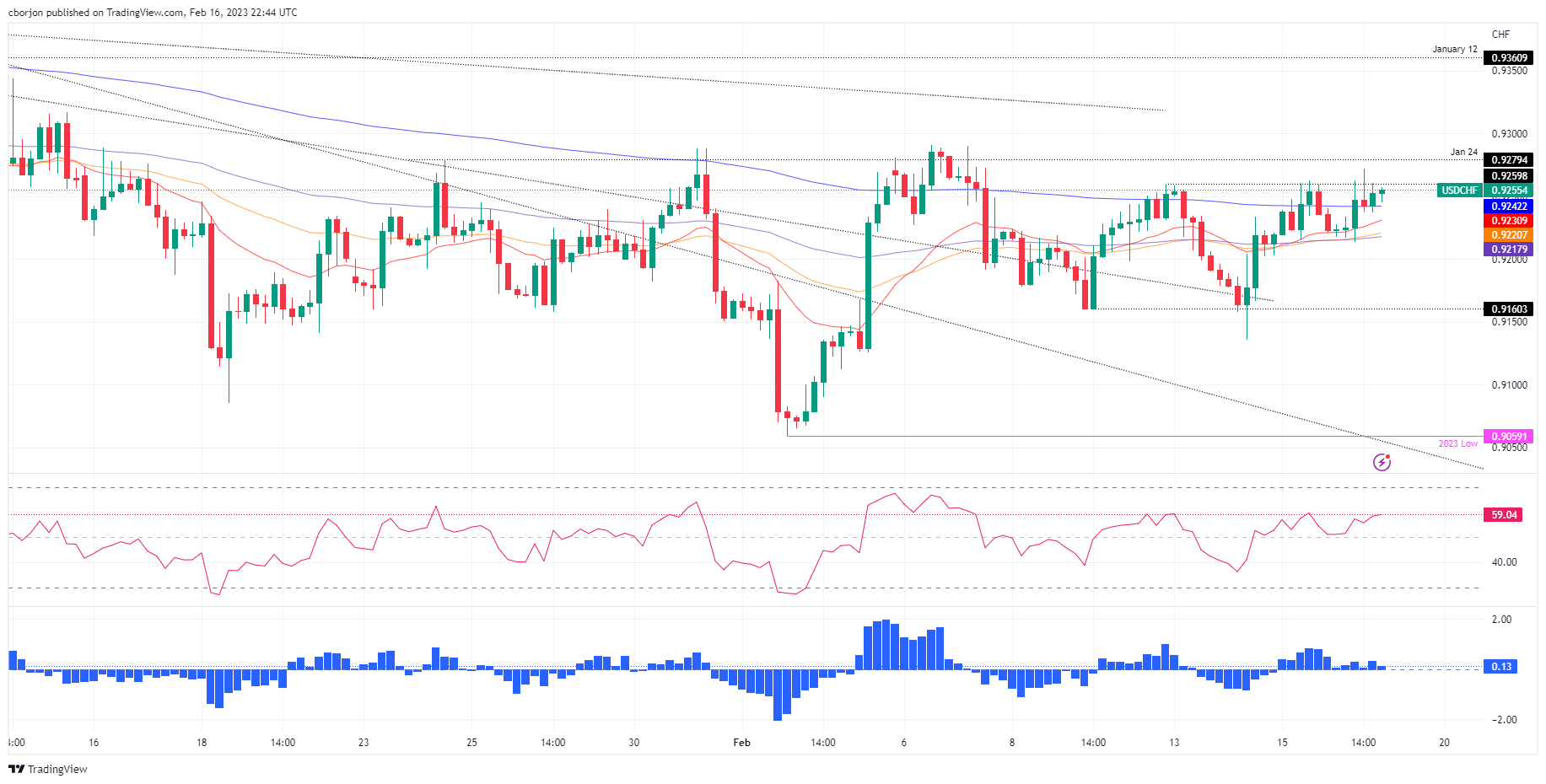
USD/CHF Key technical levels
“High inflation is damaging and corrosive,” said Reserve Bank of Australia (RBA) Governor Philip Lowe in his Testimony to the House Economics Committee.
Additional comments
Will do what is necessary to make sure that inflation returns to the target range.
It would be dangerous, indeed, not to contain and reverse this period of high inflation.
Based on the currently available information, the board expects that further increases will be needed over the months ahead.
How much further interest rates need to increase will depend on developments in the global economy, how household spending evolves and the outlook for inflation and the labour market.
Path here is a narrow one.
It is important that people expect that the high inflation is only temporary.
One is the risk of not doing enough, which would result in high inflation persisting and then later proving very costly to get down. The other is the risk that we move too fast, or too far.
Inflation expectations remain well anchored and aggregate wage outcomes are not inconsistent with inflation returning to target.
It is still possible for us here in Australia to navigate this path.
But it is also possible that we are knocked off that narrow path.
Very conscious that the impact of higher rates is being felt very unevenly across the community.
AUD/USD stays pressured below 0.6900
AUD/USD pays a little heed to the macro as RBA’s Lowe refrains from any fresh signals from what he already spoke in the first round of the testimony. That said, the Aussie pair remains depressed near 0.6875, after declining to a six-week low the previous day.
Also read: AUD/USD Price Analysis: Bears and bulls about to standoff at key 0.6850s
President Biden said that early indications show the three objects downed over North American airspace in the past week were privately-owned balloons and were not conducting surveillance, BBC reported.
''It follows White House spokesman John Kirby's comments on Tuesday that the objects were likely “tied to some commercial or benign purpose".
The trio of objects were much smaller than the alleged Chinese spy balloon, but officials said they were flying at an altitude that posed a threat to commercial airlines as a justification for shooting them down.''
Biden also said, ''I believe the last thing xi wants is to fundamentally rip the relationship with the US and with me,'' in an NBC news interview.''
- AUD/USD bears are coming in form the resistance in the hour time frame.
- Bulls are lurking below the lows and eye an opportunity to balance the books.
AUD/USD has stalled on the bid and has been making tracks to the downside in the last couple of hours in the hunt for territory below 0.685o lows. The pair needs to get below there or face immediate p[pressures to the upside for the bulls searching for money above 0.6920. The following illustrates the market structure and the developments over the course of this week's template and arrives at a semi-bullish bias for the end of the week.
AUD/USD H1 chart
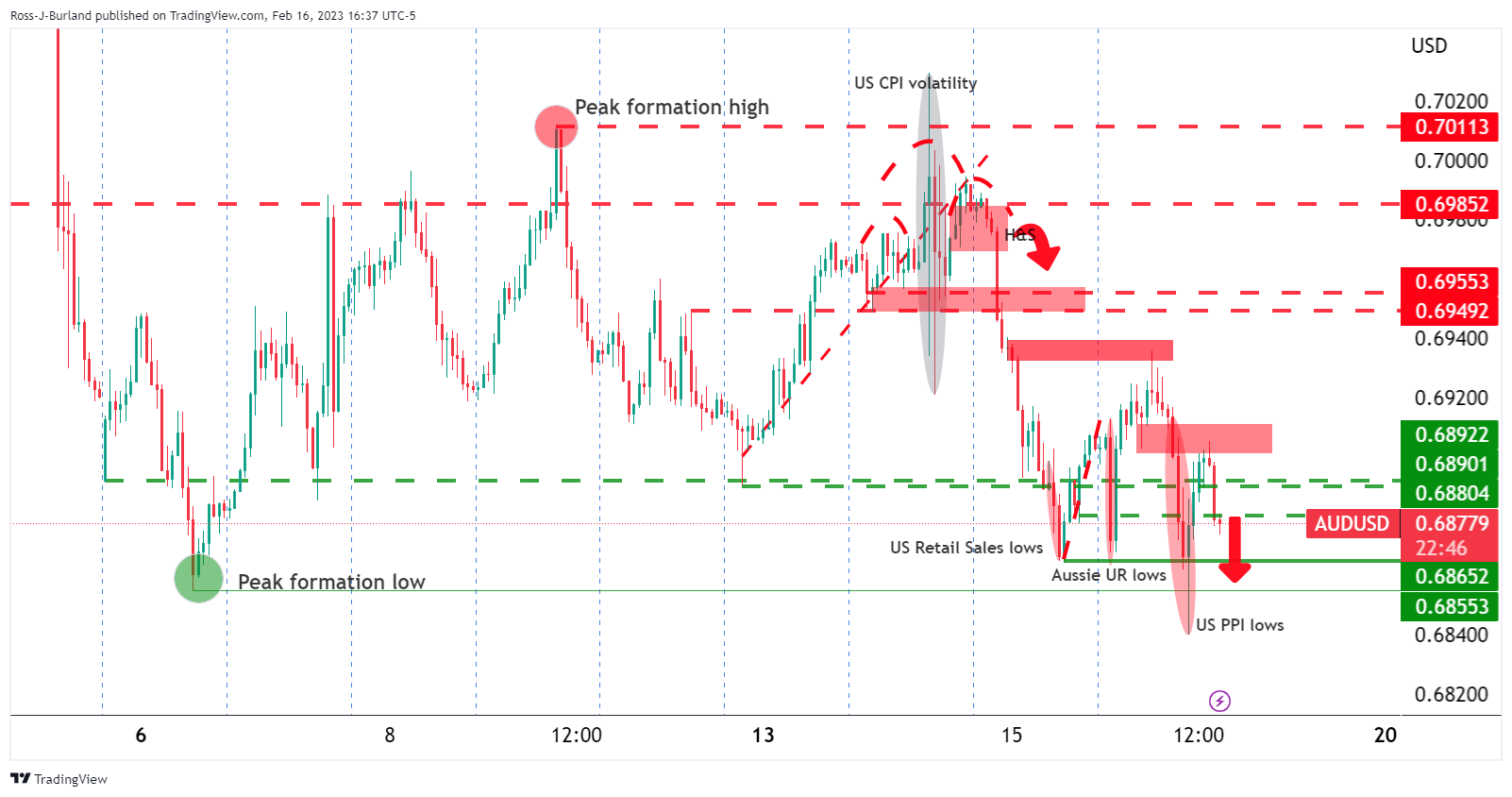
AUD/USD has been in the hands of the bears throughout the course of this week with 0.6850 standing in the way of the final push lower. However, given the build-up of shorts, this could be an overstretched position in the spot market and it might warrant a sizeable correction to balance the books into the weekend:
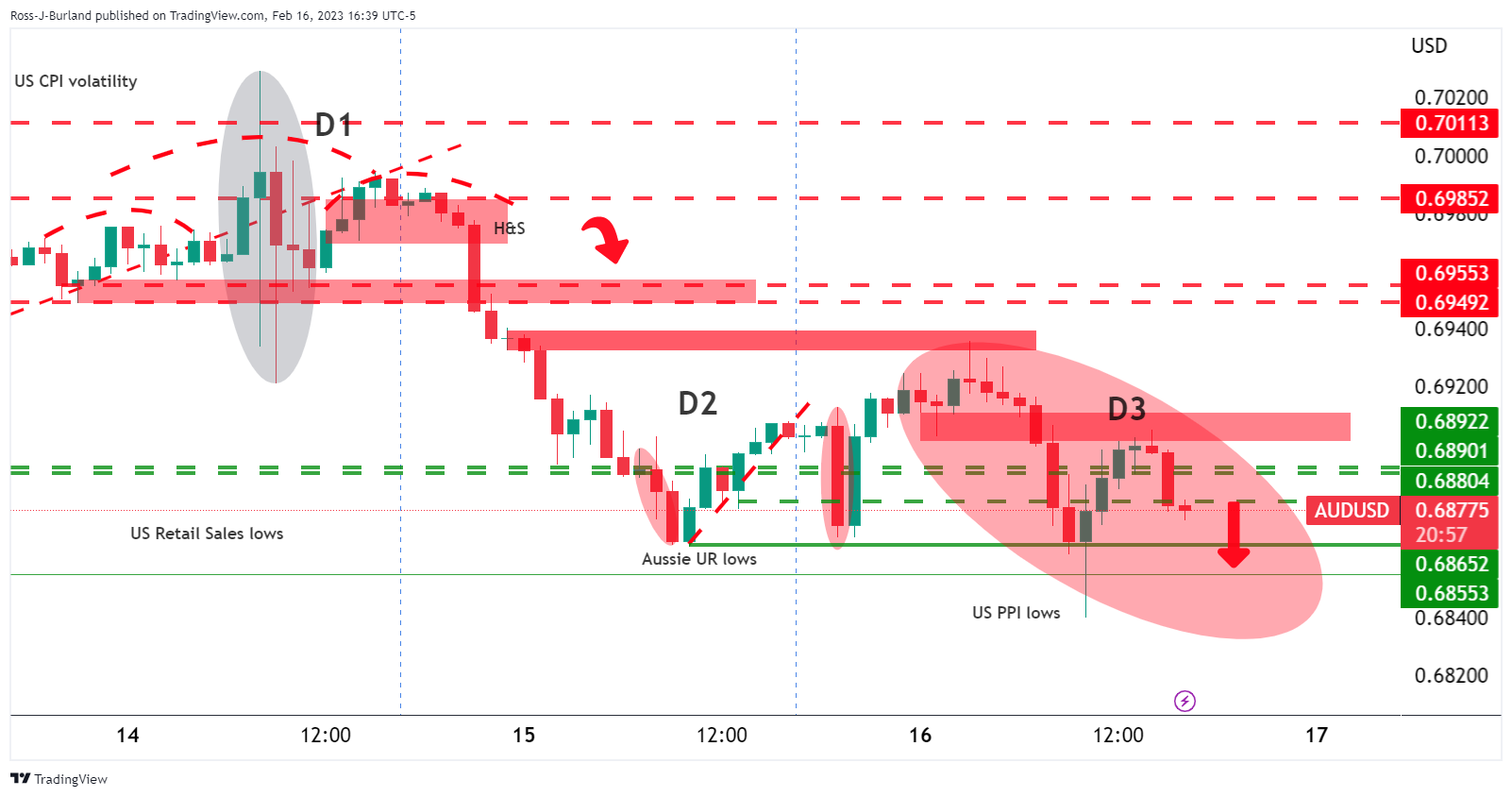
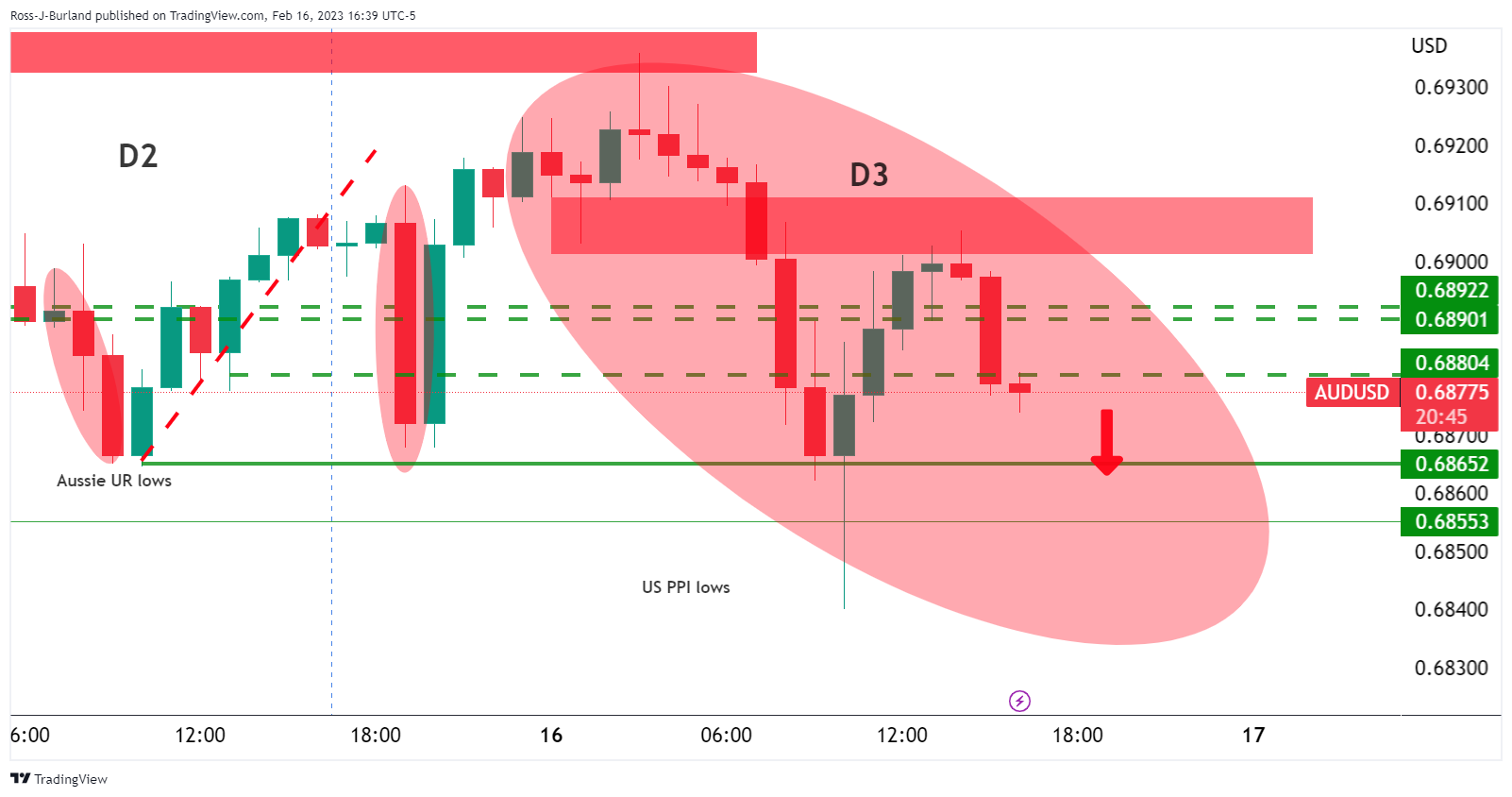

- NZD/USD creeps below the 0.6260 area after US data showed that inflation is still looming.
- The US Producer Price Index rose above estimates as inflationary pressures reignited.
- NZD/USD Price Analysis: To resume its downtrend, with a daily close below the 100-DMA; otherwise, a test of 0.6300 is on the cards.
The NZD/USD extends its losses, though trimmed some after hitting a year-to-date (YTD) low of 0.6232, on the back of US data showing that inflationary pressures remain. Hence, speculators had begun to push back rate cuts foreseen by the end of 2023 as they began to price-in higher rates. At the time of writing, the NZD/USD exchanges hands at 0.6260.
High US bond yields underpin the US Dollar after strong US data
Economic data revealed in the United States (US) keep investors nervous, as shown by Wall Street, set to finish with losses. The Producer Price Index (PPI) for January on a monthly basis, came higher-than-expected, in headline PPI and core PPI, with readings at 0.7% and 0.4%, respectively. Echoing some of the inflationary pressures witnessed in the Bureau of Labor Statistics (BLS) data, the Philadelphia Fed Manufacturing Index plummeted severely to -24.3 from -7.4 estimates, underscoring higher input prices after ten straight months of lower printings.
Once data hit the screens, the NZD/USD tumbled and reached a new daily low of 0.6232, before reversing its course, influenced by US Dollar (USD) strength. US Treasury bond yields climbed as traders began to price in no cuts by the Federal Reserve (Fed) in 2023, after CPI and PPI data showed a slight uptick in inflation.
On the New Zealand front, the impact of cyclone Gabrielle would impact the country’s economy, as its damages are pending to be quantified. According to ANZ analysts, “there will be cost pressures as a result of the cyclone. Construction costs, rents, insurance, the cost of food (and many other costs) are likely to face further upwards pressure. There is not much monetary policy can do to help in an event like this – that is best managed through fiscal policy which is faster acting and more targeted. Although the impact of the cyclone is considered inflationary, we expect the RBNZ will lift the OCR 50bp this week, rather than the 75bp they signalled in November.”
NZD/USD Technical analysis
Once the NZD/USD edged below the 200 and 100-day Exponential Moving Averages (EMAs), each at 0.6289 and 0.6263, exposed the pair to sellers. Nevertheless, failure to crack below the 0.6230 area keeps investors hopeful that the bounce could open the door to reclaim the previously-mentioned long-term moving averages. If that scenario plays out, the NZD/USD could rally towards 0.6300 after regaining the 0.6260/90 area. Otherwise, the NZD/USD pair would resume its bearish continuation toward the 0.6200 area.
- EUR/USD bears are staying the course as bullish attempts are faded at resistance.
- Bears eye the 1.0650s for the ending sessions of the week.
EUR/USD bulls have come up for air near 1.0700 to a US session high of 1.0697 to meet resistance, both horizontal and dynamic. The US Dollar came under pressure again despite a slew of inflationary data over the last several days and the EUR/USD bears are out in force:
EUR/USD H1 chart
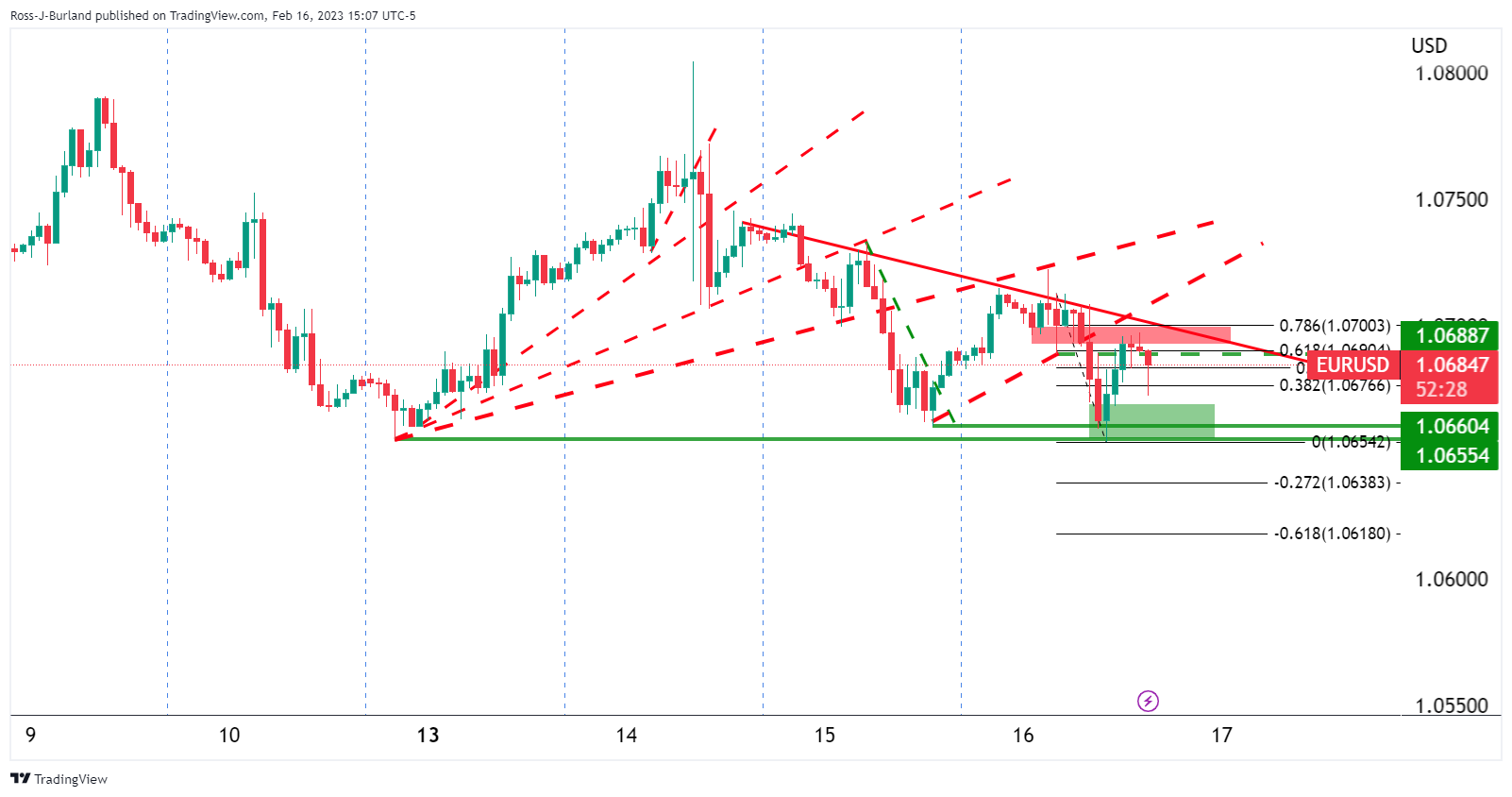
EUR/USD has broken through numerous supports casting a bearish shadow in its tracks that leaves scope for a downside continuation should the 1.0650s give out in the forthcoming days. We have seen a move up into the third day of shorts and a positive close on Thursday will give rise to the prospects of a deeper correction of the recent bearish run.
However, a late session surge from the bears is underway and that could leave prospects of a bearish close for another day and the downside bias underpinned:
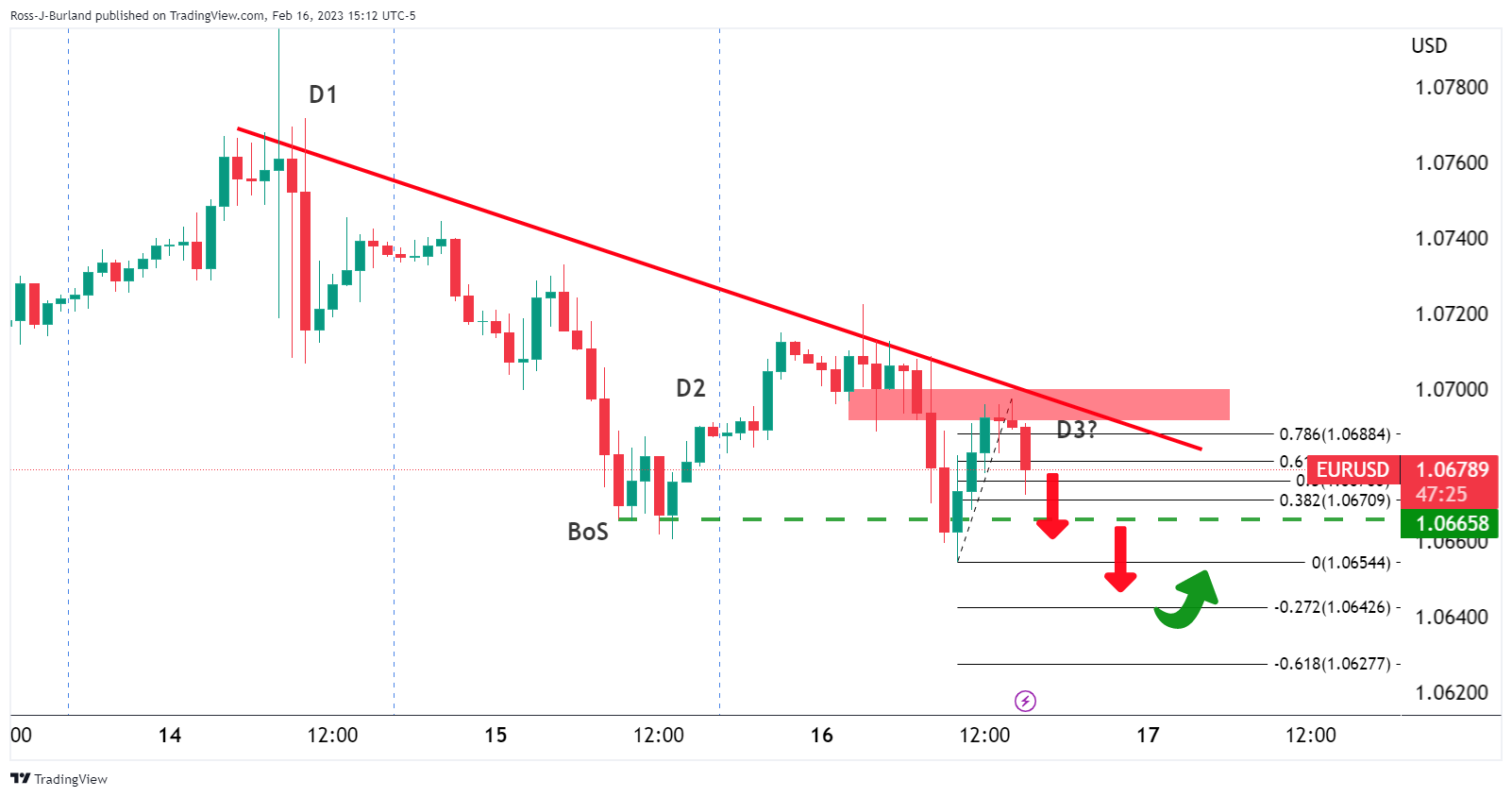
As illustrated, there have been three days of shorts, old and new, with the latest coming in the last hours on Wall Street.1.0650 is on the bear's radar but given the build-up of shorts, a big squeeze could come into play to end the week and to balance the books:

What you need to take care of on Friday, February 17:
US Dollar reached fresh weekly peaks against most major rivals, giving back some ground ahead of the Wall Street close as US indexes bounced from their early lows. The catalyst came from the US Producer Price Index (PPI), up 6% YoY in January, down from 6.5% in December, but above the 5.4% forecast. The figures revived speculation the US Federal Reserve will maintain the pace of tightening for more than anticipated while a pivot in monetary policy moved further away.
Stocks came under intense selling pressure, although Wall Street trimmed most of its intraday losses ahead of the close. US government bond yields, on the other hand, advanced, with the 10-year note now offering 3.83% and the 2-year note paying 4.61%.
The EUR/USD pair trades a handful of pips below 1.0700, while GBP/USD hovers around 1.2010.
European Central Bank Executive Board member Fabio Panetta said raising borrowing costs in small increments would allow a better monetary policy adjustment as previous tightening has started to put a brake on economic activity.
According to the Federal Reserve Bank of Atlanta's GDPNow model, the US economy is expected to grow at an annualized rate of 2.5% in the first quarter, up from 2.4% in the previous estimate.
Bank of Canada Governor Tiff Macklem said he expects CPI inflation to fall to around 3% in the middle of this year and reach the 2% target in 2024. However, he added, "if evidence begins to accumulate to show that inflation is not declining in line with forecast, we are prepared to raise policy rate further." USD/CAD trades at around 1.3420.
AUD/USD battles to regain the 0.6900 threshold after falling to a fresh monthly low on the back of soft Australian employment data and the sour tone of equities.
USD/JPY topped 134.45 with US yields intraday peaks, now down to 133.80.
XAU/USD fell to $1,827.58 a troy ounce, its lowest since early January. It currently hovers at around $1,842, helped by receding risk aversion. Crude oil prices remained stable, with WTI changing hands at $78.45 a barrel.
Bitcoin price could run up to $41,000 over the next month if it follows this pattern
Like this article? Help us with some feedback by answering this survey:
There is growing speculation that a deal between the UK and EU on the Northern Ireland Protocol is imminent.
the BBC reported that Mr Sunak last visited Northern Ireland in December when he met the parties to discuss the controversial post-Brexit trade arrangements for the region.
''It is understood that the prime minister will speak to the main political parties again on Friday.''
His spokesperson said:
"Whilst talks with the EU are ongoing ministers continue to engage with relevant stakeholders to ensure any solution fixes the practical problems on the ground, meets our overarching objectives and safeguards Northern Ireland's place in the UK's internal market. The prime minister... [is] travelling to Northern Ireland this evening to speak to political parties as part of this engagement process."
The BBC said ''the suggestions are that if the UK and the EU can get all of their T's crossed and their I's dotted a deal on the Northern Ireland Protocol might be done early next week.;;
EUR/GBP update
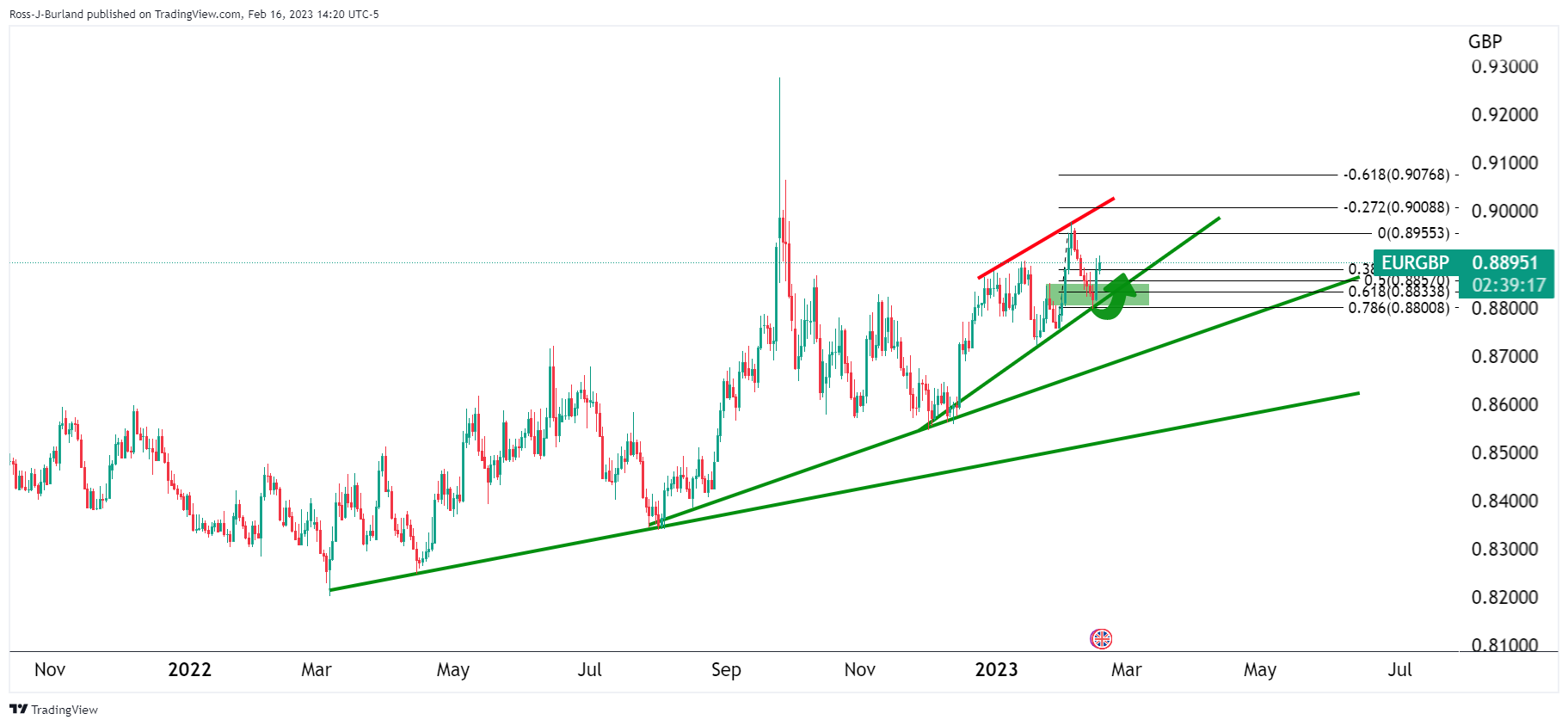
The Euro has been a better performer of late and has travelled higher vs. the Pound towards the 0.90 area. so far, support is holding and the bulls have reemerged within the ascending channel.
- Silver price stopped its fall but remains shy of reclaiming the 200-EMA.
- A third daily close below the 200-day EMA will cement Sllver's price downward bias.
- Silver Price Analysis: Break below $21.40 would expose the $21.00 mark.
Silver price attempts to recover the 200-day Exponential Moving Average (EMA) but stays shy of reclaiming the $21.94 price level, which would underpin the XAG/USD towards the psychological $22.00 mark. Nevertheless, the Silver price registers gains, and the XAG/USD is trading at $21.71 after hitting a daily low of $21.44.
Once the XAG/USD extended its losses beyond the 200-day EMA, sellers faced difficulties dragging prices below the weekly low of $21.43. The Relative Strength Index (RSI) is in bearish territory but turned flat, meaning bears are getting a respite before re-attempting to drive prices toward the November 28 low at $20.87.
In the short term, the XAG/USD 1-hour chart suggests the pair is sideways. Even though the white metal dived towards the S1 daily pivot at $21.40, it encountered bids and climbed back above the daily pivot at $21.64. However, failure to crack the R1 daily pivot at $21.84 would keep the daily chart bias intact.
That said, the XAG/USD first support would be the daily pivot at $21.64, followed by the S1 pivot point at 21.40. A breach of the latter and the following line of defense for Silver bulls would be the S2 daily pivot at $21.19, followed by the S2 area at $20.96.
XAG/USD 1-Hour chat
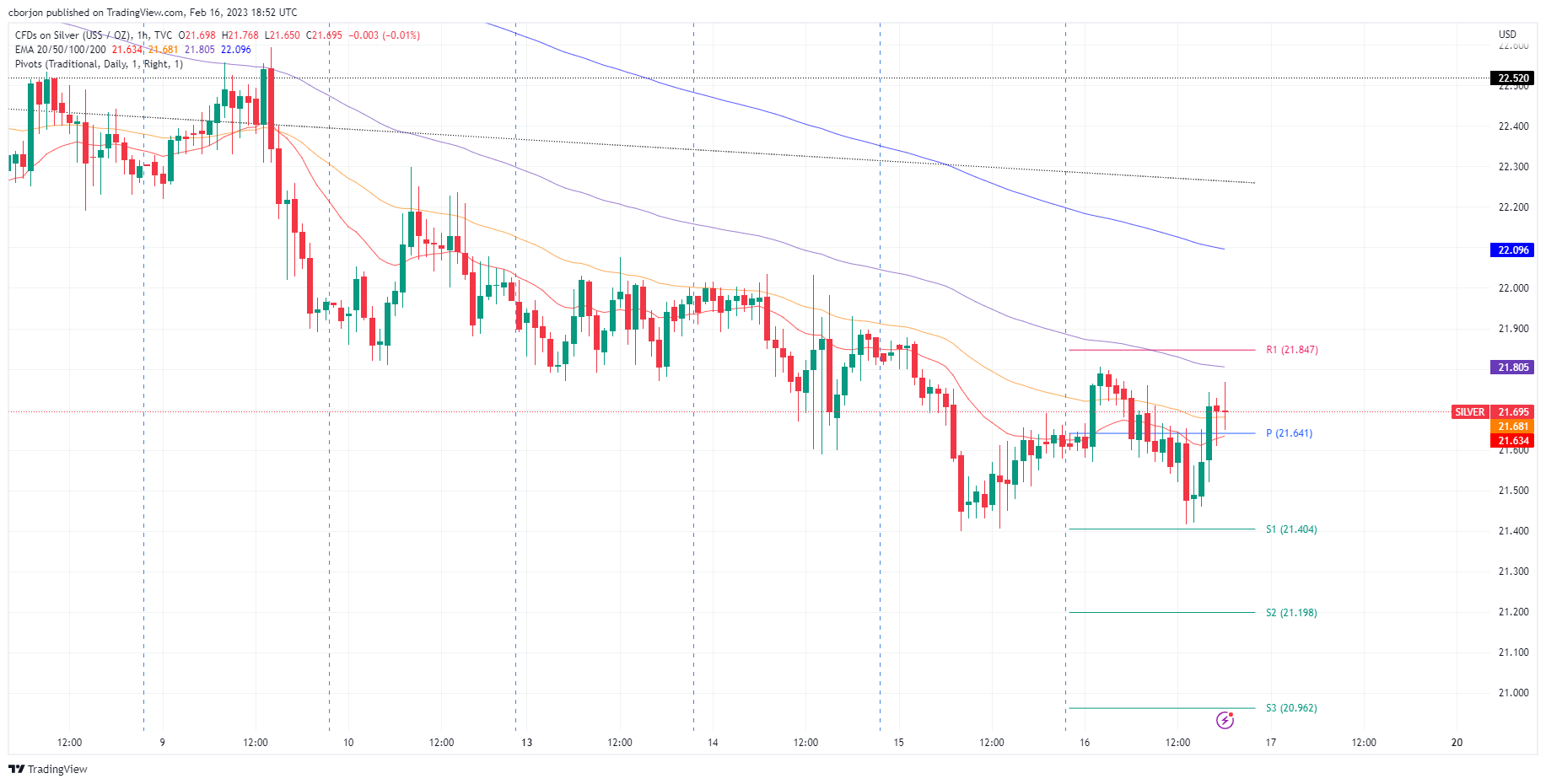
XAG/USD Key technical levels
The St. Louis Federal Reserve's James Bullard has crossed the wires and stated that the market-based expectations of inflation are "now relatively low" and that the economy is growing faster than previously thought with unemployment below the long-run rate and output above its potential.
He said inflation "remains too high" but note that it has come down recently noting that a "disinflationary" process had begun and could continue with additional Fed rate increases.
"Continued policy rate increases can help lock in a disinflationary trend during 2023, even with ongoing growth and strong labor markets, by keeping inflation expectations low."
US Dollar update
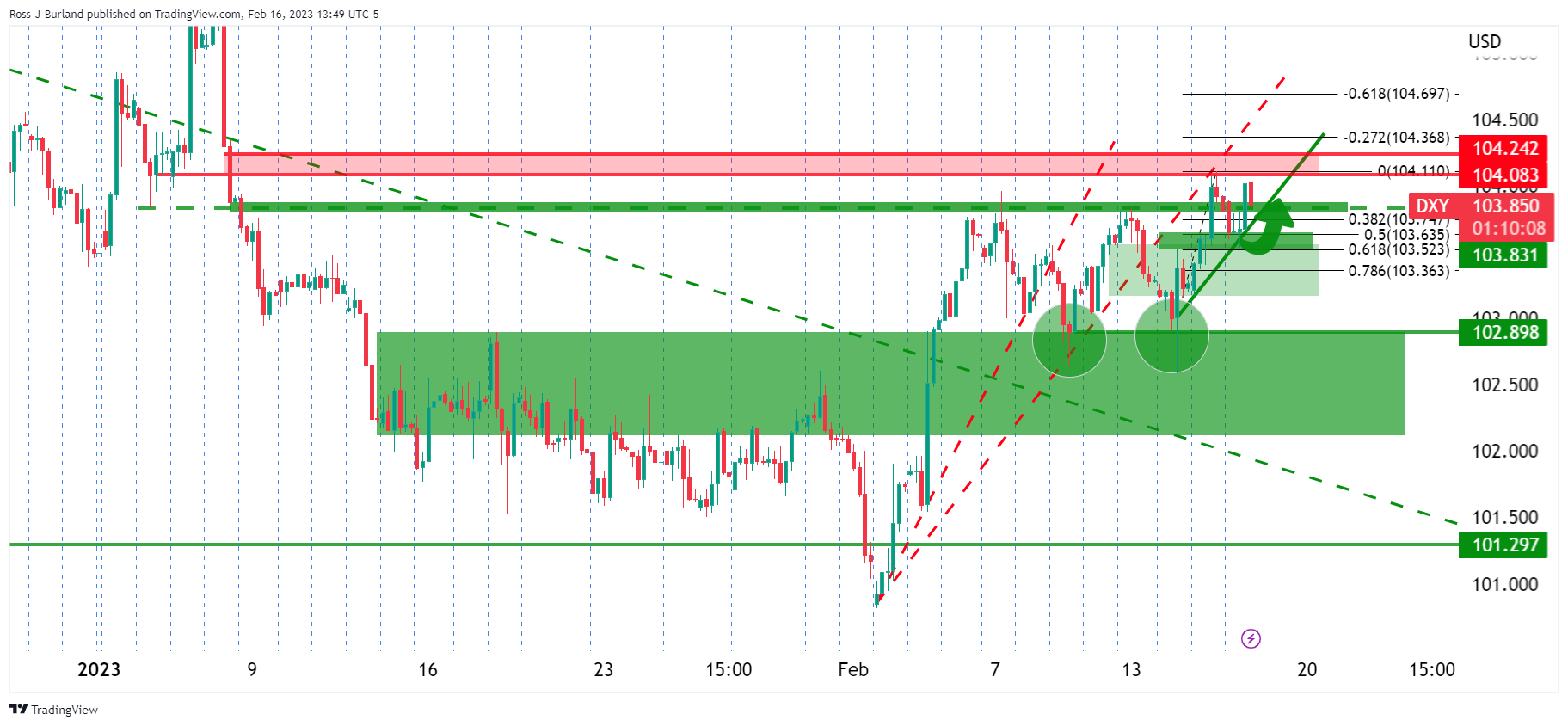
As the above analysis illustrates, the US dollar, as measured against a basket of currencies, has been breaking to the upside and out of a geometrical consolidation's top side resistance albeit on the backside of the prior bullish trends supporting lines.
It has been a slow grind higher for the US Dollar and not even firmly hawkish Federal Reserve rhetoric and data have been able to free up the bulls from the clutches o the bears. However, should the DXY close firmly above 103.65/80 this week, a case for higher could be drawn, as per the following daily chart analysis:
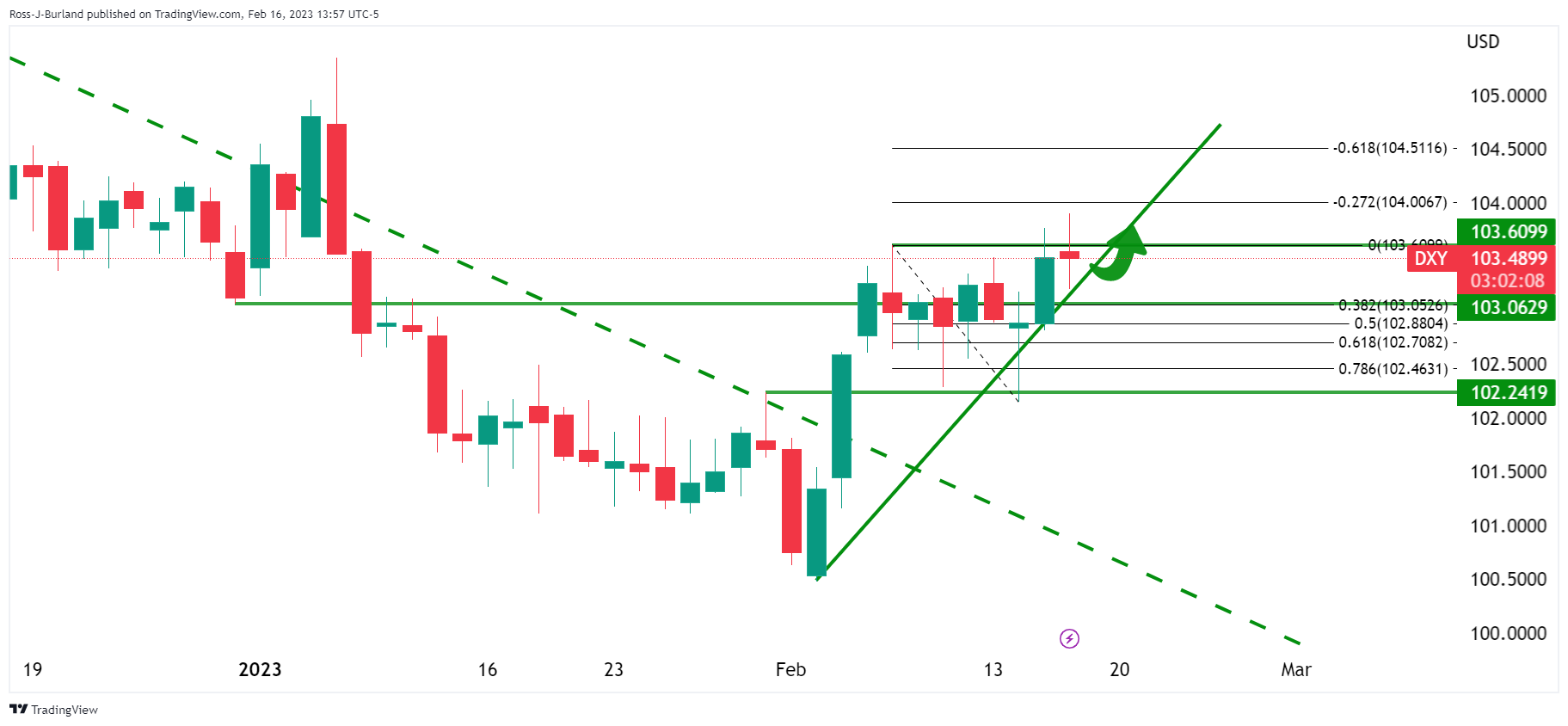
- Gold price bears came close but there was no cigar.
- The US data of late has been in contrary to the belief that the Fed is about to pivot.
- Investors could now be looking to diversify in uncertain times.
Gold price bears have been on a quest for the $1,825 target since the start of the month in anticipation of a long squeeze into higher time-frame breakout traders getting long at the break of $1,800 towards the end of 2022. In Thursday's Gold price action, fuelled by a resurgence in the US Dollar pertaining to a slew of inflationary US economic data, the bears moved in again and came in close to the $1,825 target, but there was no cigar.
At the time of writing, Gold price is trading higher by some 0.3% and close to the highs of the day ($1,844.80) near $1,842 and has rallied from the session low of $1,827.62 in a typical volatile fashion. The US Dollar is trying to claim higher grounds on the back of a fickle narrative surrounding the Federal Reserve and what the latest key data points are revealing to be sticky inflation for longer.
US data feeds the offer in Gold price
In mixed data on Thursday, the Labor Department's Producer Price Index (PPI) leapt by 0.7% in January, which was an abrupt reversal of December's 0.2% dip and well above the 0.4% consensus. Year-over-year, the measure fell in at 6%, hotter than the 5.4% projection but a cool-down from the prior (upwardly revised) 6.5% print. The core PPI measure posted a monthly increase of 0.6%, triple the December rate, and an annual increase of 4.5% - a 20 basis point drop from the previous month.
On top of that, as if any further proof was needed after the blowout January Nonfarm Payrolls report, the jobs market data again today confirmed that the labour market is still carrying plenty of momentum. The Labor Department reported that jobless claims, for the fifth straight week, came in below the 200,000 level associated with a healthy employment churn.
A day prior, the United States Retail sales jump 3% in January, smashing expectations despite an inflation increase that might have otherwise kept consumers' hands in their pockets, highlighting the strength of the economy. On Tuesday, the annual Consumer Price Index inflation rate in the US slowed slightly to 6.4% in January from 6.5% in December, the lowest since October 2021 but above market expectations of 6.2%. Last week's Services PMI data for the prior month was impressively high also.
All in all, the data comes in contrast to wheat the markets had been pricing in terms of the Federal Reserve. However, following all of this inflationary data, the whole yield curve rose, and markets have started to embrace a higher for longer sentiment as estimates are now rising that the Fed may continue to raise rates into the summer.
However, the question for market watchers is how well can the economy continue to hold up, especially as rates head much higher than many originally thought. so this might have put a meanwhile bid back into the Gold price as it steers back into shorts that have built up over the last couple of days as investors seek out diversification in their portfolios.
Gold technical analysis
In the prior analysis, Gold Price Forecast: XAU/USD bears remain keen on $1,825, the chart above highlighted the prospects of a continuation to the downside with D1 and D2 shorts in the market to trigger a third day of shorts on Thursday. This is what we got, but the $1,825 level was not quite reached.
Instead, we now have the possibility of a first green day in a series of red days and that means longs are moving in:
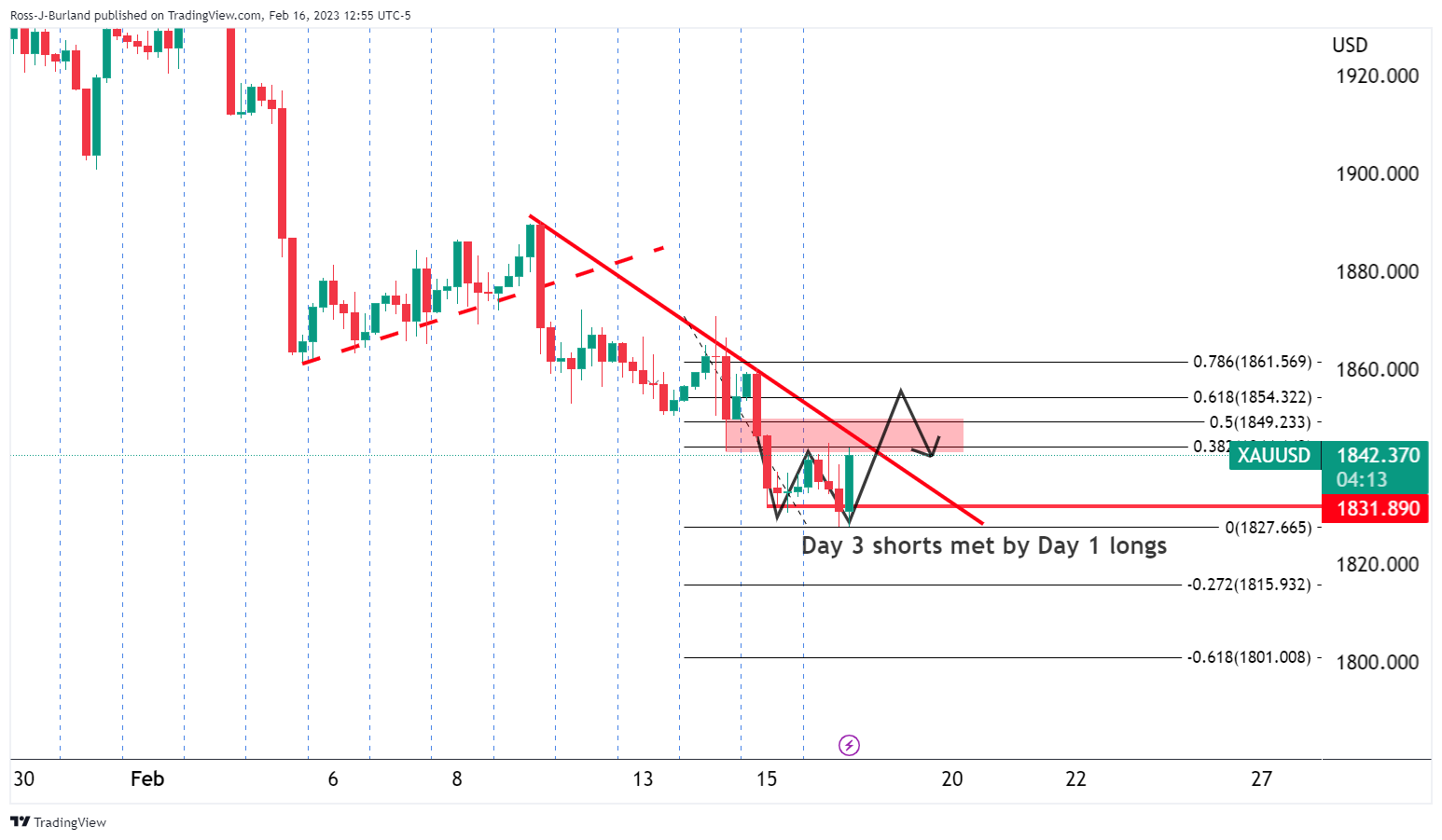
This could mean a correction of the downtrend is imminent which puts $1,854 on the map as a 61.8% Fibonacci retracement target. However, we have both dynamic trendline resistance and horizontal resistance to break first between the 38.2% Fibo and the 50% mean reversion levels around $1,850 accumulatively.
- GBP/USD is registering minuscule losses of 0.05% on Thursday.
- The jump in producer prices in the US and strong labor market data would keep the Fed tightening monetary policy.
- GBP/USD Price Analysis: Daily close below the 100-day EMA will cement the downward bias.
The GBP/USD is subdued in the mid-North American session spurred by a jump in producer inflation in the United States (US). In contrast, Wednesday’s UK inflation data weakened the Pound Sterling (GBP) as inflation slowed. Hence, the GBP/USD is trading around the 1.2000/15 range, below its opening price.
The US PPI uptick and the tight labor market are likely to pressure the Federal Reserve
The US Bureau of Labor Statistics (BLS) revealed that the Producer Price Index in January increased by 0.7% from December, which was higher than the expected jump of 0.4%. Excluding items prone to rapid price changes, the so-called core PPI rose by 0.5% vs. an estimated increase of 0.3%. Although the year-over-year data was lower than the previous month, the monthly figures indicate that inflation is persistently high and may require additional actions by the Federal Reserve to address it.
Following the data release, the GBP/USD slid from around the daily pivot point at 1.2060 and dropped towards the 1.1978 area before reclaiming the 1.2000 figure.
At the same time, Initial Jobless Claims for the week ending on February 11 came at 194K, beneath the prior reading of 196K, and showed the labor market’s resilience. Albeit high-tech companies announced layoffs, unemployment claims lower reads would pressure the Federal Reserve, and it might open the door for additional tightening than foreseen.
In the meantime, the Philadelphia Fed Manufacturing Index plunged sharply to -24.3 vs. -7.4 estimates by analysts. The poll delivered comments by producers which said that input prices are rising after ten months of cooling down.
Across the pond, a softer Consumer Price Index (CPI) in the UK, down to 10.1% from 10.5% in December, on an annual basis. UK bond yields eased after the data release as a reflection that the Bank of England (BoE) would not need to tighten monetary conditions aggressively.
Given the backdrop, the GBP/USD might extend its losses due to recent data in the United States (US), which would trigger a reaction by the Fed. Money market futures expect at least two 25 bps interest rate increases, which will lift the Federal Funds Rate (FFR) to the 5-5.25% range. That said, further GBP/USD downside is expected, with sellers already dragging prices below the 20, 50, and 100-day Exponential Moving Averages (EMAs).
GBP/USD Technical analysis
The GBP/USD daily chart portrays the pair as neutral to downward biased. Thursday’s price action shows sellers pushing the exchange rate to close below the 100-day EMA at 1.2035. That would cement the downward bias, exposing the 1.2000 figure, followed by February’s low at 1.1960 and the psychological 1.1900 figure. As an alternate scenario, if the GBP/USD reclaims the 100-day EMA, that could pave the way for 1.2100.
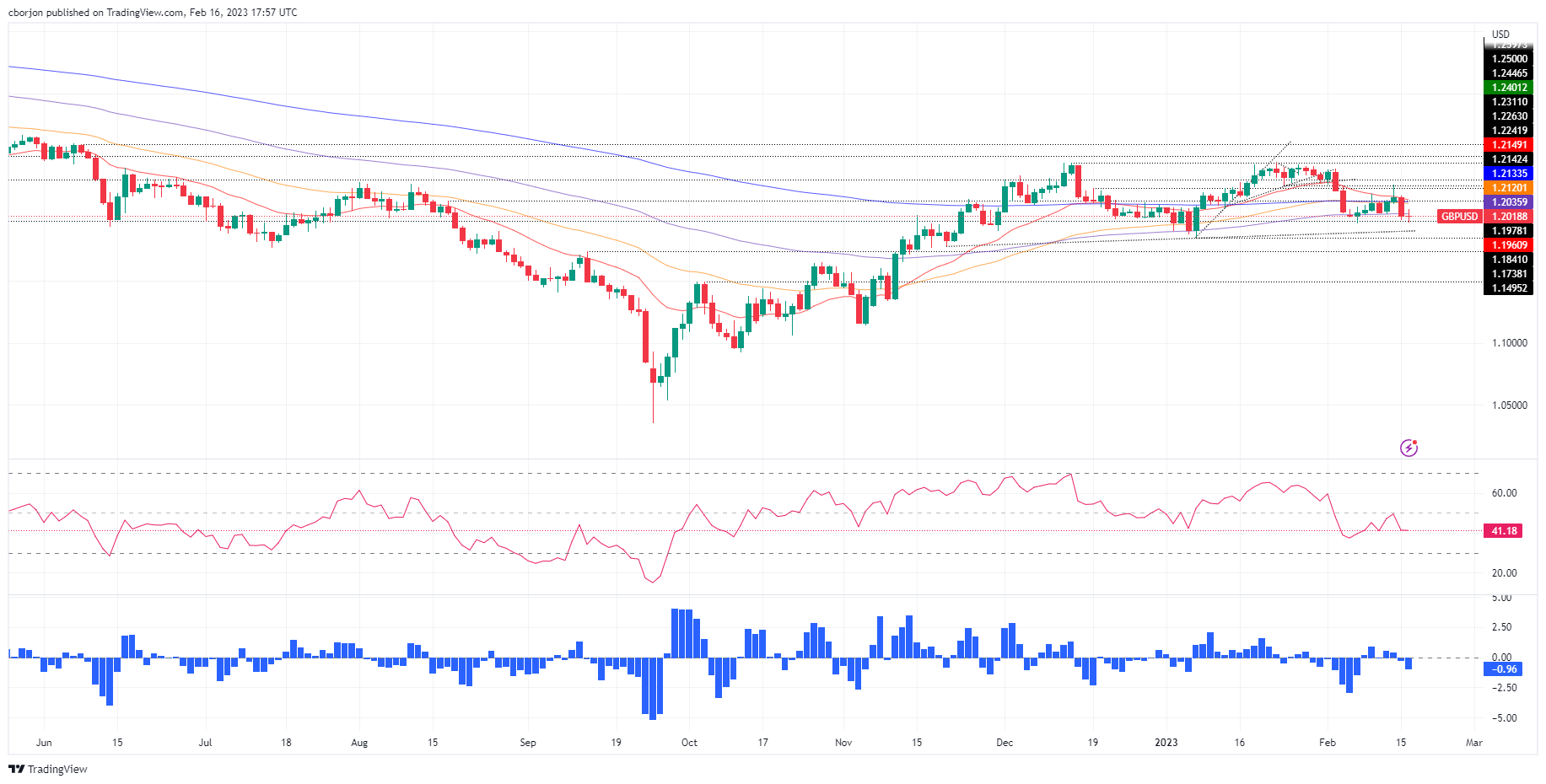
- USD/JPY hit a weekly high of 134.46 but retraced toward the 134.10 area.
- USD/JPY Price Analysis: Negative divergence between oscillators and price action could pave the way for downside action.
The USD/JPY consolidated around the 134.00 area after hitting a daily high of 134.46, though bears stepped in around the highs of the week, dragging prices lower. Hence, the USD/JPY changed its course gears and records minimal losses of 0.08%. The USD/JPY pair is trading around 134.10s on Thursday.
On February 15, the USD/JPY reached a daily high at 134.35, and since then, the USD/JPY has remained sideways within the 133.60/134.30 area. Even though the Relative Strength Index (RSI) is in bullish territory, as USD/JPY price action has headed north, the RSI did not. Hence, a negative divergence could emerge, suggesting that a price reversal looms.
If that scenario plays out, the USD/JPY first support would be this week’s low at 133.60. Break below, and the 20-day Exponential Moving Average (EMA) would be exposed at 133.28, followed by the February 13 daily high-turned support at 132.90.
On an alternate scenario, the USD/JPY’s first resistance would be the day’s high at 134.46, which, once cleared, could lift the USD/JPY to January 6 high at 134.77 before the major climbs to 135.00.
USD/JPY Daily chart
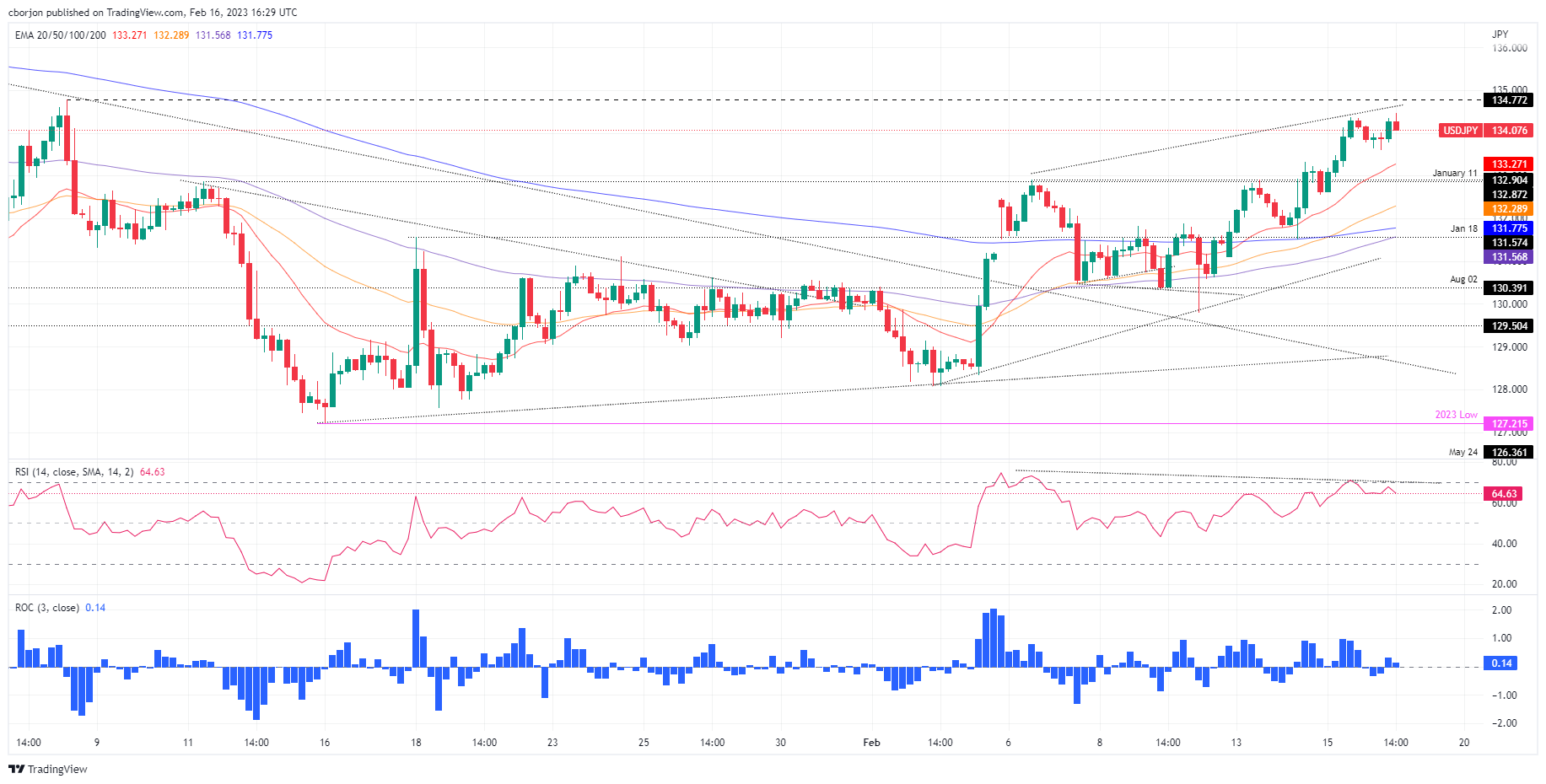
USD/JPY Key technical levels
"If evidence begins to accumulate to show that inflation is not declining in line with forecast, we are prepared to raise policy rate further, Bank of Canada Governor Tiff Macklem said while testifying before the Standing Committee on Finance.
Key takeaways
"We’ve seen some evidence that our interest rate increases are starting to slow demand and rebalance our overheated economy."
"With inflation above 6%, we are still a long way from the 2% target, but inflation is turning the corner."
"Canadian economy remains overheated and clearly in excess demand, and this continues to put upward pressure on many domestic prices."
"Expect CPI inflation to fall to around 3% in the middle of this year and reach the 2% target in 2024."
"Global energy prices could jump again, pushing inflation up around the world."
Market reaction
USD/CAD showed no immediate reaction to these comments and was last seen trading at 1.3460, where it was up 0.5% on a daily basis.
Gold is seeing a more severe setback below the crucial 55-Day Moving Average (DMA) at $1,853. Strategists at Credit Suisse expect the yellow metal to find a solid support at the 200-DMA of $1,775.
Move above $1,998 can reassert an upward bias
“Gold has been capped at resistance at $1,973/98 as expected and continues to fall further and is now clearly below the 55-DMA, currently seen at $1,853, which raises the odds of further losses towards the long-term 200-DMA, currently seen at $1,775, which we expect to floor the precious metal.”
“Above $1,998 can reassert an upward bias for a test of long-term resistance from the $2,070/72 record highs of 2020 and 2022.”
According to the Federal Reserve Bank of Atlanta's GDPNow model, the US economy is expected to grow at an annualized rate of 2.5% in the first quarter, up slightly from 2.4% in the previous estimate.
"After this morning’s housing starts report from the US Census Bureau, the nowcast of first-quarter real residential investment growth increased from -10.4 percent to -8.1 percent," the Atlanta Fed explained in its publication.
Market reaction
This report doesn't seem to be having a noticeable impact on risk mood. As of writing, the S&P 500 Index was down 0.75% on a daily basis.
Cleveland Fed President Loretta Mester said on Thursday that the recent data showed the demand side of the economy was not softening as expected and added that she was expecting growth to slow appreciably this year, as reported by Reuters.
Mester further noted that she is not ready to say if the Fed needs a bigger rate increase at the next policy meeting but said that she would not want to surprise the markets.
Elaborating on the rate outlook, Mester reiterated that the main focus now is on raising rates and added that she doubts there will be a need to cut rates this year.
Market reaction
The US Dollar Index clings to modest daily gains slightly below 104.00 following these comments.
- USD/MXN clings to its gains, hovering nearby $18.58, after solid US data.
- US labor market data show a tight labor market, while the PPI came higher than expected.
- USD/MXN Price Analysis: Is still neutral-downward biased, but positive divergence could make a case for a rally to $19.00.
The Mexican Peso (MXN) lost some ground against the US Dollar (USD) on Thursday following US economic data, which sparked speculation that there could be more rate hikes than just two by the Federal Reserve (Fed) as money market futures data showed. At the time of writing, the USD/MXN exchanges hands at around 18.6481.
The US economic calendar is a busy one on Thursday. On the inflation side, the Producer Price index (PPI) for January rose by 0.7% MoM, above estimates of 0.4%, while Core PPI, which excludes volatile items, came at 0.5% vs. 0.3% foreseen. Even though year-over-year data was lower than the previous month, monthly figures underscore stubbornly stickier inflation that might need further tightening by the Fed.
Aside from this, Initial Jobless Claims for the week ending on February 11 hit 194K, below the prior reading of 196K, and below the 200K foreseen by analysts, emphasizing the tightness of the labor market, which remains pending of displaying the effects of 450 bps of rate hikes by the Fed.
In other data, the Philadelphia Fed Manufacturing Index plunged below estimates of -7.4, down to -24.3. Comments from the poll showed that cost increases accelerated for the first time in 10 months, contrarily to their own prices, which slowed down.
According to Reuters, “the survey’s two measures of prices, those paid by producers and those they charge their customers - both closely watched inflation indicators - showed margins were slimming. The prices paid index edged up to 26.5 from 24.5 to mark its first increase since April 2022, while the prices received index fell by 50% to 14.9, the lowest reading since February 2021.”
Meanwhile, the USD/MXN regained some composure after hitting a low of 18.5361. Albeit it hit a daily high of 18.6832, it has remained pressured, by market sentiment, with risk-on impulses increasing demand for the Mexican Peso.
Elsewhere, Cleveland Fed President Loretta Mester said she sees compelling evidence to hike rates by 50 bps in the upcoming meetings. She sees upside risks to inflation and justifies that the scenario supports the case for “overshooting” on policy. “Over-tightening also has costs, but if inflation begins to move down faster than anticipated, we can react appropriately,” Mester said.
USD/MXN Technical analysis
From a technical perspective, the USD/MXN remains neutral-downward biased. Still, the positive divergence between the Relative Strength Index (RSI) and price action is looming, meaning that prices could move higher. For a bearish continuation, the USD/MXN needs to break below the YTD low at 18.4836, so it can test the psychological $18.00. On the other hand, if the USD/MXN reclaims the 20-day EMA at 18.7714, the USD/MXN would be poised to challenge $19.00.
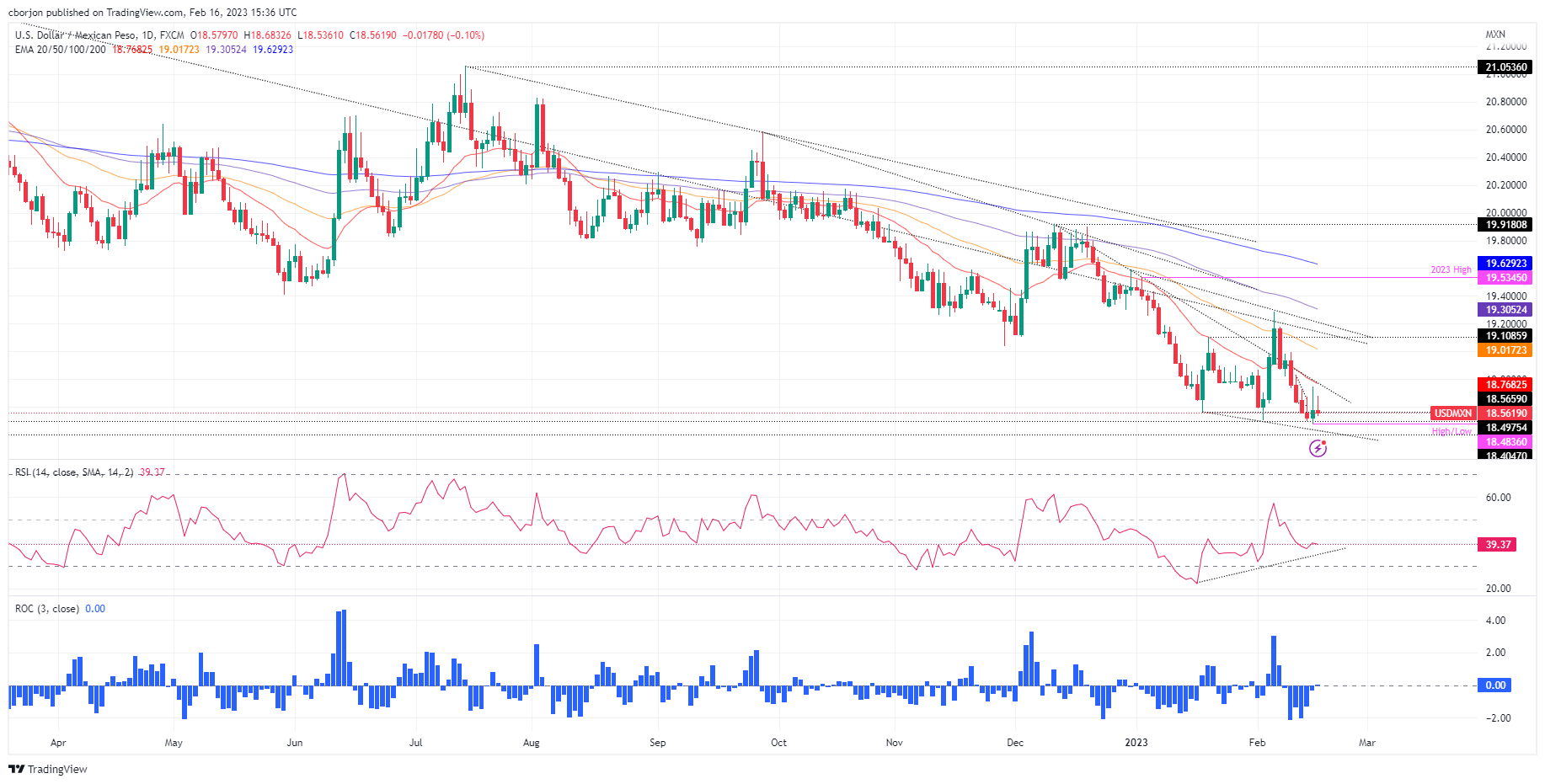
European Central Bank (ECB) Chief Economist Philip Lane said on Thursday that policy actions are clearly tightening financial conditions, as reported by Reuters.
"Much of the ultimate inflation impact of our policy measures to date is still in the pipeline," Lane added. "Over time, our monetary policy will make sure that inflation returns to our target in a timely manner."
Additional takeaways
"Models signal for the most part point to a strong and orderly transmission of the ECB’s policy tightening to the relevant financial and real variables."
"Open minded about the precise scale of the monetary policy tightening that will be needed to achieve this outcome."
"Calibration of the monetary policy stance needs to be regularly reviewed in line with the incoming information about underlying inflation."
"Models suggest that reducing our asset portfolio by a normalised cumulative €500 billion reduction over 12 quarters contributes to lowering inflation by 0.15 percentage points and output by 0.2 percentage points."
"Tightening is estimated to have already lowered inflation by around 0.2 percentage points in 2022."
"Inflation is estimated to be around 1.2 percentage points lower in 2023 and 1.8 percentage points lower in 2024 as a result of the tightening."
"Significant amount of excess savings could dampen the transmission of higher policy rates to the economy and inflation."
Market reaction
EUR/USD stays on the back foot following these comments and the pair was last seen losing 0.2% on the day at 1.0670.
Optimistic investors are sending US stocks higher, but they should be wary of moves that “fight the Fed,” Lisa Shalett, Chief Investment Officer, Wealth Management at Morgan Stanley reports.
The economic outlook is blurry
“Some investors expect the economic recovery in China to rescue the US. economy from steeper decline, but if US growth rebounds, that could put upward pressure back on prices and prompt the Fed to keep rates higher for longer, in turn weighing on asset prices.”
Corporate profits remain vulnerable
“For the past 10 quarters, US nominal GDP has run between 9% and 14%, versus the long-run trend of 4-5%, and S&P 500 operating margins have averaged 14.5-16.5%, versus the 25-year average of 12.5%. The tendency for performance to revert to a long-term average could bring about a negative year-over-year change in earnings growth, known as a ‘profits recession’.”
Strength in the labor market persists
“A resilient jobs market could help the economy achieve a ‘soft landing’ if robust real wages support consumption. The conundrum, however, is that strong wages and spending would likely add to inflationary pressures and thus provide little rationale or incentive for the Fed to cut rates.”
EUR/USD has extended its setback. However, this phase should prove to be temporary, in the view of analysts at Credit Suisse.
Key level to watch is 1.0655 in EUR/USD
“Near-term momentum stays lower, and below 1.0695/55 would be seen to warn of a deeper but still, we think corrective setback to next support at the 38.2% retracement of the 2022/2023 rally and early January YTD low at 1.0483/63. We look for this though to prove better support if tested.”
“Above 1.0802/06 is needed to clear the way for strength back to test the 50% retracement of the 2021/2022 fall at 1.0944. A weekly close above here should see a move back to the 1.1035 current YTD high and eventually what we look to be tougher resistance at 1.1185/1.1275.”
US rates are helping the Dollar, while we wait for a new market theme to emerge, Kit Juckes, Chief Global FX Strategist at Société Générale, reports.
The Dollar is rising with US rates again
“Absent a genuinely new driver, we have seen strong US data push up pricing of terminal Fed Funds and the dollar has reverted to rising in sync with real rates. Reviving an old relationship is fine for a while, but can only take the Dollar so far. We're still looking for a new story.”
“Current pricing looks for two or three 25 bps hikes by September, and it may take a bigger inflation scare than we saw in this week's CPI data, or another very strong labour market report at the start of March, to push them higher. Absent that, we will probably get stuck in a range again, before the next move (which we'd guess is more likely to be towards Dollar softness as growth resumes elsewhere).”
Economists at Commerbznka believe that the Euro has little scope to strengthen.
Little scope for the ECB to deviate from the course set by the Fed
“The market seems to see little scope for the ECB to deviate from the course set by the Fed. This would lead to a weaker Euro and thus to new inflationary impulses, which the euro area cannot afford in view of the still seriously high inflation.”
“We now see the market more in line with the hawkish comments from the ECB. However, this also means that further appreciation potential for the Euro is limited.”
- EUR/USD now adds to Wednesday’s decline below 1.0700.
- Fed’s L.Mester stressed inflation risks remain on the upside.
- US Producer Prices rose more than estimated in January.
Another data-led rebound in the greenback puts EUR/USD under fresh pressure and drag it to the sub-1.0700 region on Thursday.
EUR/USD weak on USD bounce
EUR/USD now extends the selling pressure seen in the previous session in response to another bullish attempt in the greenback, this time following results from the US docket and hawkish remarks from Fed’s L.Mester (2024 voter, hawk).
Indeed, the pair revisited the area below 1.0700 the figure after US Producer Price rose more than expected a monthly 0.7% in January and 6.0% from a year earlier. Still on the strong side, weekly Initial Claims increased by 194K in the week to February 11, showing once again the persistent good health of the labour market.
On the not-so-bright side, Building Permits expanded at a monthly 0.1% in January - or 1.339M units - Housing Starts shrank 4.5% MoM - or 1.309M units - and the Philly Fed Manufacturing Index disappointed everybody after declining to -24.3 for the current month.
Earlier in the session, ECB’s F.Panetta suggested inflation in the region could drop below the 3% at some point towards the end of the year, while he also warned against risks of over-tightening (seriously?).
From the Fed’s playground, Cleveland Fed and well-known hawk L.Mester (2024 voter) reiterated that inflation remains too high at the time when she noted that the current Fed’s tightening cycle should slow growth and increase unemployment. She also advocated for rates to climb above the 5% level and stay there for an extended period of time.
What to look for around EUR
Despite the recent rebound to the 1.0800 region, EUR/USD remains within the multi-day consolidative phase and decently supported near 1.0650 for the time being.
In the meantime, price action around the European currency should continue to closely follow dollar dynamics, as well as the potential next moves from the ECB after the bank has already anticipated another 50 bps rate raise at the March event.
Back to the euro area, recession concerns now appear to have dwindled, which at the same time remain an important driver sustaining the ongoing recovery in the single currency as well as the hawkish narrative from the ECB.
Eminent issues on the back boiler: Continuation of the ECB hiking cycle amidst dwindling bets for a recession in the region and still elevated inflation. Impact of the Russia-Ukraine war on the growth prospects and inflation outlook in the region. Risks of inflation becoming entrenched.
EUR/USD levels to watch
So far, the pair is retreating 0.13% at 1.0672 and a drop below 1.0655 (weekly low February 13) would target 1.0481 (2023 low January 6) en route to 1.0325 (200-day SMA). On the upside, the next up barrier aligns at 1.0804 (weekly high February 14) seconded by 1.1032 (2023 high February 2) and finally 1.1100 (round level).
The S&P 500 rally has stalled near term, but analysts at Credit Suisse still see scope for an eventual test of 4312/4325.
Initial support seen at 4016
“The S&P 500 rally looks to have stalled near term, and we see scope for some near-term consolidation and a pullback. This stays viewed as a temporary setback ahead of further strength in due course to test key resistance at the 61.8% retracement of the 2022 fall and summer 2022 high at 4312/4325. We look for this to then prove a tough barrier to define the top of what we believe could be a broad and lengthy range.”
“Support is seen at 4016 initially, then the 63 and 200-day averages at 3975/43, which we look to ideally hold. Below 3886 though is needed to suggest we may have seen a ‘false’ break higher and more important peak.”
Federal Reserve Bank of Cleveland President Loretta Mester said on Thursday that she saw a 'compelling case' for a 50 basis points (bps) rate hike at the last FOMC meeting, as reported by Reuters.
Key takeaways
"Fed has more work to do to control inflation."
"Fed will need to go above 5% and stay there for a while."
"Transition back to price stability will bring some pain."
"How far Fed goes above 5% depends on data."
"Upside risks to inflation remain in place."
"Fed actions will slow growth, push up unemployment."
"January CPI data showed still more to do on cooling inflation."
"Inflation levels remain too high."
"Bigger risk is to undershoot in effort to control inflation."
"How far Fed goes with future hikes depends on inflation."
"Expecting to make good progress on lowering inflation."
Market reaction
The US Dollar holds its ground against its major rivals following these comments and the US Dollar Index was last seen rising 0.12% on the day at 103.93.
Alvin Liew, Senior Economist at UOB Group, assesses the recent Q4 GDP results in the Japanese economy.
Key Takeaways
“Japan’s 4Q 2022 GDP rebounded as expected, but the pace of increase was below forecast at 0.2% q/q, 0.6% q/q SAAR while the contraction in 3Q was revised worse to -0.3% q/q, -1.0% q/q SAAR. For the full year, GDP expanded by 1.1% in 2022, easing from 2.1% in 2021.”
“We had expected Japan’s economy to rebound in 4Q but the momentum was weaker than forecast as we underestimated the impact of stronger inflation and the decline in business spending, offsetting the recovering private consumption while the stronger yen and falling commodity prices in 4Q helped trim the country’s previously ballooning import bill. But weaker external demand (as overseas markets slowed down) made the export recovery shallower.”
“Japan GDP Outlook – Our 2023 outlook is largely premised on broad moderation in external economies this year, and we project the US and European economies to enter a (shallow) recession this year amidst aggressive monetary policy tightening stance among these advanced economies. This will directly impact the manufacturing and external-oriented services sectors and will imply softer demand for Japan’s exports. In comparison, services is expected to fare better and help anchor the domestic economic recovery as upside growth factors could be attributed to the continued recovery in leisure and business air travel and inbound tourism, which will benefit many in-person services sectors, and the impact of China’s reopening is likely to be positive for these sectors. With the weaker 2023 manufacturing outlook cushioned by the improving tourism and barring external events (such as escalating war in Europe, worsening US-China relations and a deadlier variant of COVID-19), we keep our modest 2023 GDP growth forecast of 1.0% (from 1.1% in 2022).”
- GBP/USD comes under renewed selling pressure on Thursday and refreshes the weekly low.
- The emergence of fresh USD buying turns out to be a key factor dragging spot prices lower.
- The technical setup favours bearish traders and supports prospects for a further downfall.
The GBP/USD pair attracts fresh selling following an intraday move up to the 1.2075 area and drops to a fresh daily low during the early North American session. The pair slips back below the 1.2000 psychological mark in the last hour and is now seen flirting with the weekly low touched on Wednesday.
The prospects for further policy tightening by the Fed, along with the risk-off impulse, assist the safe-haven US Dollar to recover a major part of its intraday losses. Furthermore, expectations that the Bank of England's (BoE) current rate-hiking cycle is nearing the end continue to undermine the British Pound and act as a headwind for the GBP/USD pair.
From a technical perspective, spot prices this week struggled to find acceptance above the 50-day SMA and the overnight slump suggests that the near-term downtrend is still far from being over. The outlook is reinforced by the fact that oscillators on the daily chart are holding in the bearish territory and are still far from being in the oversold zone.
Hence, a subsequent slide towards challenging the very important 200-day SMA, currently around the 1.1940-1.1935 region, looks like a distinct possibility. Against the backdrop of a double-top formation near the 1.2445-1.2450 region, some follow-through selling will confirm a fresh bearish breakdown and set the stage for a further depreciating move.
The GBP/USD pair might then turn vulnerable to weaken further below the 1.1900 round-figure mark and accelerate the slide towards retesting the YTD low, around the 1.1840 region touched in January.
On the flip side, the 1.2060-1.2070 region now seems to act as an immediate hurdle ahead of the 1.2100 mark and the 1.2125-1.2130 horizontal zone. This is followed by the 50-day SMA, around the 1.2175 area, above which a fresh bout of a short-covering could lift the GBP/USD pair beyond the 1.2200 mark, towards the 1.2265-1.2270 region, or the weekly high.
GBP/USD daily chart
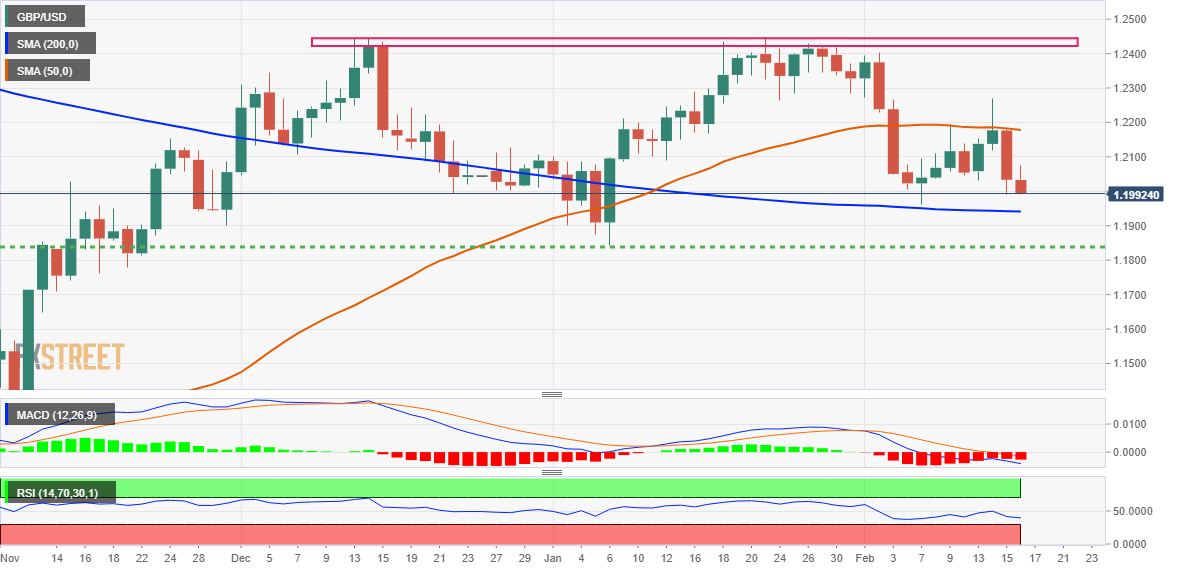
Key levels to watch
- Housing Starts in the US declined sharply in January.
- US Dollar Index holds in positive territory slightly below 104.00.
The monthly data published by the US Census Bureau revealed on Thursday showed that Housing Starts declined by 4.5% on a monthly basis in January following December's 2.4% drop.
In the same period, Building Permits rose by 0.1% but fell short of the market expectation for an increase of 0.8%.
Market reaction
The US Dollar Index edged higher in the early American session following the latest data releases and was last seen rising 0.08% on the day at 103.90.
Senior Economist at UOB Group Alvin Liew comments on the recent revision of GDP figures in Singapore.
Key Takeaways
“Singapore’s final 4Q22 GDP growth was revised lower to 2.1% y/y, 0.1% q/q (versus Bloomberg median forecast & UOB est. of 2.3% y/y) from the advance estimate of 2.2% y/y, 0.2% q/q. The downward revision for 4Q GDP came about despite the better-than-expected manufacturing sector performance and instead, it was let down by the downward revisions to the services and construction sectors. For the full year, GDP growth was revised lower to 3.6% in 2022 (from advance estimate of 3.8%) as growth in the manufacturing and services growth were revised a tad lower.”
“The message from the Ministry of Trade and Industry (MTI) provided a small silver lining as it noted that “Singapore’s external demand outlook has improved slightly.” The MTI sounded an optimistic tone for the growth outlook for aviation- and tourism-related sectors but remained downbeat towards outward-oriented sectors. With the cautious but “slightly” improved external outlook and barring the materialisation of the highlighted risk factors, the MTI kept its Singapore GDP growth forecast for 2023 unchanged at the range of “0.5-2.5%.” As for the trade outlook, the Enterprise Singapore (ESG) is maintaining the forecast of “-2.0% to 0.0%” for both total merchandise trade and NODX, due to a high base in 2022 and lower expected oil prices.”
“Our SG GDP Outlook - Our 2023 outlook is largely premised on broad moderation in external economies, and we project key end markets for Singapore to enter a (shallow) recession this year amidst aggressive monetary policy tightening stance among advanced economies. Services could fare better in 2023 as upside growth factors could be attributed to the continued recovery in leisure and business air travel and inbound tourism. We keep our modest 2023 GDP growth forecast of 0.7% (closer to the lower end of the official forecast).”
- Initial Jobless Claims in the US decreased by 1,000 in the week ending February 11.
- US Dollar Index stays in the upper half of its daily range.
There were 194,000 initial jobless claims in the week ending February 11, the weekly data published by the US Department of Labor (DOL) showed on Thursday. This print followed the previous week's print of 195,000 and came in slightly better than the market expectation of 200,000.
Further details of the publication revealed that the advance seasonally adjusted insured unemployment rate was 1.2% and the 4-week moving average was 189,500, an increase of 500 from the previous week's revised average.
"The advance number for seasonally adjusted insured unemployment during the week ending February 4 was 1,696,000, an increase of 16,000 from the previous week's revised level," the DOL noted.
Market reaction
The US Dollar Index clings to small daily gains but stays below 104.00 after this data.
- US annual PPI in January declined at a softer pace than expected.
- US Dollar Index stays below 104.00 after the data.
The Producer Price Index (PPI) for final demand in the US declined to 6% on a yearly basis in January from 6.5% in December, the data published by the US Bureau of Labor Statistics revealed on Thursday. This reading came in higher than the market expectation of 5.4%.
The annual Core PPI edged lower to 5.4% in the same period from 5.5%, compared to analysts' estimate of 4.9%. On a monthly basis, the Core PPI came in at 0.5%.
Market reaction
The US Dollar Index staged a modest rebound with the initial reaction to the PPI data and was last seen posting small daily gains at 103.87.
- EUR/USD regains the smile following Wednesday’s marked drop.
- Immediately to the downside appears the monthly low near 1.0650.
EUR/USD extends the multi-session consolidative phase around the 1.0700 neighbourhood so far on Thursday.
If the selling pressure gathers extra impulse, the pair could challenge he February low at 1.0655 (February 13) in the short-term horizon. The breach of the latter exposes further weakness to the YTD low at 1.0481 (January 6).
In the longer run, the constructive view remains unchanged while above the 200-day SMA, today at 1.0325.
EUR/USD daily chart
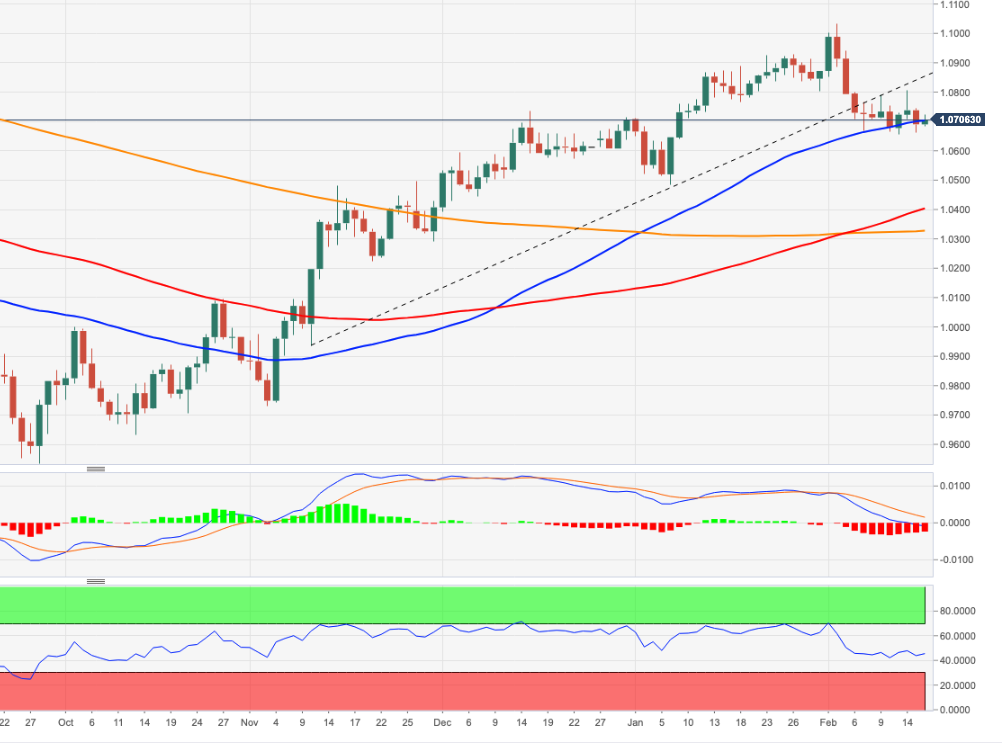
- Silver fails to capitalize on its modest intraday uptick to the 100-day SMA support breakpoint.
- The technical setup supports prospects for an extension of the well-established downtrend.
- Bears, however, might wait for a break below the 50% Fibo. level before placing fresh bets.
Silver struggles for a firm direction on Thursday and seesaws between tepid gains/minor losses heading into the North American session. The white metal is currently placed just above the mid-$21.00s and remains well within the striking distance of its lowest level since November 2022 touched on Wednesday.
From a technical perspective, the overnight convincing break and acceptance below the 100-day SMA could be seen as a fresh trigger for bears. That said, oscillators on the daily chart have moved on the verge of breaking into oversold territory. This, in turn, assists the XAG/USD to defend the 50% Fibonacci retracement level of the recent rally from October 2022.
This makes it prudent to wait for some follow-through selling below the aforementioned support, around the $21.40 area, before positioning for a further decline. The XAG/USD might then accelerate the slide
towards a technically significant 200-day SMA, currently near the $21.00 mark. Spot prices could eventually drop to 61.8% Fibo. level support around the $20.60 zone.
On the flip side, the 100-day SMA support breakpoint, around the $21.85 region, now seems to act as an immediate hurdle ahead of the $22.00 mark and the 38.2% Fibo., near the $22.15 area. Any further move up might continue to attract fresh sellers near the $22.60-$22.70 supply zone. This, in turn, should cap the XAG/USD near the $23.00 mark, representing the 23.6% Fibo.
That said, a convincing break through the latter could offset the negative outlook and shift the near-term bias in favour of bullish traders. The subsequent move up has the potential to lift the XAG/USD towards the $24.00 round-figure mark. Bulls might then aim back to challenge the $24.50 supply zone, which if cleared decisively should pave the way for a fresh leg up.
Silver daily chart
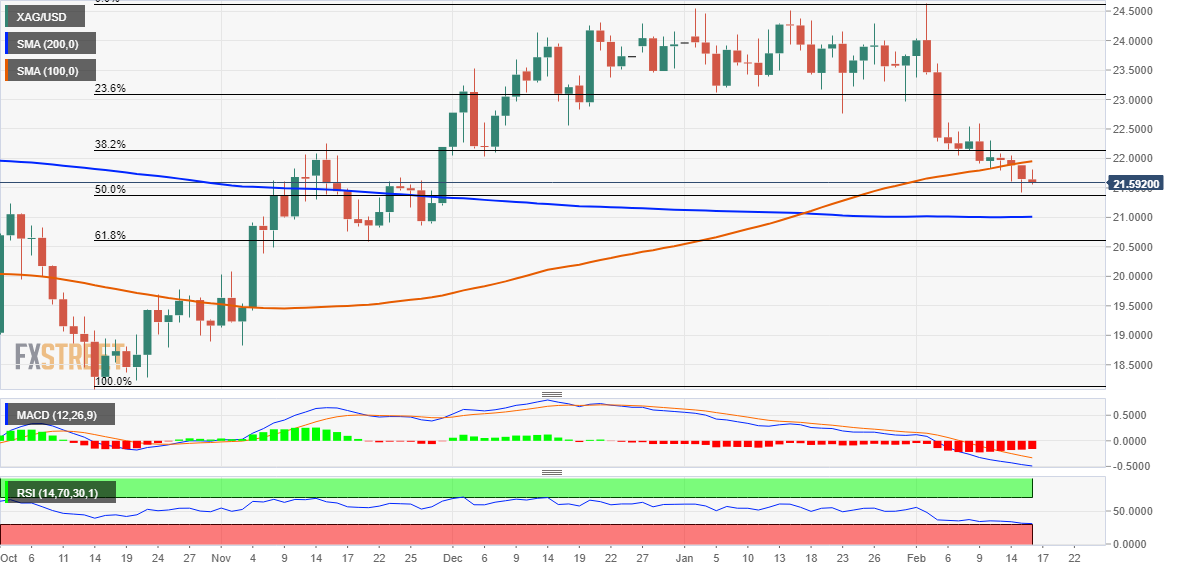
Key levels to watch
GBP/USD consolidates. Pressure on the low 1.20s may trigger more softness, in the view of economists at Scotiabank.
Cable price action may be forming a bear flag
“Cable price action has been generally consolidative.”
“Modest gains from yesterday’s low are running into better selling pressure near 1.2070/75 and GBP's price action may be forming a bear flag – implying renewed weakness on a break under minor support at 1.2040.”
See – GBP/USD should continue to find support in the 1.1950/2000 area – ING
US Dollar eases but undertone remains firm. Renewed gains are likely, according to analysts at Scotiabank.
USD to steady or strengthen somewhat in the short run
“Losses have been limited and beyond these short-term swings, USD prospects do appear to be edging a little more positively.”
“There is a window opening for the USD to steady or strengthen somewhat in the short run – which would be in keeping with the DXY’s seasonal tendency to appreciate in Q1.”
“There is a fair bit more US data to get through. PPI is expected to reflect still significant MoM gains but some moderation in YoY price growth. Higher than expected results will lift the USD. Starts, permits and claims data may not have much impact.”
- USD/CAD reverses an intrada dip and draws some support from a combination of factors.
- Recession fears cap the attempted recovery in crude oil prices and undermine the Loonie.
- The USD trims a part of its intraday losses and further contributes to the intraday bounce.
The USD/CAD pair attracts some buyers near the 1.3360-1.3355 region on Thursday and for now, seems to have stalled the pullback from the weekly high touched the previous day. The pair is currently placed just below the 1.3400 round-figure mark, nearly unchanged for the day, heading into the North American session.
Crude oil prices trim a part of the modest intraday gains amid worried that economic headwinds stemming from rising borrowing costs will dent fuel demand and undermines the commodity-linked Loonie. Apart from this, a combination of supporting factors assists the US Dollar to bounce off the daily low, which, in turn, acts as a tailwind for the USD/CAD pair.
Looming recession risks cap the recent optimistic move in the equity markets. Furthermore, expectations that the Fed will stick to its hawkish stance for longer, in the wake of stubbornly high inflation, lends some support to the safe-haven buck. In fact, the markets are now pricing in at least a 25 bps lift-off at the next two FOMC meetings in March and May.
The aforementioned fundamental backdrop seems tilted firmly in favour of the USD bulls and supports prospects for a further intraday move up for the USD/CAD pair. Hence, a subsequent strength towards the weekly high, around the 1.3440 area touched on Wednesday, looks like a distinct possibility. Traders now look to the US macro data for some meaningful impetus.
Thursday's US economic docket features the release of the Producer Price Index (PPI), the Philly Fed Manufacturing Index, Weekly Initial Jobless Claims, Building Permits and Housing Starts. This, along with the US bond yields and the broader risk sentiment, will drive the USD demand. Apart from this, oil price dynamics should produce short-term opportunities around the USD/CAD pair.
Technical levels to watch
EUR’s mini rebound runs out of steam. The EUR/USD pair remains prone to more losses, economists at Scotiabank report.
Losses should accelerate below 1.0650
“Near-term risks still appear to be tilted more towards a push to the 1.05/1.06 range than a break back above 1.08.”
“Intraday signals suggest a minor peak/reversal formed around the daily high in the low 1.07s and broader technical patterns remain bearish.”
“Minor EUR gains remain a technical sell; losses should accelerate below 1.0650.”
See: EUR/USD to trade well within the confines of a 1.0650-1.0750 range – ING
- The index keeps the choppiness well and sound below 104.00.
- A move beyond the monthly high at 104.11 exposes extra gains.
DXY sees its recent marked uptick to new monthly highs past the 104.00 mark somewhat trimmed on Thursday.
The ongoing price action leaves the door open to the continuation of the consolidative note for the time being. Occasional bouts of strength, however, should face the February high at 104.11 (February 15) as the immediate hurdle, while the trespass of this level could open the door to a potential challenge of the 2023 top at 105.63 (January 6) in the relatively near term.
In the longer run, while below the 200-day SMA at 106.44, the outlook for the index remains negative.
DXY daily chart
USD/JPY closed the third straight in positive territory on Wednesday. Analysts at Credit Suisse expect the pair to stage a race higher on a weekly close above the 133.06 resistance.
Move below 129.80 needed to reassert a downward bias
“Key resistance from the 55-Day Moving Average looks to be breaking. Above 133.06 on a weekly closing basis should mark a conclusive break, with resistance then seen next at 134.78 ahead of now we think the 38.2% retracement of the 2022/2023 fall and 200-DMA at 136.67/86. We look for this to then prove a much tougher barrier for an eventual turn lower again.”
“Below 129.80 is needed to reassert a downward bias for a retest of 127.53/23. An eventual break below here can see support next at 126.36 ahead of the 61.8% retracement of the 2021/2022 uptrend at 121.44.”
Economist at UOB Group Ho Woei Chen reviews the latest credit figures in the Chinese economy.
Key Takeaways
“China’s local currency loans rose by a record CNY4.90 tn in Jan (Bloomberg est: CNY4.20 tn, Dec: CNY1.40 tn). Similar to the trend in the preceding months, the biggest contributor to higher credit growth was corporate loans.”
“Confidence in the household sector has remained weak, resulting in weaker home purchases as well as consumption loans. Notably for 2022, loans to households slowed sharply to account for just 18% of the new loans compared to 40% in 2020-21.”
“The low credit impulse implies the recovery momentum had been weak. We maintain our forecast for China’s GDP growth to improve moderately to 3.4% y/y in 1Q23 (4Q22: 2.9%), accounting for a relatively higher base of 4.8% y/y in year ago period.”
“As the economy continues to recover and normalise in 2023, we expect credit growth to pick up along with stronger corporate activities, infrastructure construction and private consumption. The PBOC may also need to further cut its interest rate and RRR to boost the economic outlook.”
“On a longer-term basis, the growth in TSF in China would likely remain below 10% as the GDP growth moderates which limits banks’ credit expansion.”
- EUR/JPY comes under some pressure following recent YTD highs.
- The continuation of the uptrend remains focused on 146.70.
EUR/JPY gives away part of Wednesday’s advance to new 2023 highs past the 143.00 hurdle on Thursday.
While the cross looks broadly side-lined for the time being, a convincing breakout of the upper end of the range near 143.50 could trigger a move higher to, initially, the December 2022 top at 146.72 (December 15).
In the meantime, while above the 200-day SMA, today at 141.17, the outlook for the cross is expected to remain positive.
EUR/JPY daily chart

Sustained strong labour and inflation numbers are boosting expectations that the US Federal Reserve will continue monetary tightening longer than anticipated. This is benefitting the US Dollar and weighing on the Gold price, strategists at ANZ Bank report.
Weakening inverse correlation of Gold with US yield
“Gold price is inversely tracking the USD. Strong labour and retail sales data are raising the spectre of sticky inflation, which means the Fed will likely keep rates higher than expected. This is a downside risk for the Gold price. Furthermore, the relationship between real rates and Gold is weakening.”
“Investors’ net-long positions have increased, but physical allocation (via ETF holdings) is still missing. Higher Gold prices are also impacting physical demand in India. Chinese wholesale demand for gold is weak too. Central banks’ purchases have been resilient.”
Economist Lee Sue Ann and Markets Strategist Quek Ser Leang at UOB Group said the outlook for USD/CNH still points to further gains in the near term.
Key Quotes
24-hour view: “Yesterday, we expected USD to strengthen but we were of the view that ‘a break of the major resistance at 6.8500 is unlikely today’. The anticipated USD strength exceeded our expectations as it surged to a high of 6.8710. While conditions are overbought, USD could continue to advance. However, a break above the major resistance at 6.8800 is unlikely today. Support is at 6.8580, a breach of 6.8420 would indicate that the current upward pressure has eased.”
Next 1-3 weeks: “We have held a positive view in USD since early this month. In our latest narrative from three days ago (13 Feb, spot at 6.8275), we highlighted that ‘the likelihood of USD breaking above 6.8500 has increased’. USD broke above 6.8500 yesterday and soared to a high of 6.8710. The 6.8800 level we indicated early this month appears to be within reach. A break of 6.8800 will shift the focus to 6.9000. Overall, we continue to hold a positive USD stance as long as it does not break below 6.8250 (‘strong support’ level previously at 6.7800).”
The US Dollar is expected to see a lengthier but still temporary consolidation/recovery phase, according to economists at Credit Suisse.
Key levels to watch include the 55-Day Moving Average at 103.65/96 in DXY
“The DXY extends its consolidation as expected beneath the 55-DMA at 103.65/96. A close above here would suggest a deeper recovery can be seen to 105.63, potentially the 38.2% retracement of the 2022/2023 fall and 200-DMA at 106.15/45. We would expect this to prove the extent of the recovery though, and we would look for this to cap to define the top of a broader range.”
“Post this consolidation phase, our bigger picture view remains that 101.30 will eventually break, triggering further weakness later on to test 99.82/37, then the 61.8% retracement at 98.98.”
Bank Indonesia (BI) kept its policy rate unchanged at 5.75% today. USD/IDR is trading in the red and a failure to hold last week low of 15000 would trigger more losses, economists at Société Générale report.
15400 is a crucial resistance
“Bank Indonesia kept rates unchanged at 5.75%.”
“Lower band of the November/December consolidation at 15400 is a crucial resistance. Failure to cross would mean persistence in down move.”
“Break of last week's low at 15000 is likely to result in a decline towards 14810 and perhaps even towards April 2021 high of 14600.”
- AUD/USD attracts some dip-buying on Thursday despite disappointing Australian jobs data.
- Retreating US bond yields triggers a modest USD pullback and lends support to the major.
- Hawkish Fed expectations should limit the USD losses and cap the pair ahead of the US data.
The AUD/USD pair once again show some resilience below the 50-day SMA and attracts fresh buying near the 0.6870-0.6865 region on Thursday. The pair sticks to its intraday gains through the first half of the European session and is currently placed around the 0.6920 region, just a few pips below the daily top.
As investors look past the downbeat Australian employment figures, a modest US Dollar weakness is seen as a key factor lending support to the AUD/USD pair. In fact, the Australian Bureau of Statistics reported earlier this Thursday that the number of employed people fell by 11.5K in January against an addition of 20K expected. Moreover, the previous month's reading was also revised to show a loss of 19.9K jobs as compared to the 14.6 fall estimated originally. The unemployment rate, meanwhile, edged higher to 3.7% during the reported month vs. 3.5% anticipated and the previous.
The market reaction, however, turns out to be short-lived amid the emergence of some selling around the USD, which is weighed down by retreating US Treasury bond yields. That said, firming expectations for further policy tightening by the Federal Reserve should limit any meaningful downside for the US bond yields and the Greenback. Investors now seem convinced that the US central bank will stick to its hawkish stance for longer and are pricing in at least a 25 bps lift-off at the next two FOMC meetings in March and May. The bets were reaffirmed by the US consumer inflation figures on Tuesday.
Furthermore, Wednesday's upbeat US monthly Retail Sales data pointed to a stronger economy, which remains resilient despite rising borrowing costs. This, along with the recent hawkish remarks by several Fed officials, stressing the need for additional interest rate hikes to fully gain control of inflation, favours the USD bulls. Apart from this, looming recession risks should also contribute to keeping a lid on any meaningful upside for the AUD/USD pair, at least for the time being. Traders now look forward to the US macro data for a fresh impetus during the early North American session.
Thursday's US economic docket features the release of the Producer Price Index (PPI), the Philly Fed Manufacturing Index, the usual Weekly Initial Jobless Claims, Building Permits and Housing Starts. Apart from this, the US bond yields and the broader risk sentiment will influence the USD price dynamics. This, in turn, should allow traders to grab short-term opportunities around the AUD/USD pair.
Technical levels to watch
Economists at ING discuss the USD outlook for this quarter and the possible range of trading for the EUR/USD and USD/JPY.
Dollar rangebound for the rest of this quarter
“The 2-10 year US Treasury curve remains as inverted as at any point in this cycle – providing the Dollar with support. Arguably the Dollar could/should have traded even stronger given the backup in US rates. The reason it has not traded stronger is probably down to the risk environment.”
“Equity markets are holding onto early-year gains and recent buy-side investor surveys show that cash levels – though dipping – are still far from levels to suggest the buy-side is fully invested in this equity rally. Indeed, surveys still point to underweight positioning in equity markets.”
“We suspect this delicate balance between a hawkish Fed and a buy-side still looking to add to risk assets will leave the Dollar range-bound for the rest of this quarter.”
“1.05-1.10 could be the broad range in EUR/USD and something like 128-136 for USD/JPY – the latter also having to deal with a new Bank of Japan governor.”
Fed’s credibility is not up for debate. Economists at Commerzbank believe that a weaker Dollar is less likely following robust January data.
Trust is good, rate hikes are better
“The US economy has started into the new year in a much more robust manner than expected, and the Fed will have to hike rates more significantly than expected to ensure that inflation falls towards its target.”
“The Fed’s high credibility is not questioned. As long as the fall in inflation does not seem sufficiently certain, there is confidence the Fed will tighten its monetary policy and a weaker Dollar seems less justified.”
- GBP/USD attracts some buyers on Thursday amid a modest USD pullback from a multi-week top.
- Retreating US bond yields weighs on the USD, though hawkish Fed expectations help limit losses.
- Speculations that the BoE’s rate-hiking cycle is nearing the end contribute to capping the major.
The GBP/USD pair gains some positive traction on Thursday and reverses a part of the previous day's slide to levels just below the 1.2000 psychological mark, or over a one-week low. The pair sticks to its modest intraday gains through the first half of the European session and is currently placed just above mid-1.2000s, albeit lacks follow-through.
Retreating US Treasury bond yields trigger a modest US Dollar pullback from a six-week high touched on Wednesday, which, in turn, lends some support to the GBP/USD pair. That said, the prospects for further policy tightening by the Fed, along with looming recession risks, help limit the downside for the safe-haven Greenback. Apart from this, expectations that the Bank of England's (BoE) current rate-hiking cycle is nearing the end contribute to keeping a lid on any meaningful upside for the major.
Investors seem convinced that the US central bank will stick to its hawkish stance and are now pricing in at least a 25 bps lift-off at the next two FOMC meetings in March and May. The bets were reaffirmed by the US CPI report on Tuesday and the recent comments by several FOMC officials, stressing the need for additional intrada rate hikes to fully gain control of inflation. This, in turn, might hold back traders from placing aggressive bearish bets around the USD and caps the GBP/USD pair.
In contrast, the softer-than-expected UK consumer inflation figures released on Wednesday ease pressure on the BoE to deliver aggressive rate hikes going forward. This further warrants some caution for the GBP/USD bulls and positioning for any further intraday appreciating move. Traders now look to the US economic docket - featuring the Philly Fed Manufacturing Index, the usual Weekly Initial Jobless Claims, Building Permits and Housing Starts - for some short-term opportunities.
Technical levels to watch
In the month to date, the EUR has dropped 1.7% vs. the USD. Economists at Rabobank point out the key support level to watch.
EUR will be more sensitive to bad economic news than to good
“Given that the market had cut its long USD positions at the end of last year and into January, the risk of a higher peak for Fed funds is suggestive of the potential for further USD gains into the middle of the year.”
“Given that the market is now positioned long of EURs, it will be more sensitive to bad economic news than to good.”
“Supports will be offered by the week’s low in the EUR/USD 1.0656 region. Below this, the year-to-date low at 1.0484 is likely to offer strong support.”
GBP/USD suffered heavy losses on Wednesday but managed to hold above the key 1.2000 level. Economists at ING expect the pair to remain above the 1.1950/2000 zone.
GBP/USD may get a lift in the second quarter
“This week's slightly softer-than-expected wage and core CPI data have seen Sterling hand back a budding rally. We suspect this will be the story for most of this year, where we see EUR/GBP trading in the 0.89/90 area. GBP/USD may, however, get a lift in the second quarter if we are right with our Dollar call.”
“For today, Cable should continue to find support in the 1.1950/2000 area.”
- USD/JPY edges lower on Thursday and snaps a three-day winning streak to a multi-week high.
- Retreating US bond yields undermines the Greenback and exerts some pressure on the major.
- Hawkish Fed expectations should limit the USD decline and lend support ahead of the US data.
The USD/JPY pair comes under some selling pressure on Thursday and snaps a three-day winning streak to the highest level since January 6, around the 134.35 area touched the previous day. The pair remains on the defensive through the first half of the European session and is currently placed around the 133.80 region, just a few pips above the daily low.
The US Dollar retreats from a six-week high amid a modest downtick in the US Treasury bond yields and turns out to be a key factor dragging the USD/JPY pair lower. The Japanese Yen (JPY), on the other hand, is underpinned by speculations that the Bank of Japan (BoJ) governor candidate Kazuo Ueda will dismantle the yield curve control. Apart from this, looming recession risks further benefit the JPY's relative safe-haven status and weighs on the major.
The downside for the USD/JPY pair, however, seems cushioned amid the prospects for further policy tightening by the Fed, which should act as a tailwind for the US bond yields and the Greenback. In fact, the markets are now pricing in at least a 25 bps lift-off at the next two FOMC meetings in March and May. The bets were reaffirmed by the recent US macro data, which pointed to stubbornly high inflation and a resilient economy, despite rising borrowing costs.
The aforementioned fundamental backdrop seems tilted in favour of the USD bulls and supports prospects for the emergence of some dip-buying around the USD/JPY pair. Even from a technical perspective, this week's sustained breakout through the 133.00 hurdle adds credence to the positive bias and suggests that the path of least resistance for spot prices is to the upside. Hence, the intraday corrective pullback is more likely to remain limited.
Traders now look to the US economic docket, featuring the release of the Producer Price Index (PPI), Initial Jobless Claims, the Philly Fed Manufacturing Index, Building Permits and Housing Starts. This, along with the US bond yields, will influence the USD price dynamics and provide some impetus to the USD/JPY pair. Apart from this, the broader risk sentiment should allow investors to grab short-term trading opportunities around the major.
Technical levels to watch
“European Central Bank (ECB) should not unconditionally pre-commit to future policy moves,” the central bank’s executive board member Fabio Panetta said on Thursday.
Additional quotes
“Extent and duration of monetary policy restriction matters now that rates are in the restrictive territory.”
“Headline inflation may fall below 3% towards the end of the year.”
“Core inflation cannot turn on a dime, will eventually follow headline inflation.”
“Wages are an upside risk, accelerating wage growth raises the specter of wage-price spiral.”
Market reaction
The above comments fail to have any impact on the Euro, as EUR/USD continues to consolidate gains just above the 1.0700 level.
In an Economic Bulletin article published on Thursday; the European Central Bank (ECB) offered updates on the economic, financial and monetary developments in the Euro area.
Key highlights
The Governing Council's future policy rate decisions will continue to be data-dependent and follow a meeting-by-meeting approach.
Survey data point to weakening global economic activity at the turn of the year, following robust growth in the third quarter of 2022.
Price pressures remain strong, partly because high energy costs are spreading throughout the economy.
Wages are growing faster, supported by robust labour markets, with some catch-up to high inflation becoming the main theme in wage negotiations.
Market reaction
EUR/USD has shrugged off the release of the ECB’s Economic Bulletin. The pair is adding 0.21% on the day to trade at 1.0709, as of writing.
Considering advanced prints from CME Group for natural gas futures, open interest remained choppy on Wednesday and rose by around 6.2K contracts. Volume, instead, dropped for the second session in a row, this time by around 59.1K contracts.
Natural Gas remains side-lined around $2.50
Wednesday’s downtick in prices of the natural gas was amidst rinsing open interest, which supports the view that extra losses remain on the cards for the time being. So far, the commodity is expected to maintain the current range bound theme around the $2.50 region per MMBtu.

The continuation of the upside bias could propel USD/JPY to the 135.00 region ahead of 135.50, comment Economist Lee Sue Ann and Markets Strategist Quek Ser Leang at UOB Group.
Key Quotes
24-hour view: “We noted yesterday that ‘upward has firmed slightly’ and we expected USD to edge higher. However, we were of the view that ‘the major resistance at 134.00 is unlikely to come into view’. The anticipated USD strength exceeded our expectations as USD soared above 134.00 (high of 134.35) before pulling back. Despite the pullback, upward momentum is still strong and there is room for USD to rise above 134.35. However, the major resistance at 135.00 is likely out of reach today. Support is at 133.55, followed by 133.20.”
Next 1-3 weeks: “Yesterday (14 Feb, spot at 132.90), we highlighted that ‘upward momentum appears to be building and there is room for USD to edge higher’. We added, ‘the major resistance at 134.00 might not come into view so soon’. While our view for USD to strengthen was correct, we did anticipate the rapid acceleration in pace as USD surged to a high of 134.35. Not surprisingly, upward momentum has improved further and USD is likely to continue to advance. The next level to watch is at 135.00, followed by 135.50. On the downside, a break of 132.40 (‘strong support’ level was at 131.40 yesterday) would indicate that the current upward pressure has eased.”
The uptrend in precious metals prices is now inconsistent with a recent slew of resilient data. Thus, economists at TD Securities expect Gold price to slide below the $1,750 mark.
Break under $20.80 to confirm a renewed downtrend in XAG/USD
“Thus far, the uptrend formed in precious metals prices is inconsistent with the slew of resilient jobs data which have raised the risk that the Fed will not be in a position to cut rates in 2023. This scenario would likely see Gold markets return to a downtrend, leading to a consolidation below our estimate of the critical threshold for a sustained change in trend near $1,750.”
“The breadth of Silver's uptrend signals pointing long is already deteriorating, but a break below the $20.80 mark by June would confirm a renewed downtrend.”
- EUR/USD resumes the upside and retakes 1.0700 and above.
- ECB speakers will take centre stage later in the session.
- Producer Prices and the Philly Fed index take centre stage in the US docket.
The single currency manages to shrug off part of Wednesday’s pullback and encourages EUR/USD to reclaim the area above the 1.0700 barrier on Thursday.
EUR/USD focuses on ECB, data
Despite the ongoing rebound, EUR/USD maintains unchanged the multi-session consolidative phase around the 1.0700 neighbourhood on the back of broader alternating risk appetite trends.
In fact, market participants – and the pair - continue to look at developments from both the ECB and the Federal Reserve when it comes to the potential next steps in the ongoing normalization process, as the key drivers for the price action for the time being.
Absent data releases in the euro area, the focus of attention is expected to be on the speeches by ECB’s Board members F.Panetta, L. De Guindos and P.Lane.
Across the pond, usual weekly Claims are due followed by Producer Prices, Building Permits, Housing Starts and the Philly Fed Manufacturing Index.
Additionally, Cleveland Fed L.Mester (2024 voter, hawk), St.Louis Fed J.Bullard (2025 voter, hawk) and FOMC Governor L.Cook (permanent voter, centrist) are all due to speak.
What to look for around EUR
Despite the recent rebound to the 1.0800 region, EUR/USD remains within the multi-day consolidative phase and decently supported near 1.0650 for the time being.
In the meantime, price action around the European currency should continue to closely follow dollar dynamics, as well as the potential next moves from the ECB after the bank has already anticipated another 50 bps rate raise at the March event.
Back to the euro area, recession concerns now appear to have dwindled, which at the same time remain an important driver sustaining the ongoing recovery in the single currency as well as the hawkish narrative from the ECB.
Eminent issues on the back boiler: Continuation of the ECB hiking cycle amidst dwindling bets for a recession in the region and still elevated inflation. Impact of the Russia-Ukraine war on the growth prospects and inflation outlook in the region. Risks of inflation becoming entrenched.
EUR/USD levels to watch
So far, the pair is advancing 0.17% at 1.0705 and the next up barrier aligns at 1.0804 (weekly high February 14) seconded by 1.1032 (2023 high February 2) and finally 1.1100 (round level). On the other hand, a drop below 1.0655 (weekly low February 13) would target 1.0481 (2023 low January 6) en route to 1.0325 (200-day SMA).
EUR/USD holds steady at around 1.0700. Economists at ING expect the pair to continue trading well within the confines of a 1.0650-1.0750 range today.
Q1 forecast remains at 1.08
“It looks like EUR/USD is settling into a broad 1.05-1.10 trading range this quarter – leaving us comfortable with the EUR/USD profile we outlined that profile saw the pair ending the first quarter near 1.08 before pushing decisively above 1.10 in the second as the US disinflation story accelerated at a time when China was reopening.”
“EUR/USD is bouncing off the recent 1.0650/0660 lows helped by a slightly positive risk environment coming out of Asia. We would expect it to continue trading well within the confines of a 1.0650-1.0750 range today.”
According to Economist Lee Sue Ann and Markets Strategist Quek Ser Leang at UOB Group, further selling pressure could drag NZD/USD to the 0.6220 in the next few weeks.
Key Quotes
24-hour view: “Yesterday, we expected NZD to trade within a range of 0.6300/0.6365. However, NZD plummeted to 0.6253 before rebounding. Despite the rebound, the weakness does not appear to have stabilized. From here, as long as NZD stays below 0.6310 (minor resistance is at 0.6290), NZD could dip to 0.6240 before stabilization is likely. The major support at 0.6220 is not expected to come under threat today.”
“Our latest narrative was from two days ago (14 Feb, spot at 0.6360) where NZD is likely to consolidate and trade between 0.6270 and 0.6450. Yesterday, NZD cracked the solid support at 0.6270 and dropped to 0.6253. The rapid increase in downward momentum suggests NZD could drop further to 0.6220, possibly 0.6195. The downside risk is intact as long as NZD stays below the ‘strong resistance’ level, currently at 0.6345.”
CME Group’s flash data for crude oil futures markets noted traders scaled back their open interest positions by around 13.1K contracts after three consecutive daily builds. In the same line, volume shrank markedly by around 173.2K contracts.
WTI: Next on the upside comes the February high at $80.60
Prices of the barrel of the WTI extended the leg lower on Wednesday. However, the downtick was amidst declining open interest and volume and thus opens the door to a potential bounce in the short term. That said, the next up barrier of significance comes at the so far monthly high at $80.57 (February 13).
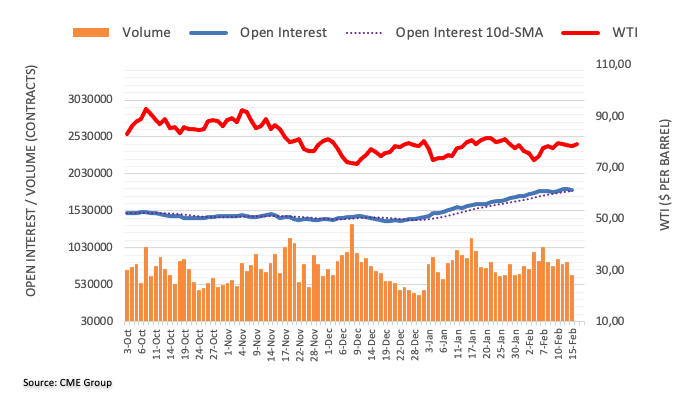
Japanese Chief Cabinet Secretary Hirokazu Matsuno said on Thursday, the Bank of Japan (BoJ) has jurisdiction over monetary policy.
Additional quotes
“Hopes BoJ works closely with government, conducts monetary policy flexibly with eyes on economic, price, financial developments.”
“Government, BoJ will guide policy to achieve structural wage rise, stable and sustained achievement of price target.”
Market reaction
USD/JPY was last seen trading at 133.72, still down 0.28% on the day.
- NZD/USD stages an intraday recovery from mid-0.6200s amid a modest USD downtick.
- A positive risk tone undermines the safe-haven buck and benefits the risk-sensitive Kiwi.
- Hawkish Fed expectations should limit the USD losses and cap the upside for the major.
The NZD/USD pair attracts some buying in the vicinity of mid-0.6200s on Thursday and reverses a part of the previous day's slide to its lowest level since January 6. The steady intraday ascent lifts spot prices to a fresh daily high, around the 0.6300 mark, during the first half of the European session, albeit lacks bullish conviction.
The US Dollar (USD) retreats from a six-week high touched on Wednesday amid a modest downtick in the US Treasury bond yields and turns out to be a key factor lending some support to the NZD/USD pair. Apart from this, a generally positive tone around the equity markets further undermines the safe-haven Greenback and benefits the risk-sensitive Kiwi. That said, the prospects for further policy tightening by the Fed should act as a tailwind for the US bond yields and limit losses for the USD.
Investors now seem convinced that the US central bank will stick to its hawkish stance for longer amid stubbornly high inflation. In fact, the markets are currently pricing in at least a 25 bps lift-off at each of the next two FOMC meetings in March and in May. Moreover, several FOMC policymakers, including Fed Chair Jerome Powell, recently stressed the need for additional interest rate hikes to fully gain control of inflation. This supports prospects for the emergence of some USD dip-buying.
Hence, it will be prudent to wait for strong follow-through buying before confirming that the NZD/USD pair's recent pullback from its highest level since June 2022 has run its course. Market participants now look to the US economic docket, featuring the Producer Price Index (PPI), the usual Weekly Initial Jobless Claims, the Philly Fed Manufacturing Index, Building Permits and Housing Starts. This, along with the US bond yields, will influence the USD and provide some impetus to the major.
Technical levels to watch
- Gold price edges higher on Thursday and draws support from a modest US Dollar weakness.
- Recession fears lend additional support to the XAU/USD, though the upside seems limited.
- Expectations for more rate hikes by Federal Reserve should act as a headwind for Gold price.
Gold price attracts some buying on Thursday and recovers a part of the previous day's losses to the $1,830 area, or its lowest level since January 6. The XAU/USD sticks to its gains through the early European session and is currently hovering near the top boundary of its daily range, around the $1,840 level.
Modest US Dollar weakness benefits Gold price amid looming recession risks
The US Dollar (USD) retreats from a six-week high touched on Wednesday amid a modest downtick in the US Treasury bond yields. This, in turn, is seen as a key factor driving some flows towards the US Dollar-denominated Gold price. Apart from this, fears of a global recession lend additional support to the safe-haven precious metal, though any meaningful upside still seems elusive.
Bets for additional rate hikes by Federal Reserve could cap XAU/USD
Investors now seem convinced that interest rates are going to remain higher for longer amid stubbornly high inflation. The bets were lifted by Tuesday's release of the Consumer Price Index (CPI) from the United States (US). In fact, the markets are currently pricing in at least a 25 bps lift-off at each of the next two Federal Open Market Committee (FOMC) meetings in March and in May.
Furthermore, several FOMC policymakers, including Fed Chair Jerome Powell, recently stressed the need for additional interest rate hikes to fully gain control of inflation. This should act as a tailwind for the US bond yields and lend support to the buck. Hence, it will be prudent to wait for a strong follow-through buying around the non-yielding Gold price before placing bullish bets.
Macro data from United States to provide some impetus to Gold price
Traders now look to the release of the US Producer Price Index (PPI), which should provide fresh cues about inflationary pressures. This, in turn, will influence expectations about the Fed's future rate-hiking campaign. Thursday's US economic docket also features the Philly Fed Manufacturing Index, the usual Weekly Initial Jobless Claims, Building Permits and Housing Starts.
This US macro data, along with the US bond yields, could drive the USD demand. Apart from this, the broader risk sentiment should allow traders to grab short-term opportunities around the Gold price. Nevertheless, the fundamental backdrop seems tilted firmly in favour of the USD bulls and suggests that the path of least resistance for the XAU/USD is to the downside.
Gold price technical outlook
From a technical perspective, the overnight downfall validates a breakdown below the 50-day Simple Moving Average (SMA) and adds credence to the negative outlook. Hence, a subsequent fall towards the $1,818-$1,817 intermediate support, en route to the $1,800 round figure, looks like a distinct possibility.
On the flip side, the $1,852-$1,853 region could act as an immediate hurdle ahead of the 50-day SMA, currently around the $1,860 level. Any further move up is more likely to attract fresh sellers and remain capped near the $1,871-$1,872 region, or the weekly high, which should now act as a key pivotal point.
Key levels to watch
EUR/GBP is once again testing the 0.89 level, GBP/USD the 1.20. A more cautious rate outlook in the UK is set to weigh on the Pound, economists at Commerzbank report.
Soft UK inflation data
“In the UK, January inflation surprised to the downside which triggered a decline in interest rate expectations.”
“At its last meeting, the BoE had already shown itself to be more cautious with regard to further interest rate hikes. The weaker inflation figures should be just what it needs to signal an early pause in interest rates. We, therefore, see the Pound rather on the weaker side.”
Economists at Westpac discuss the EUR, CAD and GBP outlook for 2023 and 2024.
Euro is expected to grind higher through 2023 and 2024
“Euro is expected to grind higher through 2023 and 2024, to USD 1.10 and USD 1.15 at the end of each year. Over the same time periods, the USD/CAD pair is similarly projected to decline to 1.29 and 1.26.”
“Sterling meanwhile will edge up to USD 1.24 then USD 1.28 by December 2023 and 2024, according to our forecasts.”
In the opinion of Economist Lee Sue Ann and Markets Strategist Quek Ser Leang at UOB Group, GBP/USD risks further retracements in the short term.
Key Quotes
24-hour view: “The sharp drop in GBP to 1.1990 yesterday came as a surprise (we were expecting GBP to range trade). Not surprisingly, the sharp and rapid drop is oversold. However, as long as 1.2100 (minor resistance is at 1.2065) is not breached, GBP could continue to decline. That said, a break of the major support at 1.1960 is unlikely today.”
Next 1-3 weeks: “Our latest narrative was from two days ago (14 Feb, spot at 1.2140) where GBP is likely to consolidate and trade between 1.2040 and 1.2260. In NY trade, GBP cracked 1.2040 and plunged to a low of 1.1990. The rapid increase in downward momentum suggests the risk for GBP has shifted to the downside. However, any decline is expected to face solid support at 1.1960. On the upside, a breach of 1.2150 (‘strong resistance’ level) would indicate that the downside risk has abated.”
Here is what you need to know on Thursday, February 16:
The US Dollar (USD) stays in a consolidation phase early Thursday's after having outperformed its major rivals on Wednesday. The market mood remains mixed in the early European session as investors await mid-tier data releases from the US that include weekly Initial Jobless Claims, January Housing Starts and Producer Price Index. Market participants will also pay close attention to comments from central bank officials.
On Wednesday, the US Census Bureau reported that Retail Sales in January rose by 3% following December's 1.1% contraction. This print beat the market expectation for an increase of 1.8% and helped the US Dollar preserve its strength in the second half of the day. Later in the American session, however, Wall Street's main indexes managed to gain traction and didn't allow the US Dollar Index to extend its rebound. US stock index futures trade virtually unchanged in the European morning on Thursday.
Meanwhile, the benchmark 10-year US Treasury bond yield built on Tuesday's gains and rose more than 1% on Wednesday. After having peaked above 3.8% during the Asian trading hours, the 10-year yield started to edge lower and was last seen losing 0.6% at 3.78%.
In the Asian session on Thursday, Australian Bureau of Statistics reported that the Unemployment Rate climbed to 3.7% in January from 3.5% in December. Employment Change in the same period arrived at -11.5K, compared to the market expectation of +20K, and weighed on the Aussie. After having dropped below 0.6870, however, AUD/USD staged a rebound and was last seen trading modestly higher on the day at 0.6915.
USD/JPY closed the third straight in positive territory on Wednesday and touched its highest level since early January at 134.35. The pair stays relatively quiet early Thursday and trades at around 134.00. A Japanese lawmaker said on Thursday that the country’s Parliament Lower House will hold a confirmation hearing on the government nominees for the Bank of Japan (BoJ) governor and deputies on February 24.
While testifying before European Parliament on Wednesday, European Central Bank President Christine Lagarde reiterated that they intend to raise key rates by 50 basis points (bps) at the March policy meeting. EUR/USD ignored this comment and ended the day with a 50 pip loss. Early Thursday, the pair holds steady at around 1.0700.
GBP/USD suffered heavy losses following the soft UK inflation data on Wednesday but managed to hold above the key 1.2000 level. The pair consolidates its losses slightly below 1.2050 in the European morning.
Gold price fell to its lowest level in over a month at $1,830 on Wednesday pressured by rising US T-bond yields. XAU/USD struggles to gather momentum early Thursday and trades in a narrow channel below $1,840.
Bitcoin surged higher and gained nearly 10% on Wednesday, touching its highest level since August near $25,000. Although BTC/USD retreated modestly early Thursday, it clings to modest daily gains at around $24,500. Similarly, Ethereum rose 8% on Wednesday before stabilizing near $1,700 on Thursday.
- WTI picks up bids to rebound from weekly low, snaps three-day downtrend.
- US Dollar pullback, hopes of more demand from China supersede bearish EIA Oil inventories.
- Fears of more Fed rate hikes, US SPR releases challenge energy bulls.
WTI crude oil snaps a three-day losing streak around $79.50, extending the previous day’s rebound from the weekly low, amid early Thursday’s sluggish markets. The black gold’s latest recovery could be linked to the market’s cautious optimism, as well as a pullback in the US Dollar from a multi-day high marked on Wednesday.
The improvement in the risk appetite could be linked to Chinese President Xi Jinping’s readiness to deepen industrial and investment cooperation with Asia. It’s worth noting that the International Energy Agency’s (IEA) latest report, published on Wednesday, also mentioned the IEA report.
On the other hand, a pullback in the US Treasury bond yields allowed the US Dollar bulls to take a breather at the multi-day high and help the commodities to lick their wounds. That said, the US 10-year Treasury bond yields retreat following the run-up to a 1.5-month high marked on Wednesday, down two basis points to near 3.78% by the press time, whereas the US Dollar Index (DXY) prints 0.15% intraday loss while easing to 103.70 at the latest, after rising to the 1.5-month high the previous day.
It should be observed that the strong US data weighed on the energy prices, via hawkish Fed bets, the previous day. Among the key data, US Retail Sales for January and the NY Empire State Manufacturing Index for February gained major attention. Following the data, the market’s bets on the Fed’s next moves, as per the FEDWATCH tool of Reuters, suggest the US central bank’s benchmark rate is to peak in July around 5.25% versus the December Federal Reserve prediction of 5.10% top rate.
Elsewhere, the official weekly oil inventory data from the Energy Information Administration (EIA) marked a notable increase in the stockpile for the week ended on February 10, to 16.283M versus 1.166M expected and 2.423M prior. The same should have favored the Oil bears but could not as the market slips into consolidation mode ahead of the second-tier US data concerning the housing market, industrial activity and producer price.
Technical analysis
Despite the latest rebound, the WTI crude oil remains between the 50-day and 100-day Simple Moving Averages (SMAs), which in turn suggests lack of conviction among traders. That said, the 50-DMA and the 100-DMA levels are $77.90 and $80.90 by the press time.
- GBP/JPY edges lower for the second straight day, though lacks follow-through selling.
- Recession fears, expectations for a hawkish BoJ shift underpin the JPY and caps gains.
- Bets that the BoE’s current rate-hiking cycle is nearing the end favour bearish traders.
The GBP/JPY cross remains on the defensive for the second straight day on Thursday, albeit manages to hold above the overnight swing low. The cross trades around the 161.20 region heading into the European session and is influenced by a combination of diverging forces.
A modest US Dollar weakness assists the British Pound to gain some positive traction, which, in turn, is seen lending some support to the GBP/JPY cross. The Japanese Yen (JPY), on the other hand, is underpinned by speculations that the Bank of Japan (BoJ) governor candidate Kazuo Ueda will dismantle the yield curve control. Apart from this, looming recession risks further benefit the JPY's relative safe-haven status and act as a headwind for the cross.
Furthermore, expectations that the Bank of England's (BoE) current rate-hiking cycle is nearing the end hold back traders from placing bullish bets around the British Pound and cap the GBP/JPY cross. The bets were lifted by softer-than-expected UK consumer inflation figures released on Wednesday, which could allow the UK central bank to soften its stance. This, in turn, favours bearish traders and supports prospects for some meaningful downside for the cross.
That said, the lack of any strong follow-through selling warrants some caution in the absence of any relevant market-moving economic releases from the UK. Hence, it will be prudent to wait for a sustained break below the overnight swing low, around the 160.65 region, before confirming that the GBP/JPY pair's recent move-up witnessed over the past two weeks or so has run its course.
Technical levels to watch
USD/CNY has consolidated sideways over the past month following the decline in December. Economists at Danske Bank expect the pair to head gradually higher over the coming months.
Moderate increase on renewed USD strength
“The rapid change in China has paved the way for a weakening of the USD both versus the CNY and the EUR. However, we still see the path to be lower for the cross over the next year.”
“A resumption of a stronger USD is also expected to drive a small rebound in USD/CNY. Forecast: 6.80 (1M), 6.95 (3M), 7.10 (6M), 7.10 (12M)”
“For EUR/CNY, we look for 7.21 in 3M and 7.24 in 12M.”
- The index comes under pressure following recent monthly peaks.
- DXY surpassed the 104.00 level for the first time since January.
- Weekly Claims, Philly Fed Index, Producer Prices next on tap.
The USD Index (DXY), which tracks the greenback vs. a bundle of its main rivals, trades slightly on the defensive below Wednesday’s tops above the 104.00 yardstick.
USD Index looks at data
The index remains within the current consolidative theme following a bullish attempt to levels just beyond the 104.00 hurdle on Wednesday.
In fact, the dollar regained traction on the back of firmer-than-expected results from US fundamentals as well as the unabated hawkish narrative from Fed speakers. Against that, speculation of a higher terminal rate and a Fed’s tighter-for-longer stance remains well on the rise and appears behind the recent bid bias in the dollar.
It will be an interesting session data wise in the US, as usual Initial Claims are due in the first turn seconded by Producer Prices, Building Permits, Housing Starts and the Philly Fed Manufacturing Index.
In addition, Cleveland Fed L.Mester (2024 voter, hawk), St.Louis Fed J.Bullard (2025 voter, hawk) and FOMC Governor L.Cook (permanent voter, centrist) are all due to speak later in the NA session.
What to look for around USD
The dollar remains within a consolidative phase near the 104.00 level against the backdrop of the persistent range bound mood and ahead of further key results in the US docket.
The probable pivot/impasse in the Fed’s normalization process narrative is expected to remain in the centre of the debate along with the hawkish message from Fed speakers, all after US inflation figures for the month of January showed consumer prices are still elevated, the labour market remains tight and the economy maintains its resilience.
The loss of traction in wage inflation – as per the latest US jobs report - however, seems to lend some support to the view that the Fed’s tightening cycle have started to impact on the still robust US labour markets somewhat.
Key events in the US this week: Building Permits, Housing Starts, Initial Jobless Claims, Philly Fed Index (Thursday) – CB Leading Index (Friday).
Eminent issues on the back boiler: Rising conviction of a soft landing of the US economy. Slower pace of interest rate hikes by the Federal Reserve vs. shrinking odds for a recession in the next months. Fed’s pivot. Geopolitical effervescence vs. Russia and China. US-China trade conflict.
USD Index relevant levels
Now, the index is retreating 0.07% at 103.73 and the breach of 100.82 (2023 low February 2) would open the door to 100.00 (psychological level) and finally 99.81 (weekly low April 21 2022). On the other hand, the next up barrier emerges at 104.11 (monthly high February 15) seconded by 105.63 (2023 high January 6) and then 106.44 (200-day SMA).
Citing a government source, Reuters reported on Thursday that India's Gold imports plunged 76% in January from a year earlier to a 32-month low, as record high domestic prices dented physical demand.
The drop in Gold imports could be also attributed to jewelers postponing their purchases, hoping for a reduction in import duty.
Additional takeaways
India “imported 11 tonnes of gold in January, compared with 45 tonnes a year earlier.”
“In value terms, January imports dropped to $697 million from $2.38 billion a year earlier.”
Related reads
- China's Gold imports in 2022 hit highest level since 2018 – WGC
- Gold Price Forecast: XAU/USD rebounds but downside bias still intact below 50DMA
- Silver price bounces off 10-week low to snap three-day downtrend.
- Cautious optimism, pullback in yields underpin US Dollar’s retreat from multi-day high and favor XAG/USD buyers.
- China, second-tier US data may entertain Silver traders ahead of next week’s FOMC Minutes.
Silver price (XAG/USD) retreats from intraday high but remains mildly bid near $21.70 during the early hours of Thursday’s European session.
The bright metal’s latest pullback, which marks the first daily loss in four, could be the resettlement of the previous bias as Western traders return to their desks. However, a lack of major data/events joins the cautious optimism backed by Chinese news to put a floor under the XAG/USD price.
The risk profile, however, improves as Chinese President Xi Jinping shows readiness to deepen industrial and investment cooperation with Asia. On the same line were the upbeat comments from Chinese Finance Minister Liu Kun who said that the 2023 fiscal revenue will grow this year, though the growth rate will not be too high, per the Chinese state media.
It should be noted that the strong US data bolstered the hawkish Fed bias and weighed on the Silver price to print a 10-week low the previous day. Among the key data, US Retail Sales for January and the NY Empire State Manufacturing Index for February gained major attention. Following the data, the market’s bets on the Fed’s next moves, as per the FEDWATCH tool of Reuters, suggest the US central bank’s benchmark rate is to peak in July around 5.25% versus the December Federal Reserve prediction of 5.10% top rate.
Amid these plays, the S&P 500 Futures print mild gains around 4,165 while extending the previous day’s gains whereas the US 10-year Treasury bond yields retreat following the run-up to a 1.5-month high marked on Wednesday, down two basis points to near 3.78% by the press time. Further, the US Dollar Index (DXY) prints 0.15% intraday loss while easing to 103.70 at the latest, after rising to the 1.5-month high the previous day.
Given the light calendar for the day and the week, the Silver price may remain depressed while the second-tier US data concerning the housing market, industrial activity and producer prices can entertain traders. However, major attention will be given to the next week’s Minutes of the latest Federal Open Market Committee (FOMC) monetary policy meeting.
Technical analysis
Despite the corrective bounce amid oversold RSI (14) on the daily chart, the Silver price remains below the 100-DMA hurdle, currently around the $22.00 round figure, which in turn keeps the XAG/USD sellers hopeful to visiting the 200-DMA level surrounding $21.00.
Open interest in gold futures markets extended the decline for yet another session on Wednesday, this time by around 2.6K contracts according to preliminary readings from CME Group. Volume followed suit and resumed the downtrend, now by around 43.3K contracts.
Gold faces solid contention around $1800
Wednesday’s marked drop in gold prices was on the back of shrinking open interest and volume, suggesting that a sustained decline seems not favoured in the very near term. On the downside, there is a strong contention around the key $1800 mark per ounce troy for the time being.

Further decline in EUR/USD is likely on a sustained breach of the 1.0655 level, suggest Economist Lee Sue Ann and Markets Strategist Quek Ser Leang at UOB Group.
Key Quotes
24-hour view: “Our view for EUR to trade within a range of 1.0695/1.0775 was incorrect as it dropped to 1.0659 before rebounding to close at 1.0689 (0.43%). While the rebound amid oversold conditions has reduced the likelihood of further declines, EUR may test the 1.0655 support level before a more sustained recovery is likely. The major support at 1.0615 is unlikely to come under threat. Resistance is at 1.0715, a breach of 1.0735 would indicate that the current downward pressure has eased.”
Next 1-3 weeks: “We highlighted yesterday (15 Feb, spot at 1.0735) that the recent EUR weakness has ended and EUR has moved into a consolidation phase and is likely to trade between 1.0655 and 1.0815. We did not anticipate the rapid manner in which EUR moved towards the bottom of the expected range (EUR dropped to 1.0659 in NY trade). Downward momentum is building again but EUR has to break and stay below 1.0655 before a sustained decline is likely. The chance of a sustained decline will increase as long as EUR does not move above 1.0760 (‘strong resistance’ level) within the next couple of days. Looking ahead, the next support below 1.0655 is a major level at 1.0615.”
- GBP/USD prints mild gains while paring the biggest daily loss in a fortnight.
- Bearish chart formation contradicts bullish MACD signals to challenge immediate run-up.
- Sustained trading beyond 1.2080-85 resistance confluence needed to recall buyers.
GBP/USD remains on the bear’s radar despite the latest rebound to 1.2050, up 0.15% intraday heading into Thursday’s London open. In doing so, the Cable pair struggles to justify the first daily gains in three while consolidating the heaviest slump in two weeks, marked the previous day.
That said, a three-day-old bearish flag chart formation joins the quote’s sustained trading below the weekly support line, now resistance, to keep sellers hopeful. It’s worth noting, however, that the bullish chart formation and the US Dollar’s retreat amid a sluggish session seem to challenge the Cable pair sellers.
As a result, the traders should wait for a clear downside break of the 1.2020 level, comprising the lower line of the flag, to initiate fresh entries.
Following that, January’s bottom surrounding 1.1840 may act as an intermediate halt during the theoretical slump targeting the mid-1.1700s.
Alternatively, the aforementioned support-turned-resistance line from February 07 joins the 200-Hour Moving Average (HMA) to highlight the 1.2080-85 as the short-term key upside hurdle.
In a case where the GBP/USD buyers manage to cross the 1.2085 resistance confluence, they not only defy the bearish chart formation but also strengthen the odds of a run-up toward the weekly top surrounding 1.2270.
GBP/USD: Hourly chart
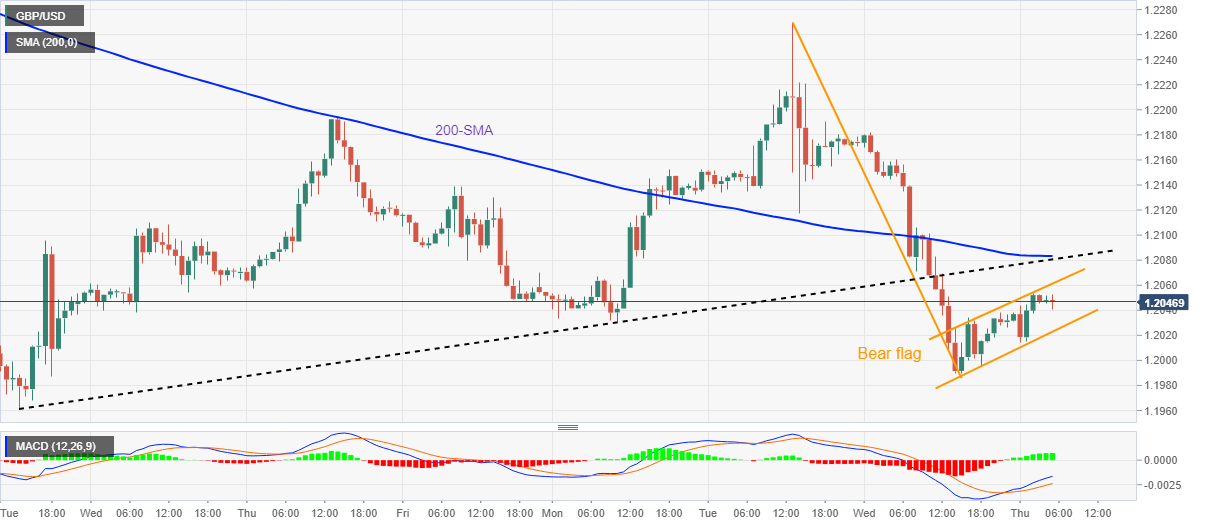
Trend: Further downside expected
- USD/CHF clings to mild losses while snapping two-day winning streak.
- Retreat in US Treasury bond yields, DXY joins failure to cross six-week-old resistance to trigger pullback moves.
- China, US debt-ceiling talks seem underpinning cautious optimism but hawkish Fed bets keep buyers hopeful.
USD/CHF prints mild losses around 0.9225 as it portrays the first daily fall in three during early Thursday in Europe. In doing so, the Swiss Franc (CHF) pair benefits from the broad US Dollar pullback amid inactive markets while consolidating the latest gains.
Market sentiment improves as Chinese President Xi Jinping shows readiness to deepen industrial and investment cooperation with Asia. Following him were upbeat comments from Chinese Finance Minister Liu Kun who said that the 2023 fiscal revenue will grow this year, though the growth rate will not be too high, per the Chinese state media.
On a different page, the chatter surrounding the US debt-ceiling crisis, as warned by the US Congressional Budget Office (CBO) on Wednesday per Reuters, seemed to have raised hopes of a faster solution to the big problem in the upcoming days and probed the US Treasury bond yields’ upside.
The same joined a lack of major data/events to challenge the US Dollar Index (DXY) that retreat drops 0.20% to 103.65 at the latest, after rising to the 1.5-month high the previous day.
It should be noted that the strong US data propelled the US bond yield and the greenback the previous day amid escalating hopes of more rate hikes from the Fed. On Wednesday, US Retail Sales growth jumped to 3.0% YoY in January versus 1.8% expected and -1.1% prior. Further, The Retail Sales ex-Autos grew by 2.3% in the same period, compared to analysts' estimate of +0.8%. On the same line, the NY Empire State Manufacturing Index for February improved to a three-month high of -5.8 versus -18.0 expected and -32.9 market forecasts. Alternatively, the US Industrial Production marked 0.0% MoM figures for January, compared to analysts’ estimate of 0.5% and -0.7% previous readings, but failed to push back the hawkish bias surrounding the Federal Reserve’s (Fed) next move. That said, the market’s bets on the Fed’s next moves, as per the FEDWATCH tool of Reuters, suggest the US central bank’s benchmark rate is to peak in July around 5.25% versus the December Federal Reserve prediction of 5.10% top rate.
Against this backdrop, the S&P 500 Futures print mild gains around 4,165 while extending the previous day’s gains whereas the US 10-year Treasury bond yields retreat following the run-up to a 1.5-month high marked on Wednesday, down two basis points to near 3.78% by the press time.
Looking ahead, a light calendar may allow the USD/CHF to remain depressed while the second-tier US data concerning the housing market, industrial activity and producer prices can entertain traders ahead of the next week’s Minutes of the latest Federal Open Market Committee (FOMC) monetary policy meeting.
Technical analysis
A downward-sloping trend line from January 06 joins the 50-DMA to highlight 0.9250 as the key upside hurdle for the USD/CHF buyers to cross before taking control. Even so, bullish MACD signals and a steady RSI (14) line hints at the pair’s upside potential.
- USD/JPY snaps three-day uptrend as it retreats from six-week high.
- Convergence of one-month-old previous support line, ascending trend line from the last Friday challenges bears.
- Firmer oscillators add strength to the upside bias while 200-SMA acts as additional downside filter.
USD/JPY prints the first loss-making day in four as bulls take a breather around the 1.5-month high during early Thursday. In doing so, the Yen pair flirts with the 133.60 support confluence heading into the European session.
Although the overbought RSI (14) triggered the USD/JPY retreat, a convergence of the resistance-turned-support line from January 18 and a one-week-old ascending trend line challenges the Yen pair sellers around 133.60. On the same line are the bullish MACD signals and the pair’s higher-low formation on the Daily chart.
It’s worth noting, however, that the quote’s further recovery needs validation from the 134.00 round figure to challenge the latest high of 134.35.
Following that, the previous peak of around 134.80 and the December 2022 top near 138.20 will be in focus.
On the flip side, a clear break of the 133.60 support confluence can quickly drag the USD/JPY price towards the 200-Simple Moving Average (SMA) support of 130.70.
Should the quote remains weak past 130.70, the 130.00 round figure and the previous weekly bottom surrounding 129.80 could please the USD/JPY bears before directing them to the one-month-old ascending support line, close to 129.00 by the press time.
Overall, USD/JPY remains on the bull’s radar despite the latest pullback from the multi-day high.
USD/JPY: Four-hour chart
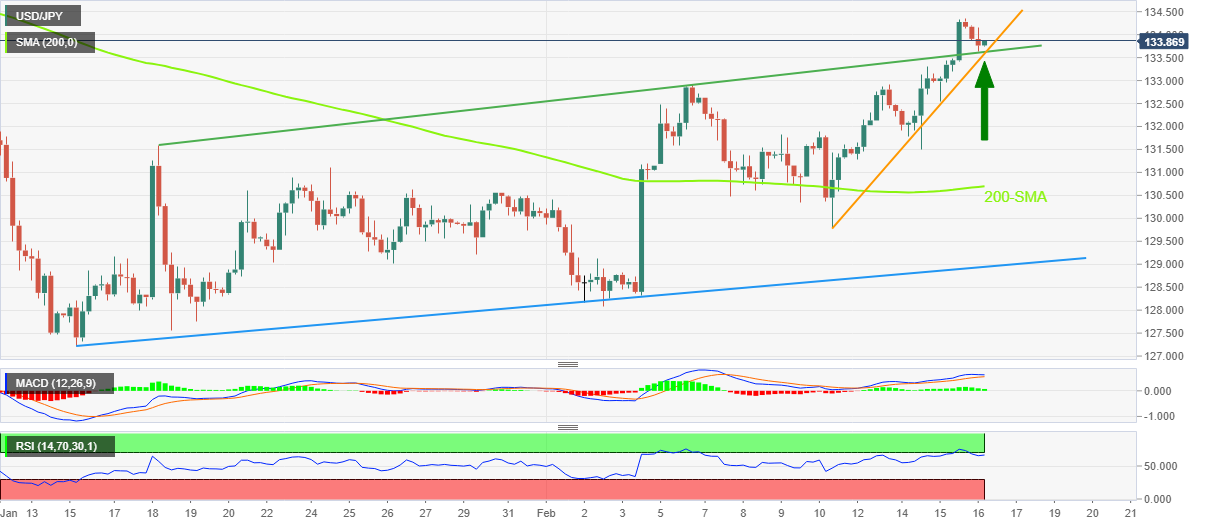
Trend: Limited downside expected
- USD/CAD meets with some supply and extends the overnight pullback from the weekly high.
- An uptick in oil prices underpins the Loonie and exerts pressure amid modest USD weakness.
- Hawkish Fed expectations should help limit deeper USD losses and lend support to the major.
The USD/CAD pair comes under some selling during the Asian session on Thursday and moves away from the weekly high, around the 1.3440 region touched the previous day. The pair currently trades around the 1.3380-1.3375 region and is pressured by a combination of factors.
Crude oil prices gain some positive traction and snap a three-day losing streak amid hopes for a strong recovery in fuel demand. In fact, both the Organization of Petroleum Exporting Countries (OPEC) and the International Energy Agency (IEA) forecast a rebound in crude demand later this year. This helps offset a substantial rise in the US crude inventories and acts as a tailwind for the black liquid, which, in turn, underpins the commodity-linked Loonie. Apart from this, a modest US Dollar weakness weighs on the USD/CAD pair.
In fact, the USD Index, which tracks the Greenback against a basket of currencies, extends the overnight pullback from a six-week high amid retreating US Treasury bond yields. This, along with a generally positive tone around the equity markets, is seen denting demand for the safe-haven buck. That said, the prospects for further policy tightening by the Fed should limit the downside for the US bond yields and the USD. This, in turn, warrants some caution before positioning for any further depreciating move for the USD/CAD pair.
Investors seem convinced that the US central bank will continue to hike interest rates in the wake of stubbornly high inflation. The bets were lifted by the US CPI report and hawkish comments by several Fed policymakers on Tuesday. Furthermore, the upbeat US monthly Retail Sales figures released on Wednesday indicated that the economy remains resilient despite rising borrowing costs. This should allow the Fed to stick to its hawkish stance for longer and supports prospects for the emergence of some USD dip-buying.
Market participants now look forward to the release of the US Producer Price Index (PPI), due later during the early North American session. This, along with the US bond yields and the broader risk sentiment, will influence the Greenback. Apart from this, traders will take cues from oil price dynamics to grab short-term opportunities around the USD/CAD pair.
Technical levels to watch
- EUR/USD gains some positive traction on Thursday and is supported by a combination of factors.
- ECB’s Lagarde reiterates the intention to raise rates by 50 bps in March, which benefits the Euro.
- A positive risk tone undermines the safe-haven USD and remains supportive of the positive move.
- Hawkish Fed expectations, recession fears should limit the USD losses and cap any further gains.
The EUR/USD pair attracts some buying during the Asian session on Thursday and recovers a part of the previous day's losses. The pair is currently placed just above the 1.0700 round figure, up around 0.20% for the day, and for now, seems to have stalled this week's rejection slide from the 1.0800 mark.
The shared currency draws support from hawkish remarks by the European Central Bank (ECB) President Christine Lagarde, which, along with a modest US Dollar downtick, act as a tailwind for the EUR/USD pair. In a speech to the European Parliament, Lagarde reiterated that the ECB intends to raise interest rates by another 50 bps at the next policy meeting in March. She further added that future policy decisions will continue to be data-dependent and follow a meeting-by-meeting approach.
The USD, on the other hand, extends the overnight pullback from a six-week high and is weighed down by retreating US Treasury bond yields. Apart from this, a generally positive tone around the equity markets further seems to undermine the safe-haven buck, which, in turn, is seen as another factor lending support to the EUR/USD pair. That said, the prospects for further policy tightening by the Federal Reserve should help limit the downside for the US bond yields and the Greenback. Investors now seem convinced that the Fed will stick to its hawkish stance amid stubbornly high inflation.
The bets were lifted by the US CPI report and hawkish commentary by several FOMC members on Tuesday. Adding to this, the upbeat US Retail Sales data released on Wednesday indicated that the economy remains resilient despite rising borrowing costs, which should allow the US central bank to keep interest rates higher for longer. This, along with looming recession risks, might hold back the USD bears from placing aggressive bets and contribute to capping gains for the EUR/USD pair. Even from a technical perspective, the pair already seems to have confirmed a breakdown below the 50-day SMA.
The aforementioned fundamental backdrop and the technical setup suggest that the path of least resistance for the EUR/USD pair is to the downside. Hence, any subsequent move up might still be seen as a selling opportunity and runs the risk of fizzling out rather quickly. In the absence of any relevant market-moving economic data from the Eurozone, the USD price dynamics will continue to play a key role in influencing the major. Later during the early North American session, trades will take cues from the release of the US Producer Price Index (PPI) for some meaningful impetus.
Technical levels to watch
- Gold price bounces off six-week low to pare the biggest daily loss in a fortnight.
- China-led cautious optimism in markets joins US debt ceiling concerns to probe US bond bears and US Dollar buyers.
- Second-tier US data, risk catalysts eyed amid a light calendar.
Gold price (XAU/USD) prints mild gains around $1,840 as traders lick their wounds amid early Thursday’s sluggish trading. In doing so, the bright metal pares the longest daily fall in a fortnight by taking clues from cautious optimism in the markets and a retreat of the US Dollar.
That said, headlines surrounding China and the US debt ceiling seem to have favored the latest improvement in the risk profile. That said, China President Xi Jinping crossed wires while showing readiness to deepen industrial and investment cooperation with Asia. Following him were upbeat comments from Chinese Finance Minister Liu Kun who said that the 2023 fiscal revenue will grow this year, though the growth rate will not be too high, per the Chinese state media. Furthermore, the chatter surrounding the US debt-ceiling crisis, as warned by the US Congressional Budget Office (CBO) on Wednesday per Reuters, seemed to have raised hopes of a faster solution to the big problem in the upcoming days and probed the US Treasury bond yields’ upside.
It should be noted that the World Gold Council’s (WGC) update suggesting China’s heavy Gold imports in 2022, the biggest since 2018, also seemed to have put a floor under the XAU/USD price, especially after the previous day’s fall.
Above all, the US data-led hawkish Fed bias and a run-up in the US Treasury bond yields seem to challenge the Gold buyers.
Against this backdrop, the S&P 500 Futures print mild gains around 4,165 while extending the previous day’s gains whereas the US 10-year Treasury bond yields retreat following the run-up to a 1.5-month high marked on Wednesday, down two basis points to near 3.78% by the press time. That said, the US Dollar Index (DXY) dropped 0.20% to 103.65 at the latest, after rising to the 1.5-month high the previous day.
Moving on, Gold traders should pay attention to second-tier US data concerning the housing market, industrial activity and producer prices for fresh impulse.
Gold price technical analysis
Despite the latest rebound of the Gold price, a two-week-long descending resistance line, around $1,850 by the press time, challenges the buyers. Also doubting the upside bias is the bearish MACD signals and the downbeat RSI (14), but not oversold.
Even if the Gold price manages to cross the $1,850 hurdle, the 50-DMA level surrounding $1,862 and the previous support line from late November 2022, close to $1,905 at the latest, could test the XAU/USD bulls before giving them control.
Alternatively, Gold sellers may wait for a clear downside break of a two-month-old horizontal support area around $1,820 before excelling their dominance.
In that case, the $1,800 round figure and $1,750 may test the XAU/USD bears before directing them to the late November 2022 swing low of around $1,720.
Gold price: Daily chart
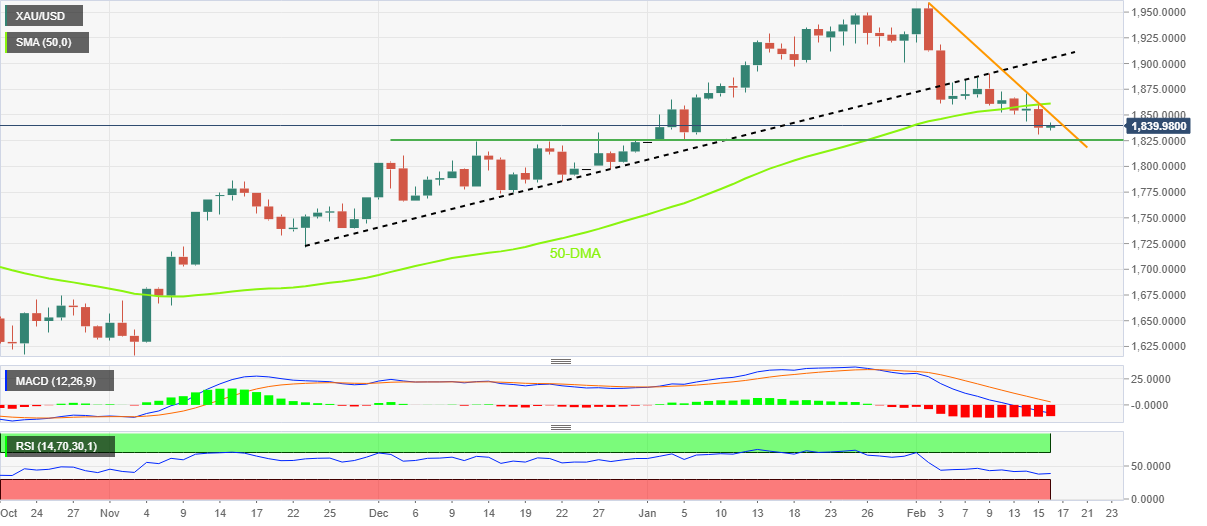
Trend: Further downside expected
- USD/INR extends pullback from four-month-old resistance line amid sluggish markets.
- US Dollar pares gains around six-week high as Treasury bond yields retreat.
- China-linked headlines also weigh on prices amid cautious optimism in Asia.
USD/INR takes offers to refresh the intraday low near 82.65 while extending the previous day’s U-turn from the short-term key trend line resistance during early Thursday. In doing so, the Indian Rupee (INR) pair benefits from the mildly positive sentiment in Asia, as well as the US Dollar’s pullback from a six-week high marked on Wednesday.
Risk appetite improves in Asia, despite looming Fed concerns and mixed headlines from China, not to forget the US debt ceiling woes. The reason could be linked to a retreat in the US Treasury bond yields. Earlier in the day, China President Xi Jinping crossed wires while showing readiness to deepen industrial and investment cooperation with Asia. Following him were upbeat comments from Chinese Finance Minister Liu Kun who said that the 2023 fiscal revenue will grow this year, though the growth rate will not be too high, per the Chinese state media.
Elsewhere, fears of witnessing the US debt-ceiling crisis, as warned by the US Congressional Budget Office (CBO) on Wednesday per Reuters, suggested a faster solution to the big problem in the upcoming days and probed the US Treasury bond yields’ upside.
Amid these plays, the S&P 500 Futures print mild gains around 4,165 while extending the previous day’s gains whereas the US 10-year Treasury bond yields retreat following the run-up to a 1.5-month high marked on Wednesday, down two basis points to near 3.78% by the press time.
It’s worth noting that the recently firmer Oil prices and the US-data-backed hawkish expectations from the Federal Reserve (Fed) can probe the USD/INR bears ahead of the second-tier US data concerning the housing market, industrial activity and producer prices.
Technical analysis
USD/INR portrays a clear U-turn from a downward-sloping resistance line from October 19, poking the 10-DMA support amid easing the bullish bias of the MACD by the press time.
With this, the Indian Rupee (INR) pair is likely declining toward a three-week-old ascending support line, close to 82.50 by the press time.
However, the USD/INR bears should remain worried unless witnessing a clear downside break of the 50-DMA support of 82.24.
Meanwhile, the USD/INR recovery needs validation from the four-month-old descending trend line, around the 83.00 round figure at the latest, to recall the pair buyers.
USD/INR: Daily chart
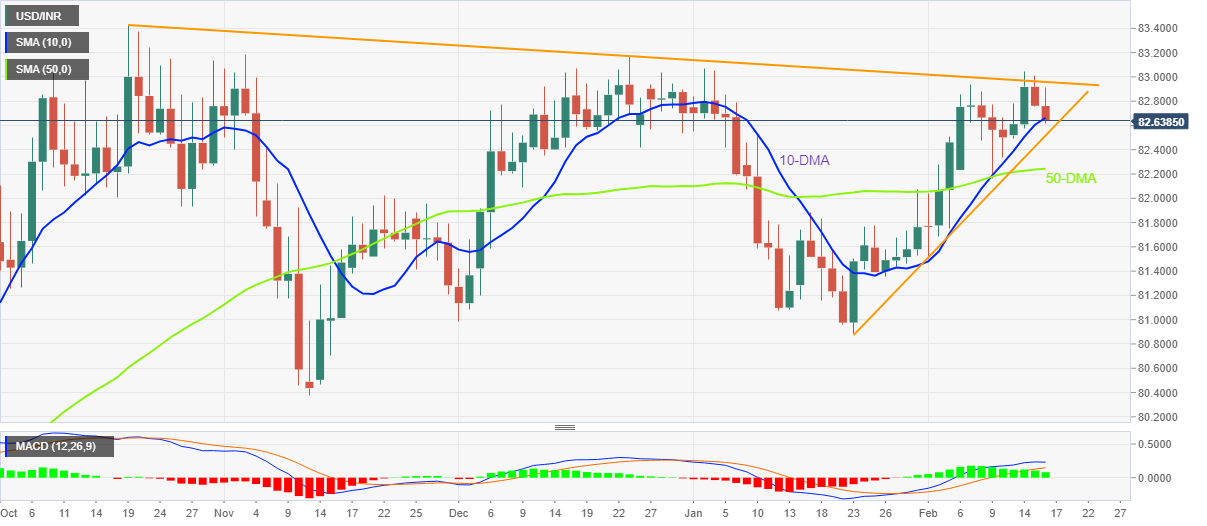
Trend: Limited downside expected
China’s Finance Minister Liu Kun said in a statement on Thursday, the country’s fiscal revenue and expenditure situation is still grim.
Additional quotes
“2023 fiscal revenue will grow this year.”
“Though the growth rate will not be too high.”
Market reaction
AUD/USD is unfazed by the above 0.6900 following the above comments. The pair is currently trading at 0.6911, up 0.12% on the day.
According to a vast majority of economists surveyed by Reuters, the European Central Bank (ECB) could continue with rate hikes at least at two more meetings, bringing up the terminal rate to 3.25% in the second quarter of this year.
Key takeaways
All 57 of them polled in the Feb. 10-15 period expected a deposit rate hike to 3.00% at the March 16 meeting.
Twenty-six of 56 respondents expected a hike of 25 basis points next quarter, 19 expected a 50-basis-point move, while nine said no move and a further two said the ECB would accelerate its pace of tightening and deliver a 75-basis-point increase.
The poll suggested euro area inflation would continue to fall, it was not expected to reach the ECB's 2.0% target until 2025 at least.
None of the 22 respondents to another question said the ECB would cut rates this year.
Gross domestic product was predicted to expand 0.4% this year before growth accelerates to 1.2% in 2024.
Related reads
-
EUR/USD Price Analysis: Bounces off 50-day EMA but stays on bear’s radar
- AUD/USD rebounds from 0.6865-70 support confluence to consolidate biggest daily loss in two weeks.
- Convergence of head-and-shoulders’ neckline, two-month-old ascending trend line challenges bears.
- Buyers need validation from 21-DMA to retake control.
AUD/USD grinds near intraday high surrounding 0.6915 as it reverses the losses post Australian employment data release during early European morning on Thursday.
In doing so, the Aussie pair portrays a recovery move from the 0.6865-70 support confluence that encompasses the lower line of the six-week-old head-and-shoulders (H&S) bearish chart pattern and a two-month-old ascending trend line.
It’s worth noting, however, that the bearish MACD signals and the steady RSI (14) line join the Aussie pair’s sustained trading below the 21-DMA to challenge the bullish bias unless the quote rises past the immediate DMA hurdle surrounding the 0.7000 psychological magnet.
Even so, the weekly near 0.7030 and the monthly peak of 0.7157 could challenge the AUD/USD bulls afterward.
In a case where the AUD/USD buyers remain in the driver’s seat past 0.7157, the May 2022 high near 0.7285 will be on their radars.
On the contrary, a successful downside break of 0.6865 key support level is necessary for the Aussie pair bears to keep the reins.
Following that, the 200-DMA surrounding 0.6800 and the late 2022 low near 0.6630 may act as validation points during the theoretical south-run targeting the 0.6500 round figure.
Overall, AUD/USD remains bearish but the downside move needs validation from 0.6865.
AUD/USD: Daily chart
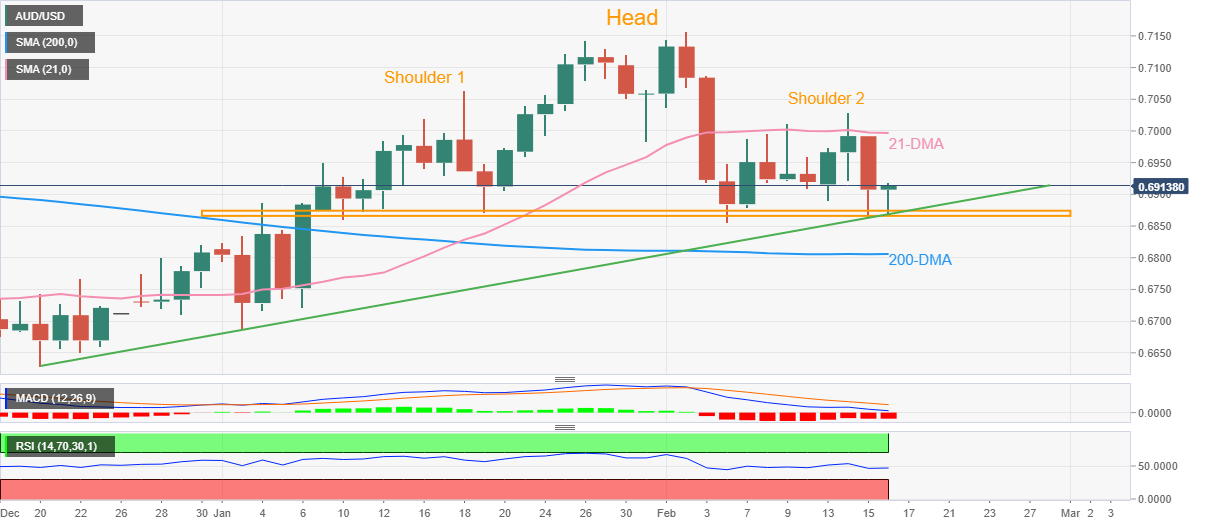
Trend: Limited recovery expected
According to the latest data published by the World Gold Council (WGC) on Wednesday, China's gold imports rebounded strongly in the second half of last year.
Additional takeaways
China's Gold imports increased by 64% year-on-year last year, totaling upto 1,343 mt of gold, the highest level since 2018.
China’s Gold imports reached 157 mt in December.
The total amount of gold withdrawn from the Shanghai Gold Exchange in January this year was 140 mt, down 25% from the same period last year, mainly affected by the CNY holiday.
Earlier this month, the People's Bank of China reported that it increased its holdings of gold by 970,000 ounces to 64.64 million ounces in December last year, increasing its holdings of gold for the second consecutive month.
Market reaction
Gold price is holding higher ground near $1,842 on its rebound from six-week troughs of $1,831, underpinned by a broadly weaker US Dollar and resurgent Chinese Gold demand.
- Market sentiment improves during a sluggish session, amid mixed headlines.
- Upbeat comments from China President Xi, Finance Minister Liu Kun add to the risk-on mood.
- Concerns surrounding US debt ceiling expiration probes US Dollar bulls.
- Strong US data underpins upbeat Treasury bond yields and US Dollar, despite recent pullback.
Risk profile improves during early Thursday as headlines from China allow traders to pare the previous day’s losses amid a dicey session. Even so, the hawkish concerns surrounding the Federal Reserve (Fed), backed by the strong US data, keep the bears hopeful.
That said, the S&P 500 Futures print mild gains around 4,165 while extending the previous day’s gains whereas the US 10-year Treasury bond yields retreat following the run-up to a 1.5-month high marked on Wednesday, down one basis point to near 3.80% by the press time.
Earlier in the day, China President Xi Jinping crossed wires while showing readiness to deepen industrial and investment cooperation with Asia. “Willing to share ultra-large-scale markets, complete industrial systems and advanced technologies with central Asian countries,” said China’s Xi.
Following him were upbeat comments from Chinese Finance Minister Liu Kun who said that the 2023 fiscal revenue will grow this year, though the growth rate will not be too high, per the Chinese state media.
On the same line were fears of witnessing the US debt-ceiling crisis, as warned by the US Congressional Budget Office (CBO) on Wednesday per Reuters, which in turn suggests a faster solution to the big problem in the upcoming days.
It’s worth noting that Wall Street managed to close with mild gains only because of the day-end corrective rebound while the stocks in the Asia-Pacific region trade mixed by the press time, which in turn suggests a cautious mood in the market.
On Wednesday, US Retail Sales growth jumped to 3.0% YoY in January versus 1.8% expected and -1.1% prior. Further, The Retail Sales ex-Autos grew by 2.3% in the same period, compared to analysts' estimate of +0.8%. On the same line, the NY Empire State Manufacturing Index for February improved to a three-month high of -5.8 versus -18.0 expected and -32.9 market forecasts. Alternatively, the US Industrial Production marked 0.0% MoM figures for January, compared to analysts’ estimate of 0.5% and -0.7% previous readings, but failed to push back the hawkish bias surrounding the Federal Reserve’s (Fed) next move.
Following the US data, the market’s bets on the Fed’s next moves, as per the FEDWATCH tool of Reuters, suggest the US central bank’s benchmark rate is to peak in July around 5.25% versus the December Federal Reserve prediction of 5.10% top rate.
Looking ahead, the second-tier US data concerning the housing market, industrial activity and producer prices may entertain traders.
Also read: Forex Today: US Dollar strength continues amid resilient American economy
A Japanese lawmaker said on Thursday, the country’s Parliament Lower House will hold a confirmation hearing on the government nominees for the Bank of Japan (BoJ) governor and deputies on February 24.
Japan Parliament Lower House hearing for the BoJ governor will be held in the morning of February 24, deputies in the afternoon, the lawmaker added.
Citing Chief Cabinet Secretary Matsuno, the lawmaker said that “there was no information leakage in BoJ governor nomination process,” adding that the “government offered BoJ governor job to the candidate on February 13.
Lawmaker further saud that the Lower House may broadcast online BOJ governor nominee's hearing if the candidate agrees.
Market reaction
USD/JPY is back below the 134.00 level, correcting in tandem with the US Dollar so far this Thursday. The spot is trading at 133.77, down 0.24% on the day, at the time of writing.
| Raw materials | Closed | Change, % |
|---|---|---|
| Silver | 21.628 | -1.03 |
| Gold | 1836.14 | -0.94 |
| Palladium | 1465.36 | -1.77 |
- NZD/USD picks up bids to probe two-day downtrend near six-week low.
- Support-turned-resistance line from early January guards immediate upside.
- 200-SMA appears a tough nut to crack for bulls, sellers can aim for 2023 bottom.
- Downbeat oscillators, sustained trading below the key technical levels favor sellers.
NZD/USD renews intraday high near 0.6290 as it bounces off a 1.5-month low marked the previous day during Thursday’s mid-Asian session.
In doing so, the Kiwi pair takes clues from the nearly oversold RSI (14) to portray a corrective bounce after declining in the last two consecutive days, not to forget mentioning that it posted the biggest daily loss in two weeks on Wednesday.
It should, however, be noted that the recovery moves need to cross the six-week-old previous support line, now resistance around 0.6400, to convince intraday buyers.
Even so, a fortnight-old descending trend line and the 200-bar Simple Moving Average (SMA), respectively near 0.6365 and 0.6385 in that order, could challenge the pair’s further upside.
In a case where the NZD/USD pair remains firmer past 0.6385, the 0.6400 could act as a validation point for the rally targeting the monthly peak surrounding 0.6540.
On the contrary, pullback moves should break the 0.6250 horizontal support to recall the NZD/USD bears.
Following that, the previous monthly low of 0.6190 and late November 2022 bottom around 0.6155 will gain the pair seller’s attention.
Overall, NZD/USD is likely to remain bearish despite the latest rebound.
NZD/USD: Four-hour chart

Trend: Bearish
- GBP/USD grinds near intraday high as it consolidates the biggest daily loss in a fortnight.
- UK inflation, employment numbers raise doubts on BoE rate hike bias.
- US data propel hawkish Fed bets and propel yields, US Dollar.
- Mixed sentiment allowed Cable bears to take a breather ahead of second-tier US data, UK Retail Sales.
GBP/USD seesaws around the intraday high of 1.2044 as it pares the previous day’s heavy losses during sluggish early hours of trading on Thursday. That said, the Cable pair dropped the most in a fortnight the previous day after the UK data poured cold water on the face of Bank of England (BoE) hawks. Also drowning the quote were upbeat US data that propelled the bets of higher Federal Reserve (Fed) interest rates.
In addition to the lack of major data/events, the risk-positive headlines from China and fears surrounding the US debt ceiling also seemed to have helped the GBP/USD pair in trimming the latest losses.
China President Xi Jinping recently crossed wires while showing readiness to deepen industrial and investment cooperation with Asia. “Willing to share ultra-large-scale markets, complete industrial systems and advanced technologies with central Asian countries,” said China’s Xi.
On the other hand, fears of witnessing the US debt-ceiling crisis, as warned by the US Congressional Budget Office (CBO) on Wednesday per Reuters, seem to probe the US Dollar bulls at the multi-day high and allow the GBP/USD to lick its wounds.
Amid these plays, the US Dollar Index (DXY) eases to 103.70, after rising to a fresh six-week high the previous day. Further, S&P 500 Futures rise 0.20% but whereas the US 10-year Treasury bond yields retreat following the run-up to a 1.5-month high marked on Wednesday.
On Wednesday, the UK Consumer Price Index (CPI) dropped to 10.1% YoY in January versus 10.3% market forecasts and 10.5% previous readings. With this, the headline inflation marks the third monthly decline after rising to the 41-year high in October. More importantly, the Core CPI, which excludes volatile food and energy items, slid to 5.8% on a yearly basis compared to the 6.2% expected and 6.3% in previous readings.
Alternatively, US Retail Sales growth jumped to 3.0% YoY in January versus 1.8% expected and -1.1% prior. Further, The Retail Sales ex-Autos grew by 2.3% in the same period, compared to analysts' estimate of +0.8%. On the same line, the NY Empire State Manufacturing Index for February improved to a three-month high of -5.8 versus -18.0 expected and -32.9 market forecasts. Alternatively, the US Industrial Production marked 0.0% MoM figures for January, compared to analysts’ estimate of 0.5% and -0.7% previous readings, but failed to push back the hawkish bias surrounding the Federal Reserve’s (Fed) next move.
It should be noted that the market’s bets on the Fed’s next moves, as per the FEDWATCH tool of Reuters, suggest the US central bank’s benchmark rate is to peak in July around 5.25% versus the December Federal Reserve prediction of 5.10% top rate.
Moving on, a light calendar in the UK may allow GBP/USD to grind higher ahead of the US data concerning the housing market, industrial activity and producer prices. Following that, the UK Retail Sales for January, up for publishing on Thursday, will be eyed for clear directions.
Technical analysis
GBP/USD rebounds from a six-week-old support line near 1. 2000. The recovery moves, however, remain elusive considering the quote’s sustained U-turn from the 50-DMA and the bearish MACD signals.
China’s state media is reporting some encouraging comments from Chinese President Xi Jinping on Thursday.
Key quotes
“Willing to share ultra-large-scale markets, complete industrial systems and advanced technologies with central Asian countries.”
“Seek to deepen pragmatic cooperation, achieve mutual benefit and win-win results with central Asian countries.”
“To promote high-quality regional economic development and build a closer China-central Asia community with a shared future.”
Deepening industrial and investment cooperation between China and the five central Asian countries will maintain the stability of regional supply chains.”
Market reaction
AUD/USD is erasing the Australian jobs data-led losses on the above comments, trading flat at 0.6900, as of writing.
- WTI bulls are moving in with eyes on a break of major trendline resistance.
- WTI bears will likely show their might near $79.50.
WTI is now on the backside of the bearish channel's resistance which would be expected to act as a countertrend with the short squeeze in play, putting the shorts from the start of the week under heat.
WTI H1 chart
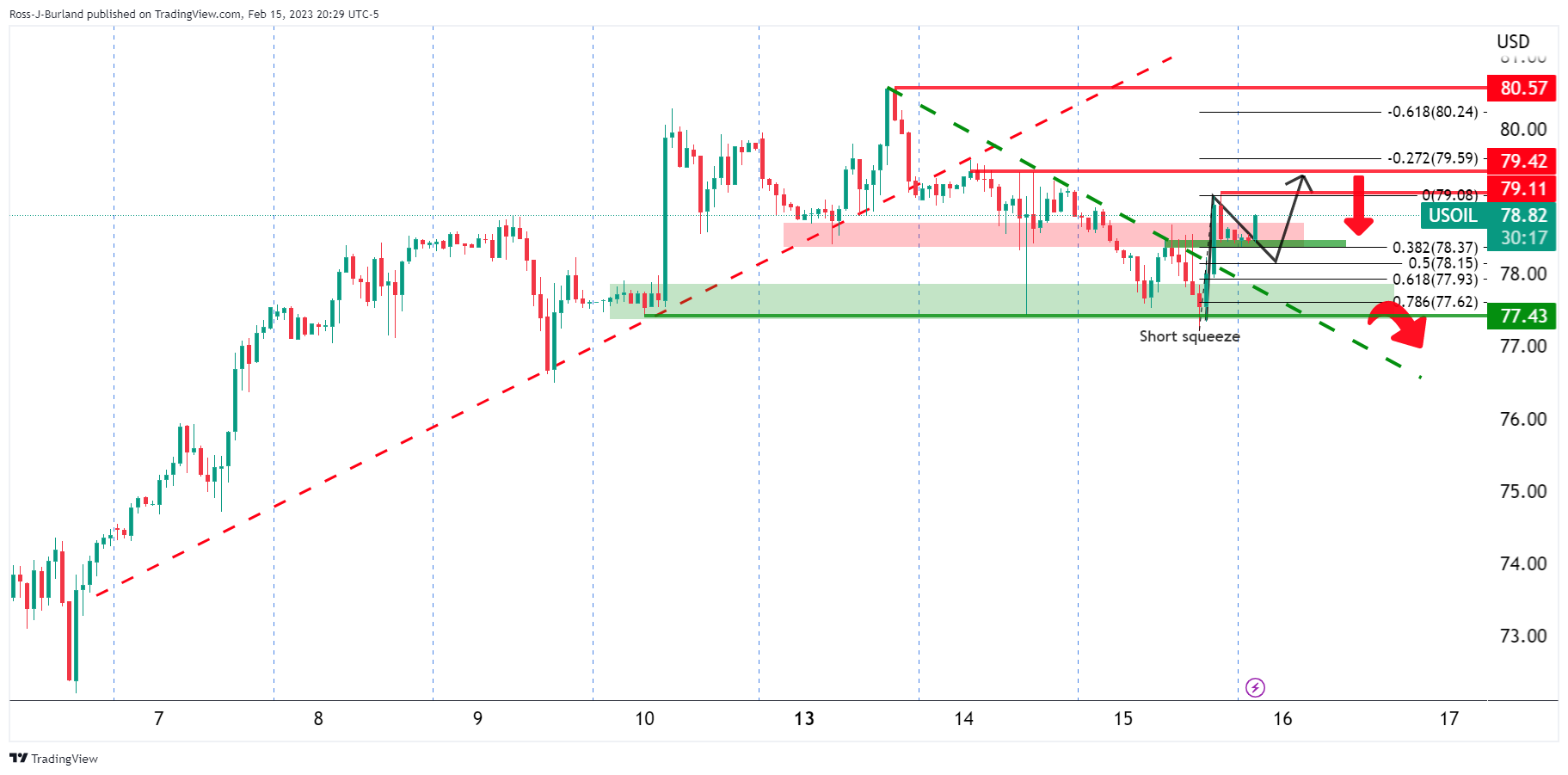
The bulls can target a break of the $79.00 level to open risk to $79.50 and even beyond to target the $80.50s highs. However, the bears will be keen to defend $79.50 which puts the spotlight back on a break of $77.50 that opens risk to a move to the downside.
With that being said, from a daily perspective, there can be an argument made for a bullish outlook as follows:
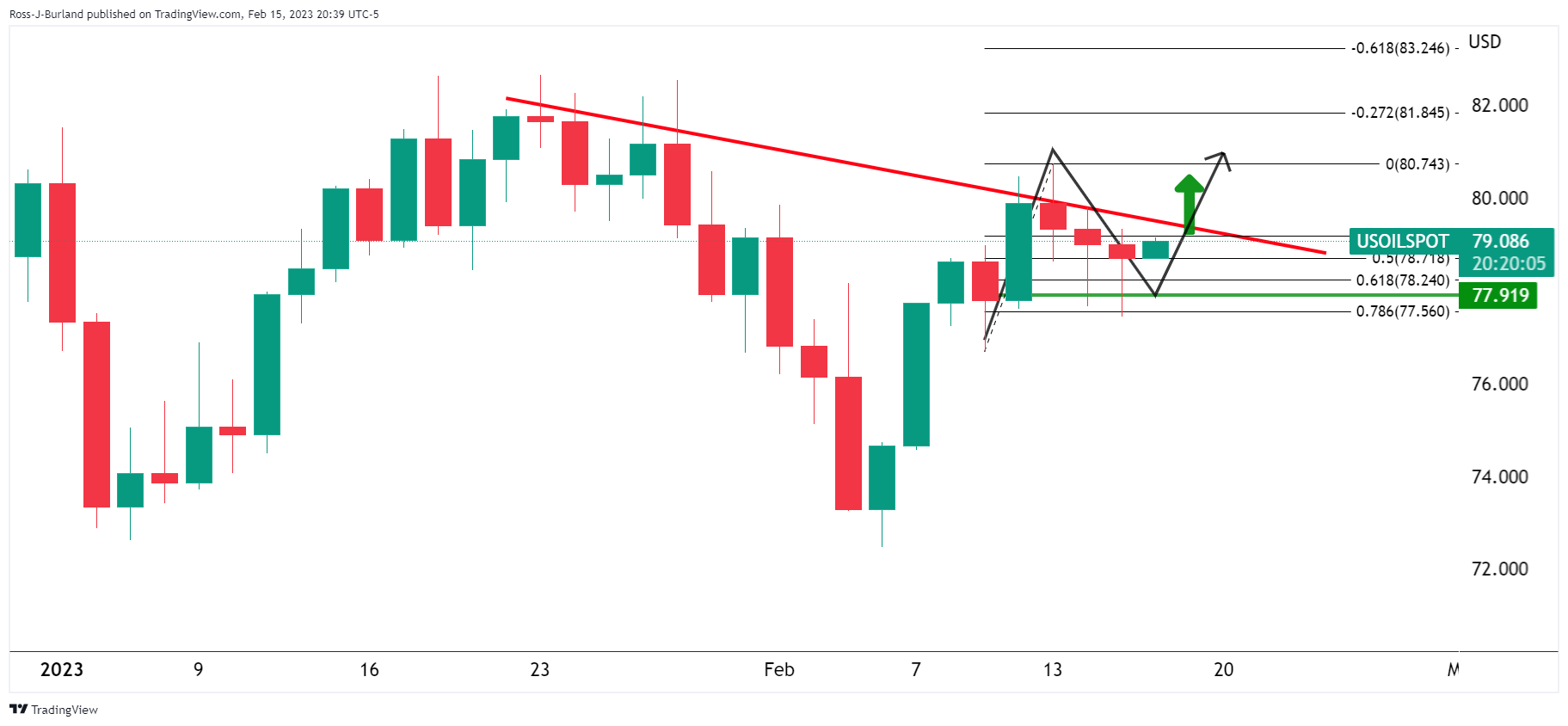
Bulls have remained committed over the course of the past week in accordance with the overall bullish cycle. With price holding above the 61.8%, there are prospects of a break of the trendline resistance for territories high up in the $80s.
- EUR/USD picks up bids to pare the previous day’s losses.
- 50-day EMA probes bears on the way to January’s low.
- Clear U-turn from 21-day EMA, downside break of three-month-old ascending trend line favor sellers.
EUR/USD renews its intraday high near 1.0705 as it consolidates the previous day’s losses during early Thursday. In doing so, the major currency pair prints mild gains while bouncing off the 50-day Exponential Moving Average (EMA).
However, the quote’s sustained U-turn from the 21-day EMA, marked earlier in the week, joins the clear downside break of the previous support line from November to keep the bears hopeful. It’s worth noting that the bearish MACD signals and steady RSI (14) line also strengthen the downside bias.
As a result, the EUR/USD sellers remain hopeful despite the latest rebound from the short-term key EMA around 1.0680 by the press time. It should be noted that the weekly low surrounding 1.0655 adds to the downside filters.
That said, a successful break of the 1.0655 support could quickly drag the EUR/USD bears toward the previous monthly low near 1.0480. During the fall, the 1.0600 and the 1.0500 round figure may act as intermediate halts.
Meanwhile, the 21-day EMA level of 1.0758 guards the quote’s further recovery before highlighting the support-turned-resistance line from the last November, close to 1.0775 by the press time.
Following that, a two-week-old horizontal resistance near 1.0800-05 could act as the last defense of the EUR/USD bears.
EUR/USD: Daily chart

Trend: Further downside expected
- Gold price holds lower ground near the six-week bottom, marked the previous day.
- Upbeat United States data, hawkish Federal Reserve bets underpin US Treasury bond yields’ run-up and favor XAU/USD bears.
- Second-tier US statistics may entertain Gold traders ahead of next week’s Federal Open Market Committee (FOMC) Minutes.
Gold price (XAU/USD) remains depressed around $1,835 after posting the biggest daily fall in two weeks around the 1.5-month low. That said, the yellow metal portrays the market’s inaction during early Thursday but stays on the bear’s radar amid firmer United States Treasury bond yields and the US Dollar amid hawkish Federal Reserve (Fed) bets.
Gold price drops as United States data propels Treasury bond yields, US Dollar
Gold price remains on the bear’s radar, despite recent inaction, as upbeat United States economics underpin the hawkish bias surrounding the Federal Reserve’s (Fed) next moves and fuel the US Treasury bond yields, as well as the US Dollar.
That said, US Retail Sales growth jumped to 3.0% YoY in January versus 1.8% expected and -1.1% prior. Further, The Retail Sales ex-Autos grew by 2.3% in the same period, compared to analysts' estimate of +0.8%. On the same line, the NY Empire State Manufacturing Index for February improved to a three-month high of -5.8 versus -18.0 expected and -32.9 market forecasts. Alternatively, the US Industrial Production marked 0.0% MoM figures for January, compared to analysts’ estimate of 0.5% and -0.7% previous readings, but failed to push back the hawkish bias surrounding the Federal Reserve’s (Fed) next move.
Considering the data, the US 10-year Treasury bond yields seesaw around a six-week high, marked the previous day, while the US Dollar Index (DXY) bulls take a breather after rising to a 1.5-month top as the key US data hints at a further increase in the Federal Reserve’s (Fed) interest rates.
That said, the market’s bets on the Fed’s next moves, as per the FEDWATCH tool of Reuters, suggest that the US central bank rates are to peak in July around 5.25% versus the December Federal Reserve prediction of 5.10% top rate.
Geopolitical tension, light calendar also weigh on XAU/USD
Other than the data-backed broad US Dollar strength, the lack of major catalysts and the ongoing US-China tension, as well as the US political risks, also exert downside pressure on the Gold price.
The ongoing chatter surrounding balloon shooting and the story behind the US-China spying recently soured the sentiment. On the same line could be the fears of witnessing the US debt-ceiling crisis, as warned by the US Congressional Budget Office (CBO) on Wednesday per Reuters.
Nothing major to watch for Gold traders ahead of FOMC Minutes
Moving on, the second-tier US data concerning the housing market, industrial activity and producer prices can entertain the Gold traders ahead of the next week’s Minutes of the latest Federal Open Market Committee (FOMC) monetary policy meeting. It’s worth noting that the fresh jump in the Fed bets and upbeat data keeps the XAU/USD bulls hopeful before then.
Gold price technical analysis
Be it a U-turn from the 50-bar Simple Moving Average (SMA) or the clear downside break of a fortnight-old support line, now resistance, the Gold price has it all to challenge the previous monthly low.
Adding strength to the downside bias are the bearish signals from the Moving Average Convergence and Divergence (MACD) indicator. However, oversold conditions of the Relative Strength Index (RSI) line, placed at 14, signal limited room for the XAU/USD towards the south.
As a result, a two-month-old horizontal support area surrounding $1,820 gains the Gold seller’s attention. Should the quote fails to bounce off the stated support zone, lows marked during late December 2022 around $1,797 and $1,785 could lure the XAU/USD bears.
Meanwhile, Gold’s recovery needs validation from the two-week-old support-turned-resistance line, close to $1,847 by the press time.
Even so, a convergence of the 50-SMA and a downward-sloping trend line from February 03, around $1,865, appears a tough nut to crack for the XAU/USD buyers. It should be noted that the 200-SMA level of $1,893 and the $1,900 round figure act as the last defense of the metal sellers.
Overall, the Gold price remains bearish but the downside room appears limited.
Gold price: Four-hour chart
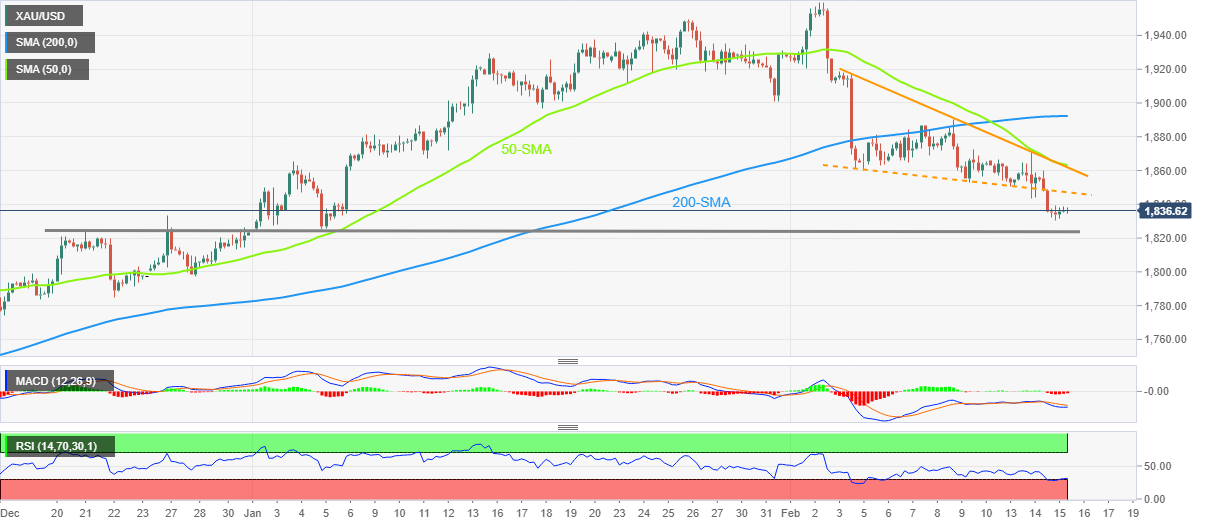
Trend: Limited downside expected
In recent trade today, the People’s Bank of China (PBOC) set the yuan at 6.8519 vs. the last close of 6.8515.
About the fix
China maintains strict control of the yuan’s rate on the mainland.
The onshore yuan (CNY) differs from the offshore one (CNH) in trading restrictions, this last one is not as tightly controlled.
Each morning, the People’s Bank of China (PBOC) sets a so-called daily midpoint fix, based on the yuan’s previous day's closing level and quotations taken from the inter-bank dealer.
- AUD/NZD sinks on the back of a poor Aussie jobs data outcome.
- RBNZ next week expected to hike rates by 50 basis points, RBA is put back in question.
AUD/NZD is under pressure following the Australian Employment Change and jobs data released by the Australian Bureau of Statistics arrived as a major disappointment, weighing on the Aussie across the board. At the time of writing, the cross is trading offered near 1.0970, but a touch off the lows scored on the knee-jerk to the data. The pair had fallen to a low of 1.0965 from 1.1018.
Aussie jobs data
- Australia Employment Change Jan: -11.5K (est 20.0K; prev -14.6K).
- Unemployment Rate Jan: 3.7% (est 3.5%; prev 3.5%).
- Full Time Empl Change Jan: -43.3K (prev 17.6K).
- Part Time Empl Change Jan: 31.8K (prev -32.2K).
- Participation Rate Jan: 66.5% (est 66.6%; prev 66.6%).
Jobs are down and the Unemployment Rate is up for January and it comes in stark contrast to the Reserve Bank of Australia Governor Lowe and Deputy Governor Bullock's appearances in front of the Senate Economics Legislation Committee yesterday. The pair had been laying out the reasons the Board expects further cash rate hikes will be needed:
"We want to get inflation down because it's dangerous… It's corrosive. It hurts people. It damages income inequality and if it stays high it leads to higher interest rates and more unemployment.”
Meanwhile, analysts at Westpac Bank argued that the Reserve Bank of New Zealand will again use next Wednesday’s Monetary Policy Statement to emphasise the scale of its battle against inflation. ''We’re expecting a 50 basis point increase in the Official Cash Rate to 4.75%, and market opinion has also swung in that direction over recent weeks.''
- AUD/JPY drops 50 pips as Australia inflation, employment numbers disappoint Aussie buyers.
- Looming bear cross on MACD adds strength to the downside bias.
- 100-EMA, 200-EMA challenge bears before directing them to monthly low.
AUD/JPY lures sellers with an interesting head-and-shoulders bearish chart pattern following the downbeat prints of Australia’s inflation and employment numbers during early Thursday. That said, the cross-currency pair dropped nearly 50 pips to refresh an intraday low of around 92.00 by the press time.
Also read: AUD/USD plummets below 0.6900 on downbeat Aussie inflation, employment data
Not only the weekly bearish chart formation but the looming bear cross on the MACD also highlights the pair’s importance for the sellers.
However, a clear downside break of the stated pattern’s neckline, around 91.95 by the press time becomes necessary to confirm the theoretical south-run towards the 90.70 levels.
It should be noted that the 100 and 200-bar Exponential Moving Averages (EMAs) could challenge the AUD/JPY bears around 92.00 and 91.75 respectively while the monthly low surrounding 90.20 and the 90.00 round figure may please the sellers past the theoretical target.
Alternatively, recovery moves remain elusive unless the quote remains below the recent swing high of 92.67.
Even so, the monthly peak of 93.06 and the mid-December 2022 swing high of 93.35 could probe the AUD/JPY bulls.
In a case where the AUD/JPY price remains firmer past 93.35, the 94.00 round figure and October 2022 high near 95.75 will be in the spotlight.
AUD/JPY: Four-hour chart
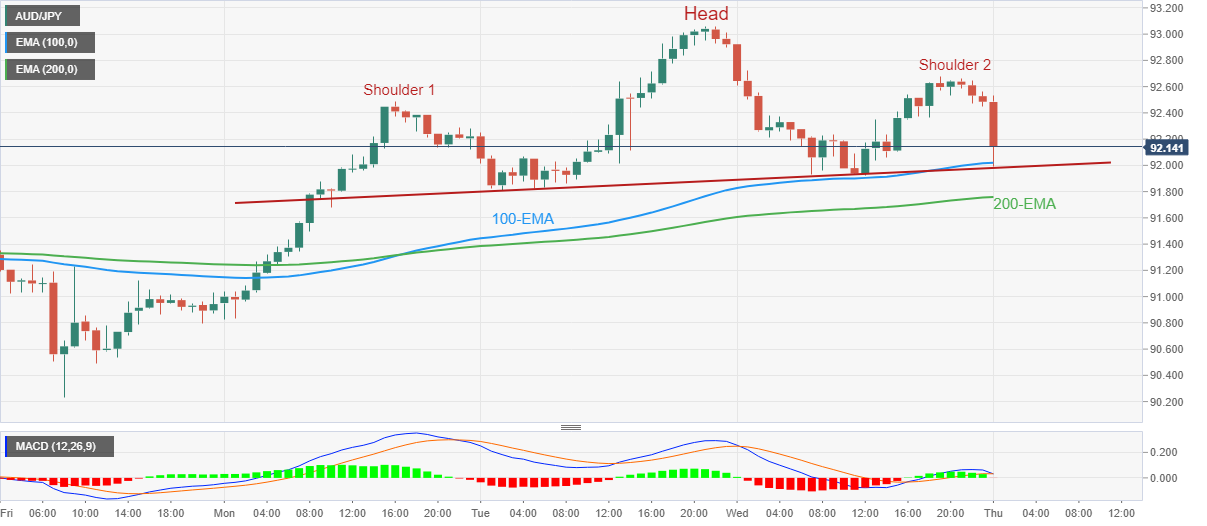
Trend: Further downside expected
- AUD/USD takes offers to refresh intraday low, sellers approach the weekly bottom marked the previous day.
- Australia Consumer Inflation Expectations for February eased to 5.1%.
- Aussie Employment Change came offered negative surprise, Unemployment Rate rose to 3.7% during January.
- Hawkish Fed bets, RBA’s struggle to gain market confidence keep bears hopeful.
AUD/USD stands on slippery grounds as sellers rush towards the weekly low of 0.6864, marked the previous day, following a nearly 40 pip of slump on the downbeat Australian inflation and employment numbers. That said, the Aussie pair marked the biggest daily loss in a fortnight the previous day as the US Dollar jumped to a six-week high amid strong US data.
That said, Australia’s headline Employment Change offered a negative surprise of -11.5K versus 20.0K expected and -14.6K prior while the Unemployment Rate rose to 3.47% versus 3.5% expected and prior.
Also read: Breaking: AUD/USD drops over 30 pips on Aussie jobs data disappointment
Earlier in the day, Australia’s Consumer Inflation Expectations for February also eased to 5.1% versus 5.6% market forecasts and previous readouts.
Given the downbeat employment and inflation data, the cautious comments from Reserve Bank of Australia (RBA) Governor Philip Lowe join the increasing market bets on the hawkish Fed moves to weigh on the AUD/USD prices.
That said, the market’s bets on the Fed’s next moves, as per the FEDWATCH tool of Reuters, suggest that the US central bank rates are to peak in July around 5.25% versus the December Federal Reserve prediction of 5.10% top rate.
It’s worth observing that the hawkish Fed bets weigh on the market sentiment and the AUD/USD prices even as the US Dollar Index (DXY) takes a breather around 103.80 after rising to a fresh six-week high the previous day. While portraying the mood, S&P 500 Futures remain indecisive whereas the US 10-year Treasury bond yields remain sidelined near the 1.5-month high marked on Wednesday.
Looking ahead, risk catalysts and the second-tier US data concerning the housing market, industrial activity and producer prices will be eyed for clear directions but major attention will be given to the central bank chatters.
Technical analysis
A U-turn from the 3.5-month-old previous support line, around 0.7005 by the press time, keeps AUD/USD bears hopeful but the 50-DMA and the 200-DMA challenge the Aussie pair’s further downside around 0.6885 and 0.6800 respectively.
The Australian Employment Change and jobs data released by the Australian Bureau of Statistics has been released as follows and is a disappointment, weighing on the Aussie:
- Australia Employment Change Jan: -11.5K (est 20.0K; prev -14.6K).
- Unemployment Rate Jan: 3.7% (est 3.5%; prev 3.5%).
- Full Time Empl Change Jan: -43.3K (prev 17.6K).
- Part Time Empl Change Jan: 31.8K (prev -32.2K).
- Participation Rate Jan: 66.5% (est 66.6%; prev 66.6%).
AUD/USD update
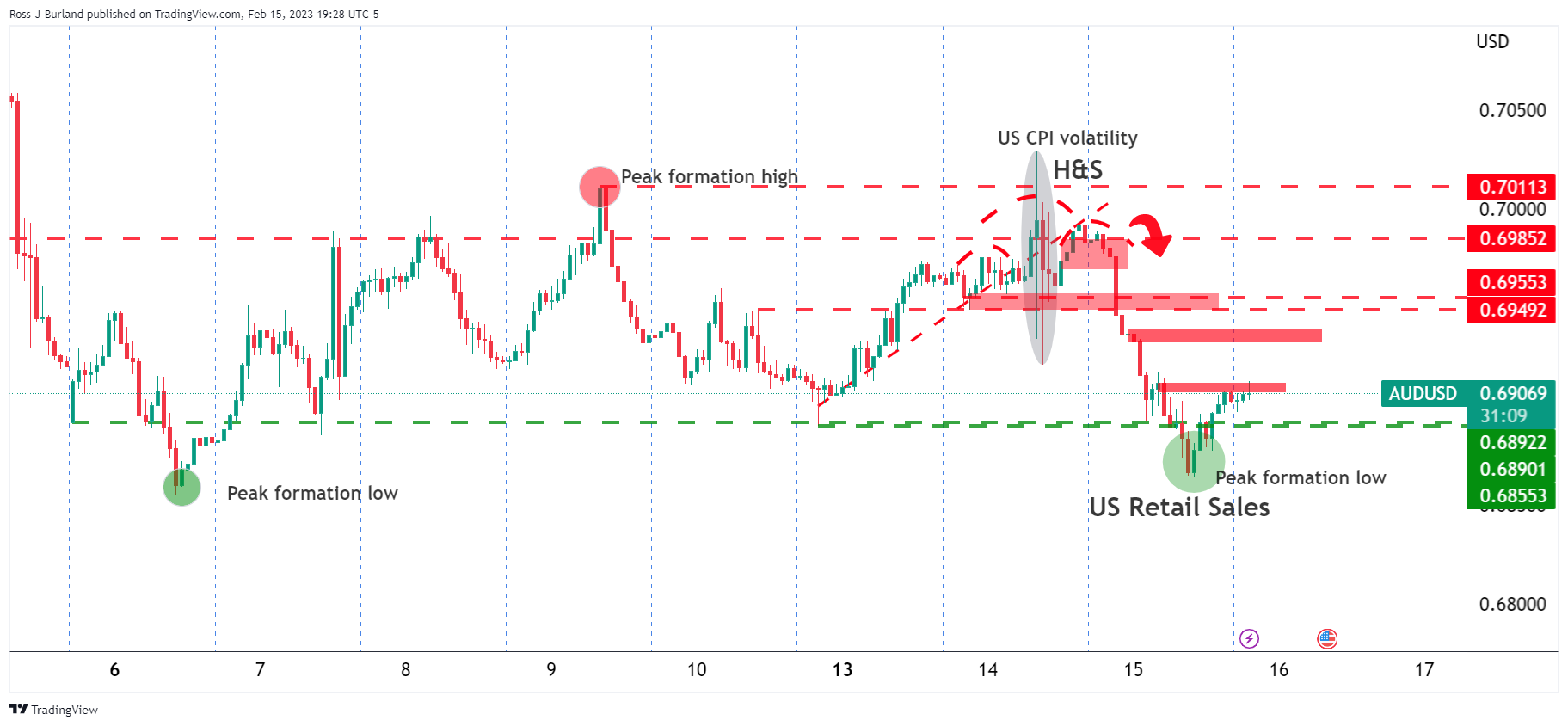
(Prior to the data above)
(Knee jerk reaction below)

The Aussie is under pressure on the Unemployment Rate disappointment and big miss in the Employment Change:
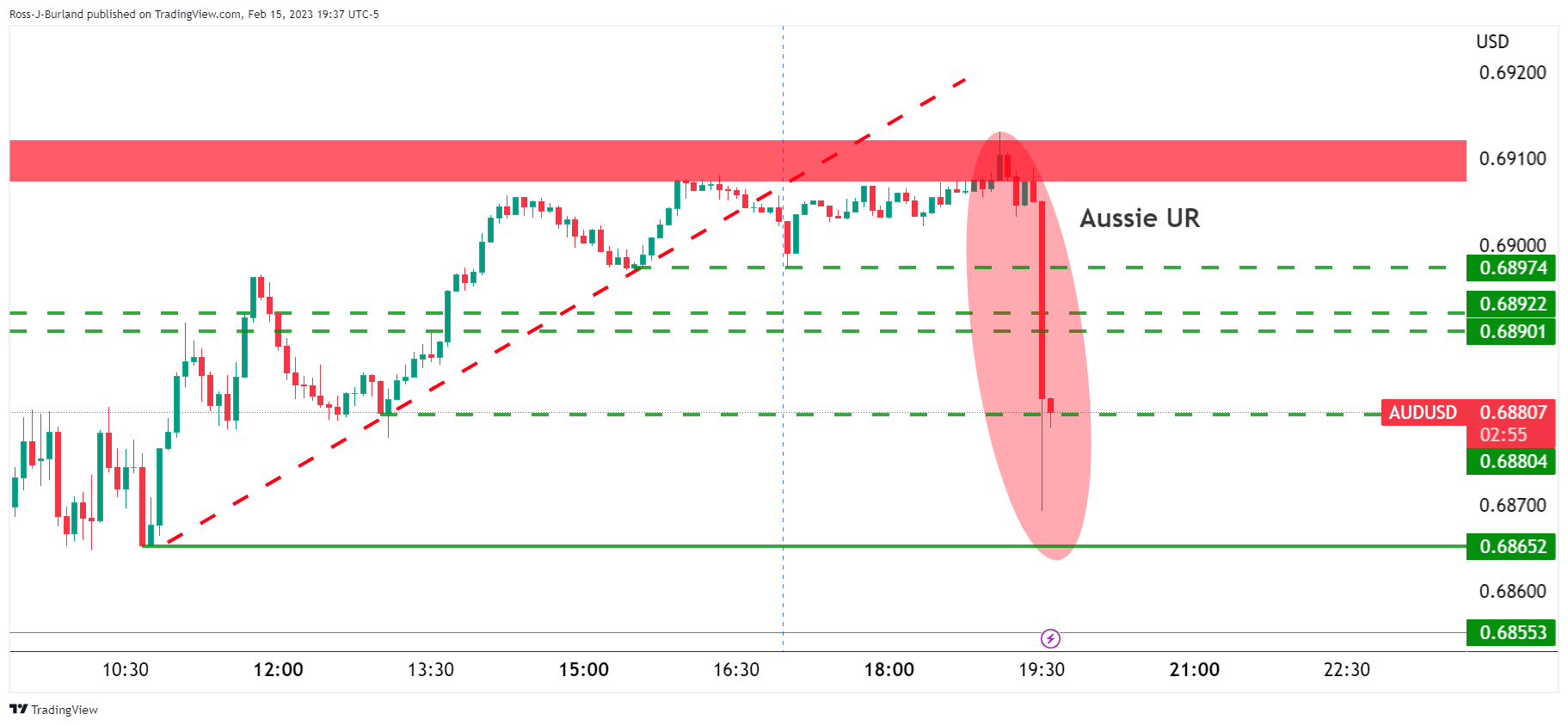
AUD/USD has dropped heavily on the back of the data and a break of the recent 0.6865 lows is on the cards for the day ahead.
In prior analysis, AUD/USD Price Analysis: Bulls are forced to the edge of the abyss, a bearish thesis was drawn as follows:
''Should the bears commit below 0.6920:
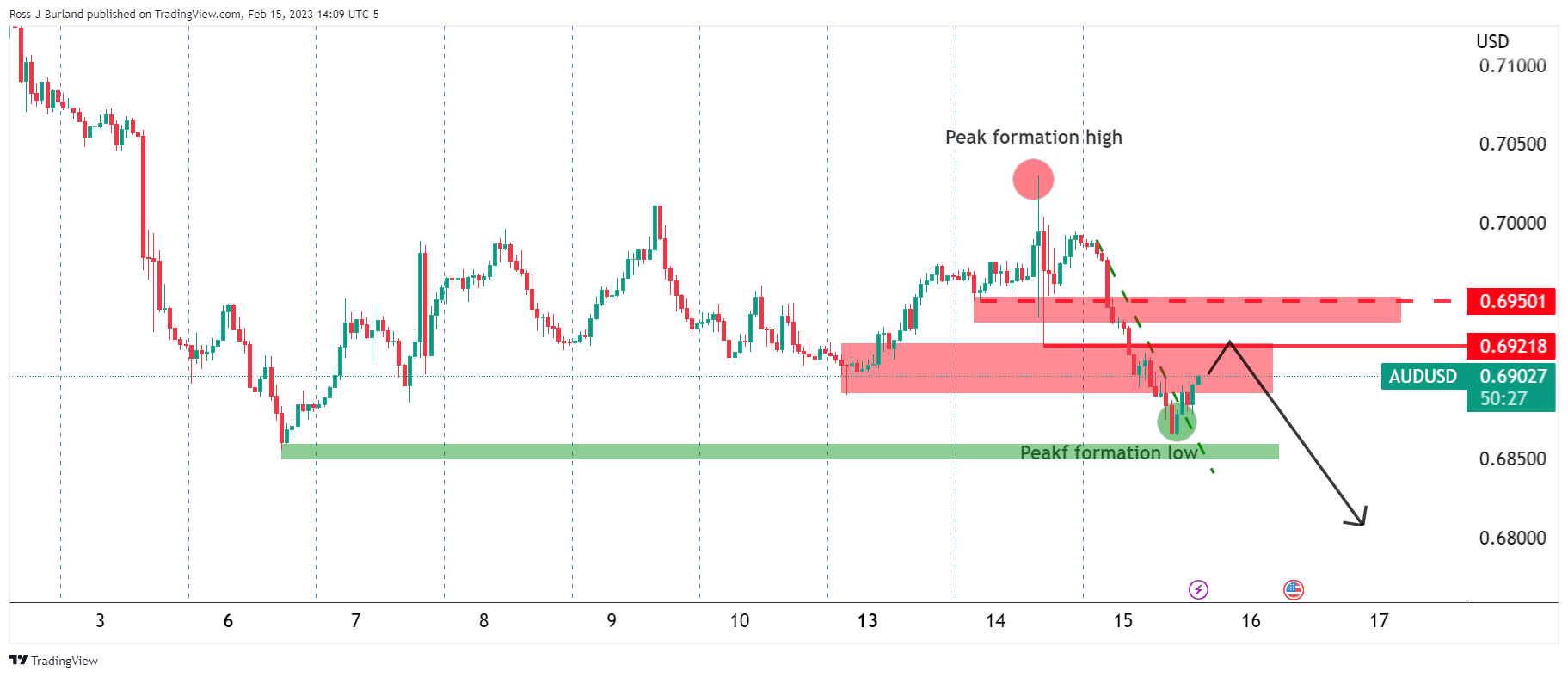
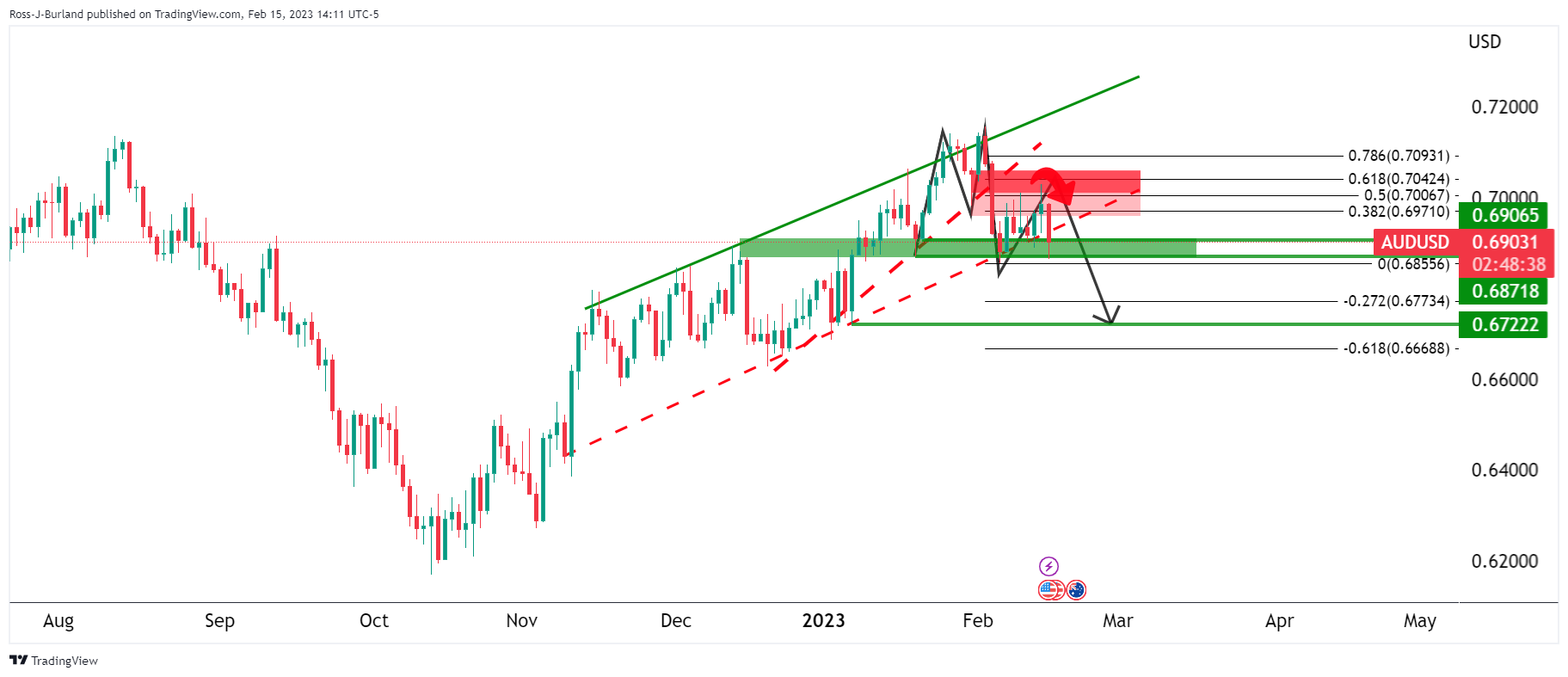
There will be probabilities of a much deeper breakout with 0.6720 eyed at the extreme as per the daily chart.''
About Aussie Employment report
The Employment Change released by the Australian Bureau of Statistics is a measure of the change in the number of employed people in Australia. Generally speaking, a rise in this indicator has positive implications for consumer spending which stimulates economic growth. Therefore, a high reading is seen as positive (or bullish) for the AUD, while a low reading is seen as negative (or bearish).
| Index | Change, points | Closed | Change, % |
|---|---|---|---|
| NIKKEI 225 | -100.91 | 27501.86 | -0.37 |
| Hang Seng | -301.59 | 20812.17 | -1.43 |
| KOSPI | -37.74 | 2427.9 | -1.53 |
| ASX 200 | -78.7 | 7352.2 | -1.06 |
| FTSE 100 | 43.93 | 7997.83 | 0.55 |
| DAX | 125.78 | 15506.34 | 0.82 |
| CAC 40 | 87.05 | 7300.86 | 1.21 |
| Dow Jones | 38.78 | 34128.05 | 0.11 |
| S&P 500 | 11.47 | 4147.6 | 0.28 |
| NASDAQ Composite | 110.44 | 12070.59 | 0.92 |
- USD/JPY consolidates recent gains at the six-week high, snaps three-day uptrend.
- Japan trade deficit for January improves as imports ease, exports grow.
- US Treasury bond yields refresh multi-day top as US data propel hawkish Fed bets.
- BoJ concerns remain upbeat as well amid more hawks in new leadership board.
USD/JPY takes offers to refresh intraday low while paring the recent gains around the highest levels in 1.5 months, down 0.25% on a day near 133.80 as Tokyo opens for Thursday. In doing so, the Yen pair prints the first daily loss in four amid upbeat Japanese trade data and fresh calls for hawkish moves from the Bank of Japan (BoJ). Even so, the hawkish concerns surrounding the Federal Reserve (Fed) join strong Treasury bond yields to keep the buyers hopeful.
As per the latest Japan Merchandise Trade Balance Total for January, the trade deficit improved to ¥-3,496.6B versus ¥-3,871.5B expected and ¥-1,451.8B prior (revised). The details suggest that Exports grew 3.5% versus 0.8% expected and 11.5% previous readings while the Imports eased to 17.8% versus 18.4% market forecasts and 20.7% prior. Elsewhere, Japan’s Machinery Orders rose by 1.6% MoM versus 3.0% expected and -8.3% prior.
Elsewhere, concerns surrounding the Bank of Japan’s (BoJ) exit from the Yield Curve Control (YCC) policy gained momentum of late as the nominated BoJ Leader Kazuo Ueda has a market impression as the policy hawks.
On the other hand, the US 10-year Treasury bond yields seesaw around a six-week high, marked the previous day, while the US Dollar Index (DXY) bulls take a breather after rising to a 1.5-month top as the key US data hints at a further increase in the Federal Reserve’s (Fed) interest rates. That said, the market’s bets on the Fed’s next moves, as per the FEDWATCH tool of Reuters, suggest that the US central bank rates are to peak in July around 5.25% versus the December Federal Reserve prediction of 5.10% top rate.
On Wednesday, US Retail Sales growth jumped to 3.0% YoY in January versus 1.8% expected and -1.1% prior. Further, The Retail Sales ex-Autos grew by 2.3% in the same period, compared to analysts' estimate of +0.8%. On the same line, the NY Empire State Manufacturing Index for February improved to a three-month high of -5.8 versus -18.0 expected and -32.9 market forecasts. Alternatively, the US Industrial Production marked 0.0% MoM figures for January, compared to analysts’ estimate of 0.5% and -0.7% previous readings, but failed to push back the hawkish bias surrounding the Federal Reserve’s (Fed) next move.
Against this backdrop, Wall Street benchmarks closed with mild gains, following the day-end recovery, but S&P 500 Futures hesitate in following suit. It should be noted that Japan’s Nikkei 225 begins the day on a positive side.
Moving on, risk catalysts and the second-tier US data concerning the housing market, industrial activity and producer prices will be eyed for clear directions but major attention will be given to the central bank chatters.
Technical analysis
A convergence of the one-month-old previous resistance line and the 200-day Exponential Moving Average (EMA), highlights 133.75 as the short-term key support for the USD/JPY traders to watch.
The count down to the Reserve Bank of New Zealand interest rate meeting is under way as it comes together on the 22 February next week to decide on where to set the Offical Cash Rate, OCR.
Contrary to the belief in the markets that the RBNZ needs to continue hiking rates at a rapid pace, KiwiBank says the RBNZ should pause its rate hikes, citing a national state of emergency. The suggestions comeson the heels of Cyclone Gabrielle which is causing huge devastation, especially in Hawkes Bay. The New Zealand prime minister, Chris Hipkins, was expected to travel to Gisborne on Thursday to meet residents and first responders on the ground.
Key notes
The RBNZ should pause next week, as we deal with the devastating impact of Cyclone Gabrielle. The RBNZ can come back in April and resume tightening if required.
Talk of a 50bp, or even 75bp, hike should be sidelined. The comms effort in explaining such a move in the middle of a crisis would be difficult to say the least. And it’s not warranted.
The need to tighten aggressively from here has evaporated. Inflation is peaking at lower levels. And global inflation pressures are abating. Currently at 7.2%, inflation is below the RBNZ forecast of 7.5%. Tthe balance of risks are tilted to the downside. We think the RBNZ should pause next week. Current circumstances warrant caution. But what we think they should do is not what they will likely do. We expect to see a hike, but the discussion should be around 0 or 25bps, not 50 or 75bps,
KiwiBank said in a note today.
Meanwhile, analysts at Westpac Bank said that they expect the OCR to rise by 50 basis points to 4.75% next week. ''Inflation has remained strong, but not quite to the degree that the Reserve Bank was bracing for at its November policy review.''
| Pare | Closed | Change, % |
|---|---|---|
| AUDUSD | 0.69043 | -1.17 |
| EURJPY | 143.384 | 0.36 |
| EURUSD | 1.06879 | -0.46 |
| GBPJPY | 161.425 | -0.36 |
| GBPUSD | 1.20329 | -1.14 |
| NZDUSD | 0.62815 | -0.83 |
| USDCAD | 1.33934 | 0.44 |
| USDCHF | 0.92388 | 0.37 |
| USDJPY | 134.157 | 0.77 |
- US Dollar bulls move in and take out a key level of resistance in the DXY index.
- Fed expectations for a pivot are dwindling on the back of inflationary rumbles in the data.
The US Dollar firmed mid-week to a six-week high against a basket of currencies as measured by the DXY index. The index has penetrated a key 103.80 level on the charts amid risks of higher inflation for longer and the markets flipping the script of the Federal Reserve pivot narrative.
Wednesday'srelease of hotter-than-expected US Retail Sales data was just one of a series of inflationary outcomes from the US calendar in less than a week. Investors are starting to reassess the outlook on the Federal Reserve expecting that they will now have no choice but to keep monetary policy tight for some time to fight stubbornly high inflation, as advocated by hawkish Fed speakers, such as the Fed's John Williams.
The US data showed that US Retail Sales surged 3.0% last month, increasing by the most in nearly two years. This was a huge beat on economists polled by Reuters that had forecast sales would increase 1.8%, with estimates ranging from 0.5% to 3.0%. The full data arrived as follows:
- US Retail Sales Advance (MoM) Jan: 3.0% (est 2.0%; prev -1.1%).
- US Retail Sales Ex Auto (MoM) Jan: 2.3% (est 0.9%; prev -1.1%).
- US Retail Sales Ex Auto And Gas Jan: 2.6% (est 0.9%; prev -0.7%).
- US Retail Sales Control Group Jan: 1.7% (est 1.0%; prev -0.7%).
The numbers came on the heels of the prior day's inflation data whereby the Consumer Price Index cooled only slightly to 6.4% in January from 6.5% in December, the lowest since October 2021 but above market expectations of 6.2%.
The latest Federal Reserve commentary also underpinned that Federal Reserve policymakers largely backed more rate increases. US interest rates have to rise further to ensure that inflationary pressures recede, t. Louis Federal Reserve's President James Bullard said on Tuesday.
'We’re almost into a zone that we could call restrictive - we’re not quite there yet,” Bullard said Wednesday in an online Wall Street Journal interview. Officials want to ensure inflation will come down on a steady path to the 2% target. “We don’t want to waver on that,” he said.
“Policy has to stay on the tighter side during 2023” as the disinflationary process unfolds, Bullard added who has pencilled in a forecast for a rate range of 5.25% to 5.5% by the end of this year.
DXY technical analysis
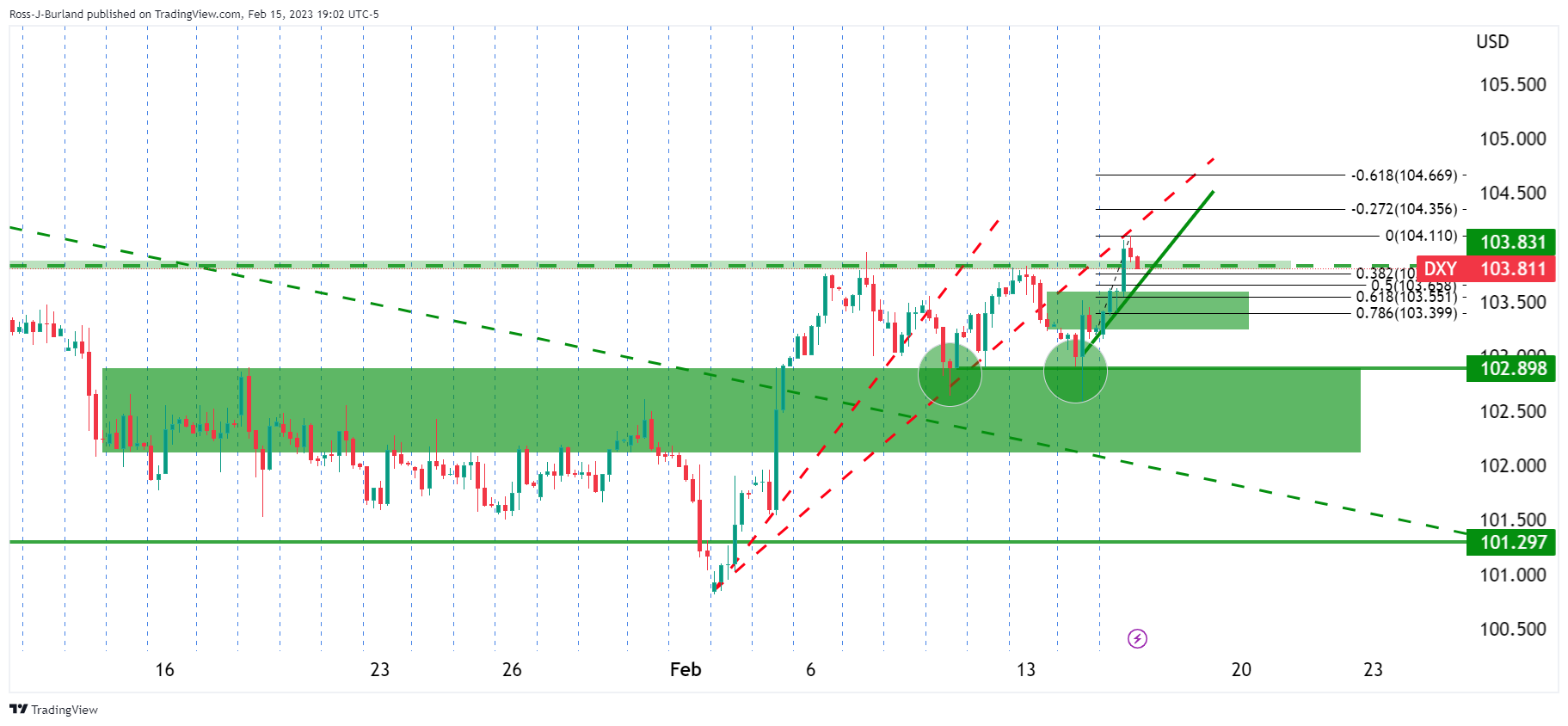
The hourly chart is promising for the bulls but a correction is underway whereby support near a 50% reversion will need to kick in if the US Dollar is going to give off the impressing it is going to stay up for the remainder of the week. If bulls fail to stay involved, then the trendline support could give way as a third dynamic support that has failed since the start of the month.
- USD/CAD remains depressed after reversing from weekly top.
- Bullish MACD signals, upbeat RSI keeps buyers hopeful.
- Symmetrical triangle restricts immediate moves between 1.3450 and 1.3340.
USD/CAD holds lower ground near 1.3390 during early Thursday morning in Asia, after positing the biggest daily gains in a fortnight to refresh the weekly top the previous day.
In doing so, the Loonie pair declines towards the 100-bar Simple Moving Average (SMA) inside a monthly symmetrical triangle formation, currently between 1.3450 and 1.3340.
It’s worth noting, however, that the bullish MACD signals and the firmer RSI keeps the USD/CAD buyers hopeful.
That said, a clear upside break of the stated triangle’s top line, close to 1.3450 at the latest, becomes necessary to convince the bulls.
Following that, a run-up towards the monthly high of 1.3475 and then to a late January peak of 1.3520 can’t be ruled out.
In a case where the USD/CAD price remains firmer past 1.3520, the odds of witnessing a rally toward the year-start top near 1.3685 can’t be ruled out.
On the flip side, a clear break of the 100-SMA, around 1.3370 at the latest, becomes necessary for the USD/CAD bears to keep the reins. Even so, the stated triangle’s bottom surrounding 1.3340 could challenge the Loonie pair’s further declines.
Should the quote remains bearish past 1.3340, it becomes vulnerable to refresh the monthly low, near 1.3260 at the latest.
USD/CAD: Four-hour chart
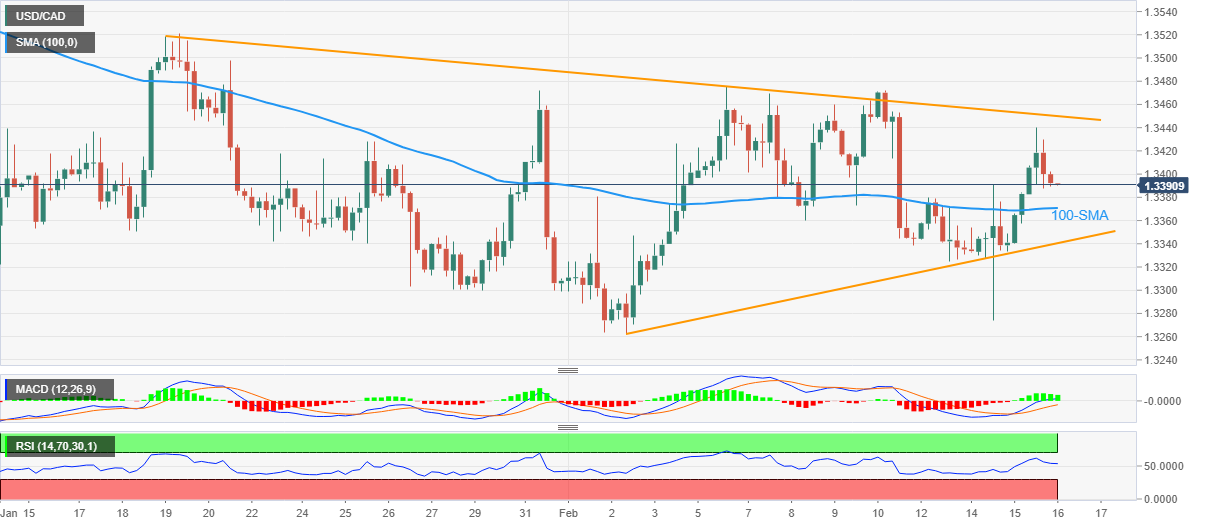
Trend: Further upside expected
© 2000-2024. All rights reserved.
This site is managed by Teletrade D.J. LLC 2351 LLC 2022 (Euro House, Richmond Hill Road, Kingstown, VC0100, St. Vincent and the Grenadines).
The information on this website is for informational purposes only and does not constitute any investment advice.
The company does not serve or provide services to customers who are residents of the US, Canada, Iran, The Democratic People's Republic of Korea, Yemen and FATF blacklisted countries.
Making transactions on financial markets with marginal financial instruments opens up wide possibilities and allows investors who are willing to take risks to earn high profits, carrying a potentially high risk of losses at the same time. Therefore you should responsibly approach the issue of choosing the appropriate investment strategy, taking the available resources into account, before starting trading.
Use of the information: full or partial use of materials from this website must always be referenced to TeleTrade as the source of information. Use of the materials on the Internet must be accompanied by a hyperlink to teletrade.org. Automatic import of materials and information from this website is prohibited.
Please contact our PR department if you have any questions or need assistance at pr@teletrade.global.
